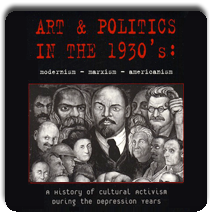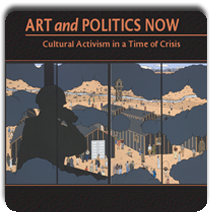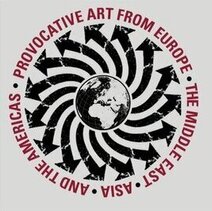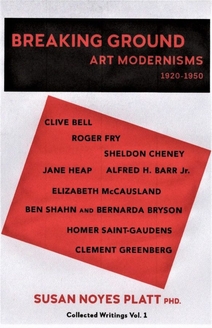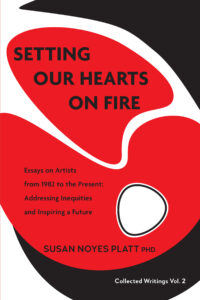Elizabeth Gaskell and the politics of workers and women in the 19th century
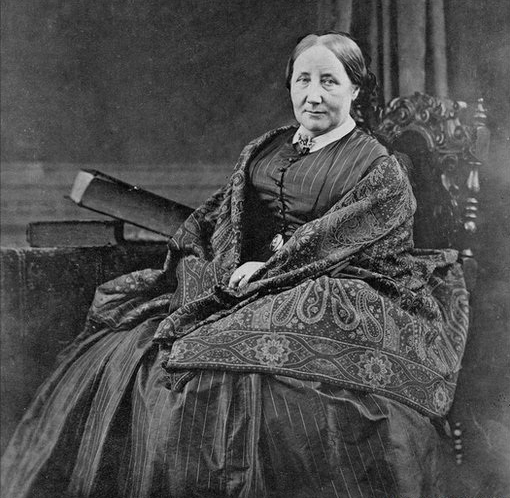
During the six weeks that I have been recovering from my hip replacement surgery, I have been reading and listening to the novels of Elizabeth Gaskell. First I listened to Ruth, then read Wives and Daughters, and finally Mary Barton. It turned out that Ruth is a midcareer book, 1853, Wives and Daughters at the end of her life, left unfinished 1864-5, and Mary Barton her first novel, 1848.
She is best known for North and South, which I read a long time ago, and Crandell, also a BBC series, which I found less compelling than the three above.
As a married Victorian writer ( she was married to a Unitarian minister who worked with the poor, an important fact that contributed to her insights.) Gaskell had six children, half of whom died. The death of her second child led to her novel Mary Barton.
I was riveted by this novel. the characters are vivid, the plot intense ( so intense that I had to listen to it in little bits to avoid being overcome with anxiety), the politics beautifully incorporated into the narrative. It was written the year that Marx published his Communist Manifesto. In the novel, not only does the heroine avoid becoming a fallen woman by her own insight, but she saves her lover from being hung for murder. But the real confrontation in the novel set between 1838-42 in Manchester at the time of the beginning of the Chartist movement (featured also in the miniseries Victoria on Netflix now), is between the working class and the owners of industry. At first it is a march to London to ask for improvement of the horrible conditions of poverty of the working class, then it is a strike with a demand for more pay, then it is an act of revenge against oppression, and in the end it is an amazing communication between an articulate impoverished man and the owner of a foundry whose son has been murdered in revenge for oppression. This exchange ends with their shaking hands, a symbol of communication between workers and owners, and as Gaskell states so eloquently, the grief of the owner at the loss of his son is then channeled into advocating reforms for workers.
Ruth is about a woman who does fall, but then by good luck is saved, by a dissenting minister. She is eventually found out, and shunned as is her son, and she ends as a nurse to those dying of the plague, finally catching it and dying as a result from the man who brought her downfall.
Wives and Daughters is different kind of book. I read the praise for this late work as her “best work” but I disagree. It is focused on the very subtle gradations of difference in class in a small town, micro differences, indicated by behavior, politics, dress, and social customs. It was fascinating ( and also had a strong female heroine), but I found Mary Barton as the real powerhouse story. Gaskell is a later generation than Austin, and I find her much more compelling because she incorporates the politics of the oppressions of the working class and womens vulnerability to downfall and strength to survive into her stories.
If you want a good read this winter turn to Elizabeth Gaskell.
Charles Dickens admired her and published her work in his magazine Household Words, but if you look at her career, it is amazing how many magazines were available for publishing at that time, and how much she published.
PS I just read that mothers tend to not appear in Victorian novels, and it is true, none of the female heroines in Gaskell have living mothers, one has an unfortunate stepmother.
This entry was posted on February 2, 2019 and is filed under Uncategorized, Victorian fiction, Women Artists.
Martin Luther King Day 2019
Martin Luther King said it all
“A Nation that continues year after year to spend more money on military deense than on programs of social uplift is approaching spiritual death.”
As our government shutdown was going on and on, and ordinary dedicated Federal employees Americans were standing in line at food banks, the outpouring of love at the MLK March was deeply inspiring.
Before the march I went to a workshop on understanding Hate Groups which had some amazing statistics on reporting and non reporting of hate crimes. This is how it was described.
The Truth About Hate Groups and Hate Crimes.
It’s time to take affirmative action against hate. This workshop examines how white supremacists and neo-Nazi groups proliferate. Bias crimes go unreported. Mainstream media cover only the most violent offenses. FBI hate crime statistics are inaccurate. The result: communities get a false sense of security. In this workshop you’ll learn about how malicious harassment cases are – and aren’t – reported. Participants will learn how radical right organizations recruit and retain members, why defectors abandon the movement, and what their stories tell us about stopping hate. The session will end with individual action plans to “stop hate in your own community.”
Presenter: Former civil rights reporter Lonnie Lusardo is a cultural competency professional and author of From Hate to Compassion: How Seven Former White Supremacists Transformed Their Lives, due for publication in 2019.
Then the March came with its powerful multiracial, multi ages message of love and resistance.
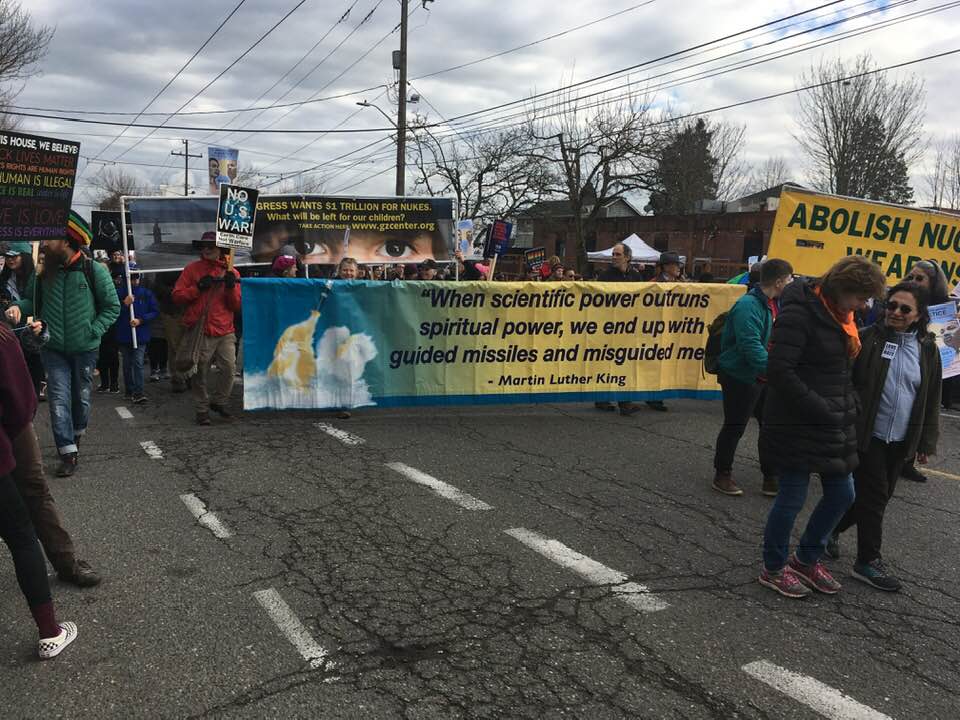
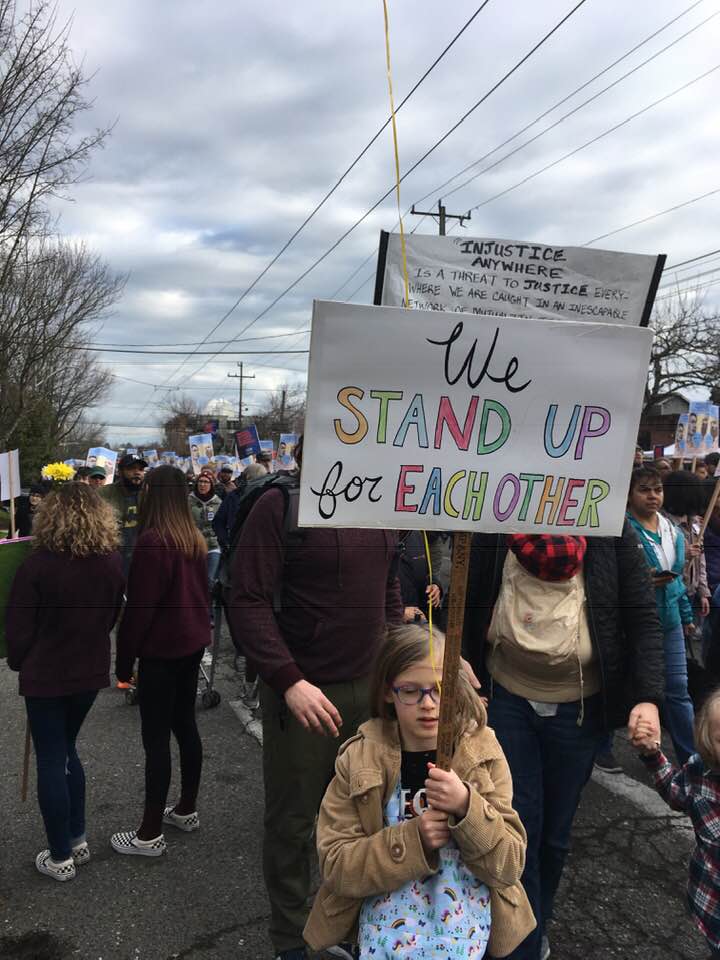
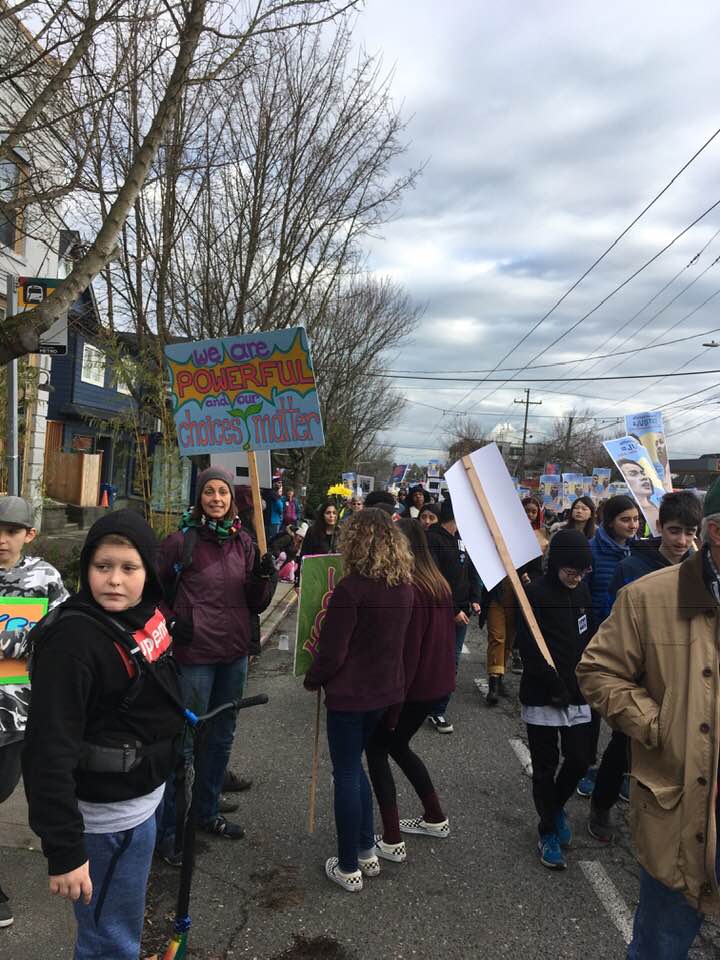
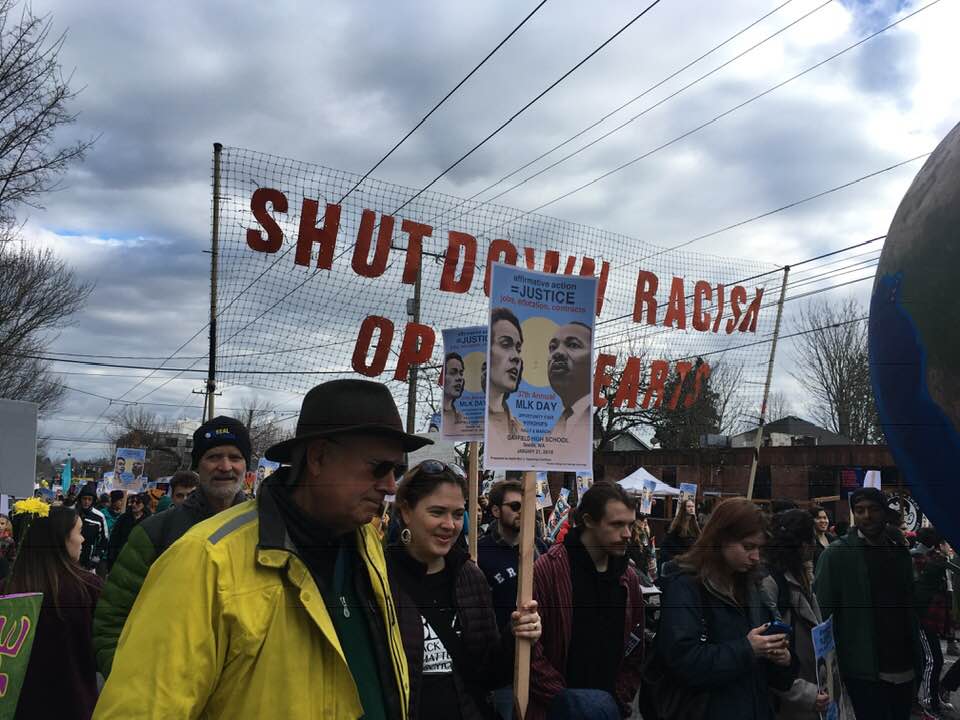
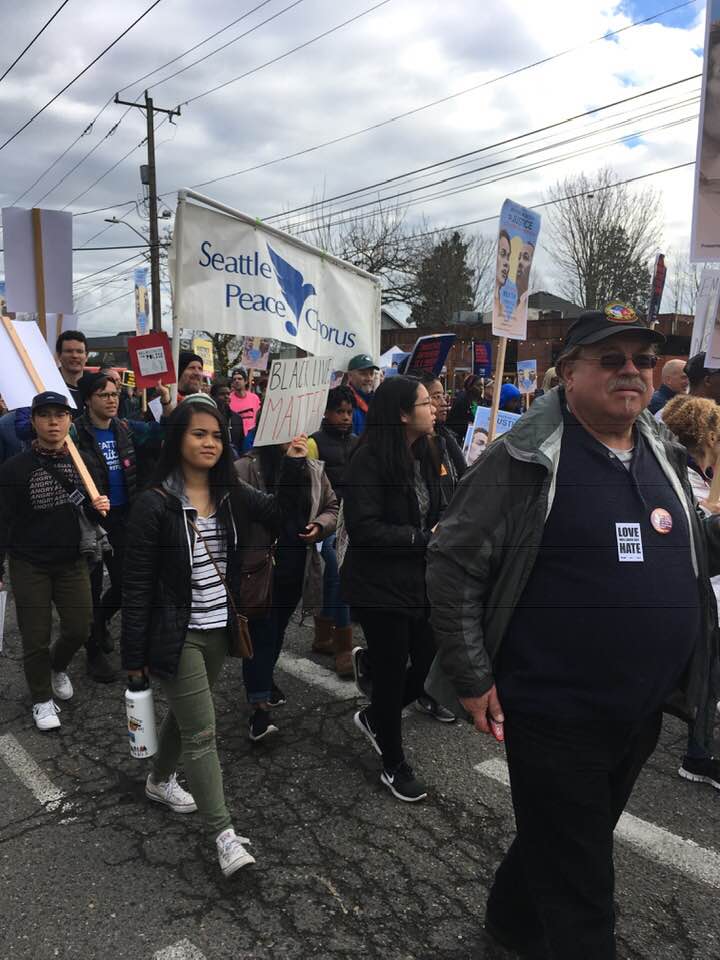
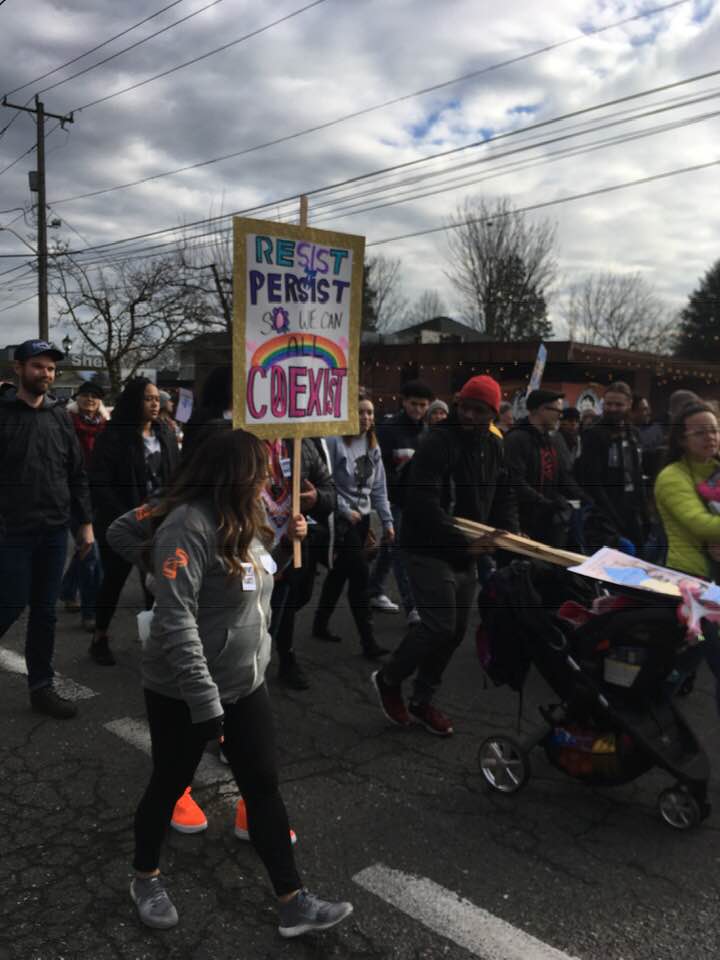
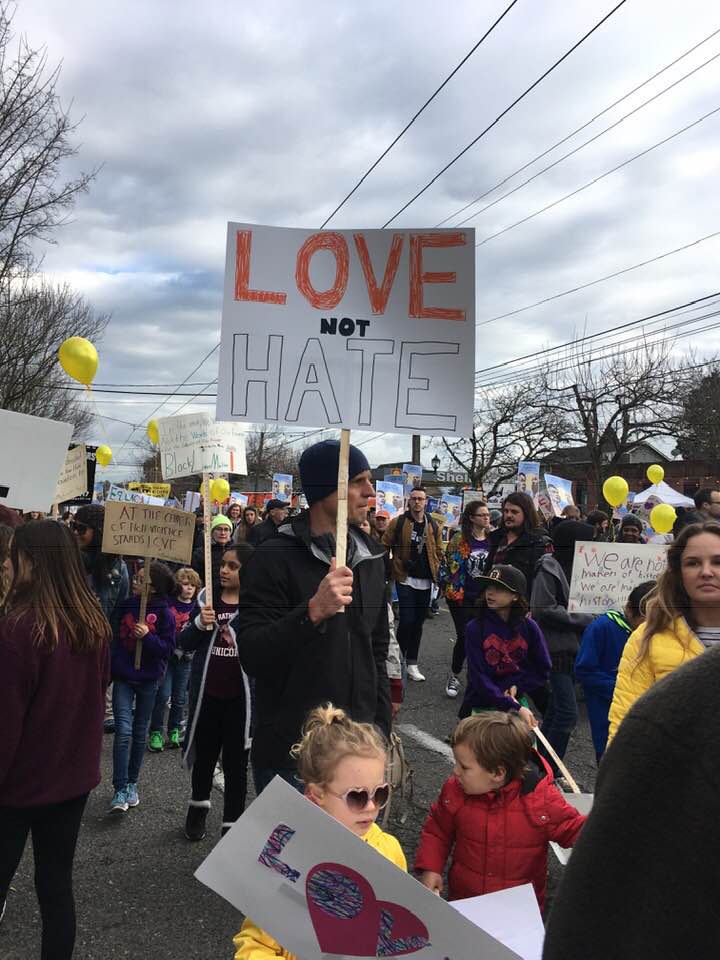
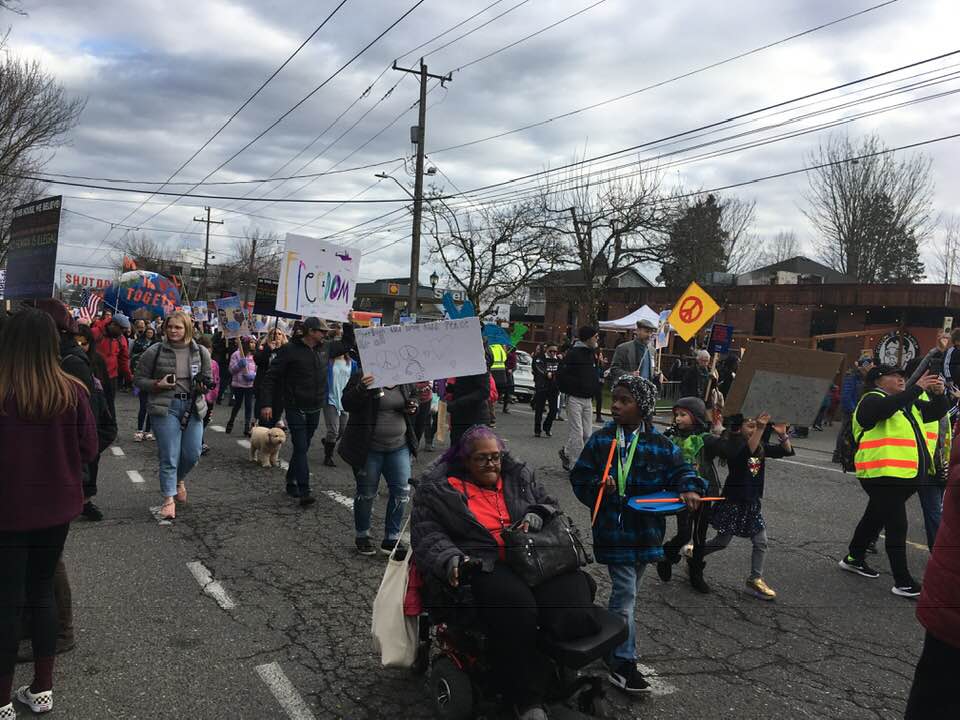
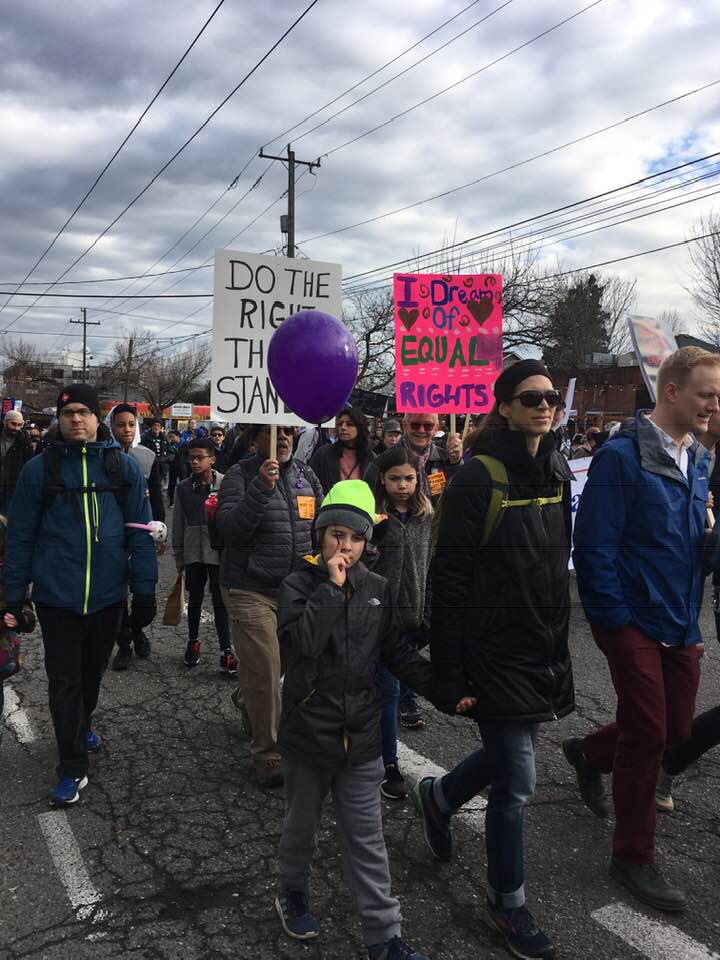

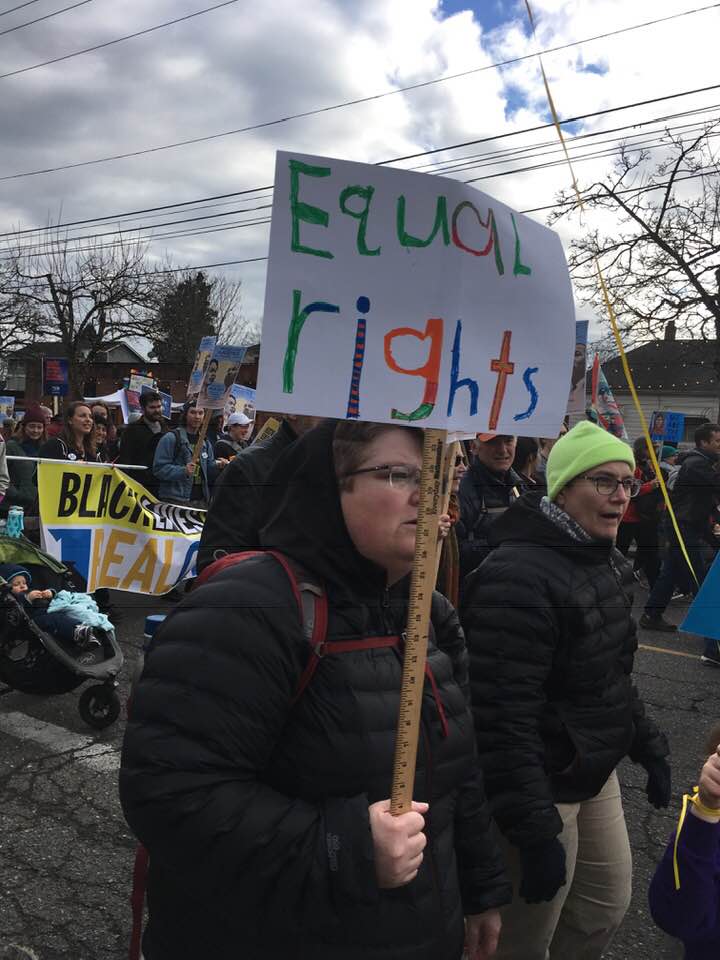
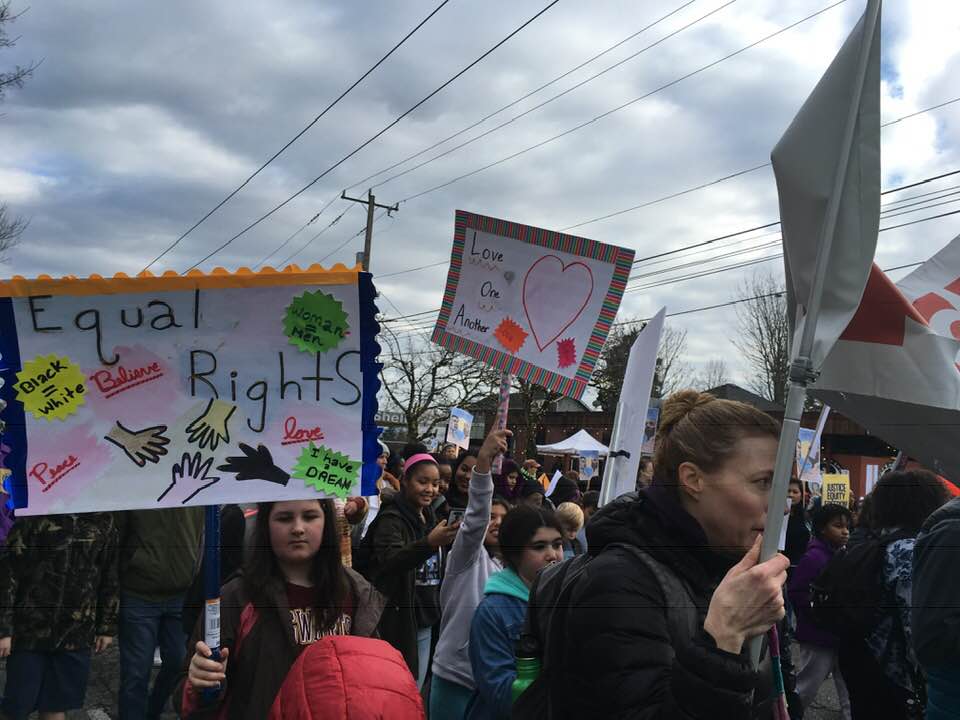
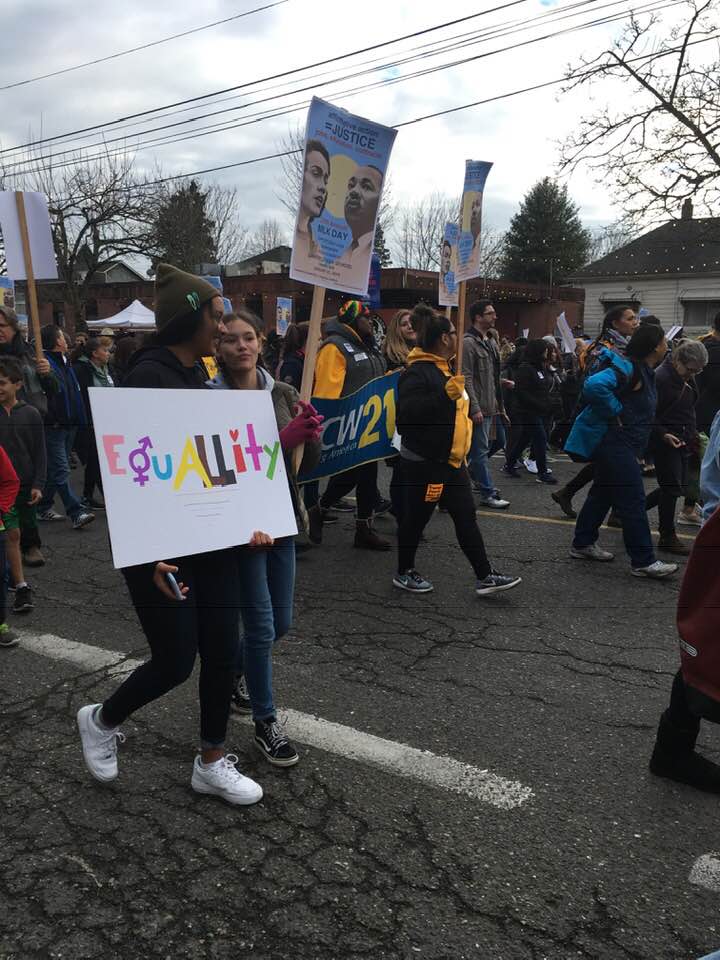
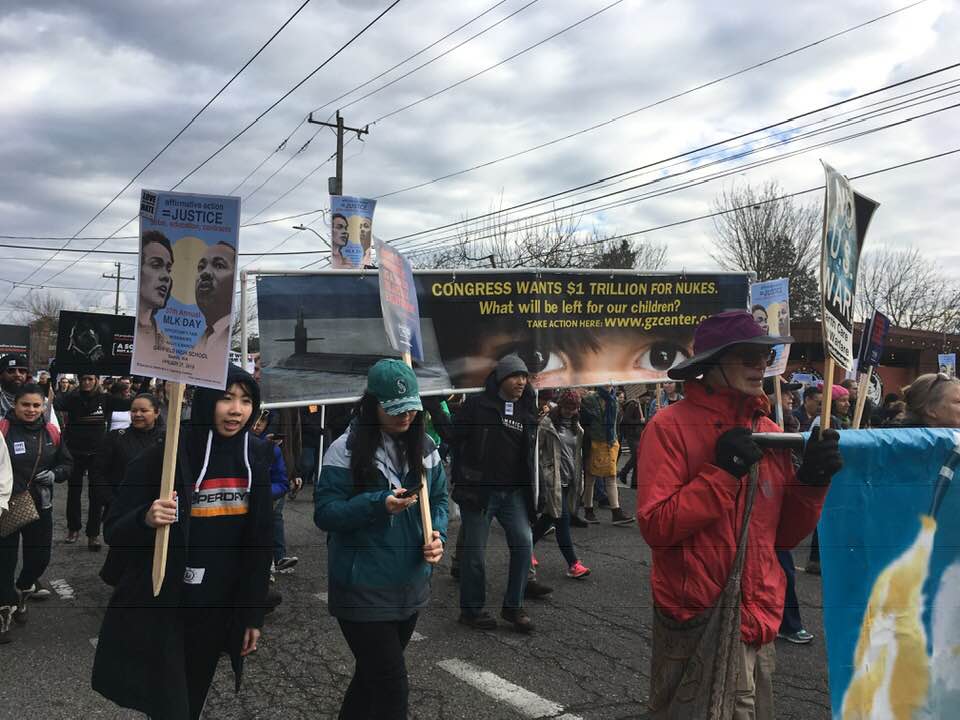
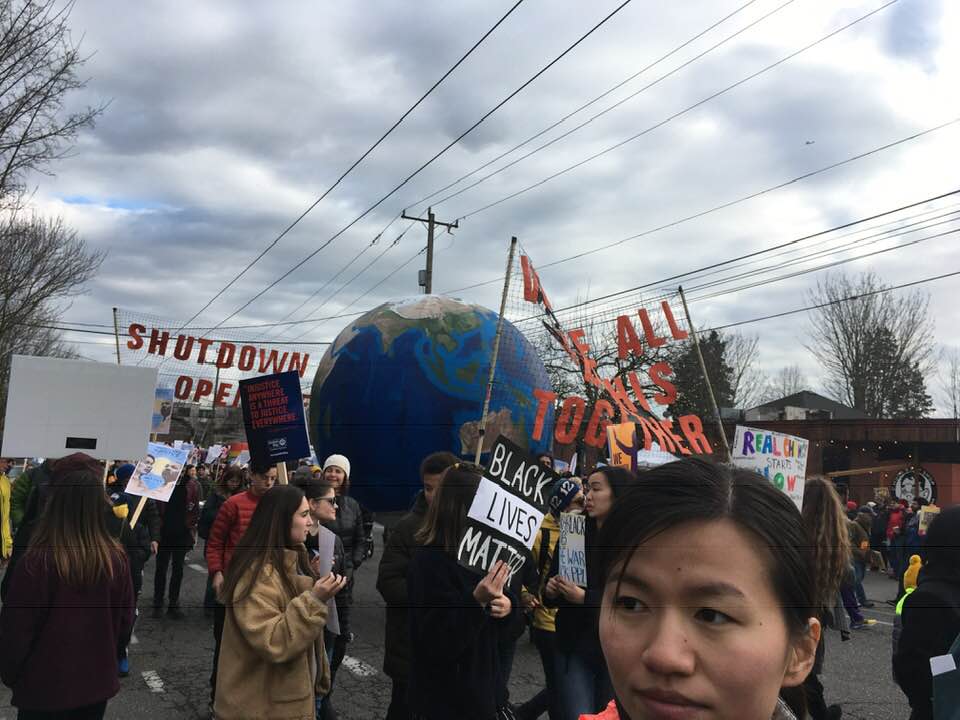

This entry was posted on January 28, 2019 and is filed under Uncategorized.
Jack Whitten’s Odyssey: A New Perspective
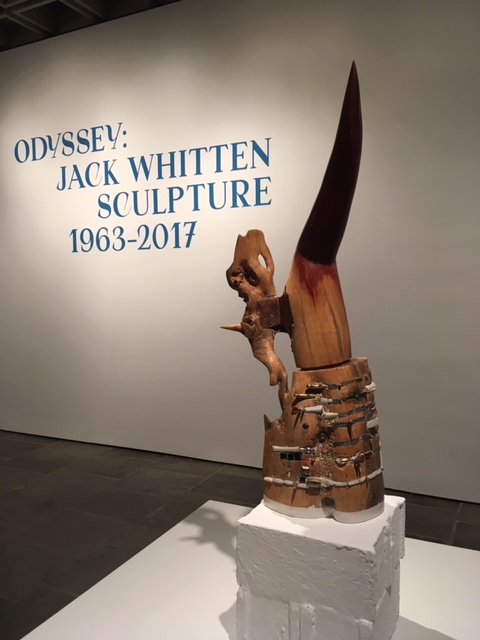
Jack Whitten made his name as an abstract painter in New York City beginning in the 1970’s and had a solo exhibition in 1974 at the Whitney Museum! During the 1960s and 1970s in New York City he was friends with musicians, poets, writers, and other artists. It was a time of mixing media, but he made a name for himself as a painter of large abstract canvases that were purchased by the likes of the Metropolitan Museum of Art and the Whitney Museum of American Art.
One publication stated at the time of his death
“And as a black artist, he resisted the period’s prevailing impulse of racial representation to explore the plastic and metaphorical possibilities of paint.”
Artsy Editors Jan 23, 2018
I will return to this point at the end of the post.
Other artists honored Whitten with these words:
“Jack would preach that art was one of humanity’s last bastions, and abstraction was where we as black artists could truly be free.” Shinique Smith, artist
“Whitten was always trying to find a celestial dimension in the most prosaic materials.” Massimiliano Gioni, curator
“To talk to Jack was to recognize the beauty and richness of existence, the possibility in even the dimmest times.”
Andrianna Campbell, curator
alll quotes from Artsy Editors Jan 23, 2018
All of these quotes about Jack Whitten as an abstract painter, as well as frequent references to his experimentation with materials give insight into his current exhibition of his sculpture at the Met Breuer .
It is astonishing that they have never before been shown except in small exhibitions in Greece. The sculptures reveal an intricate and layered mind, that brought together the cultures of Africa and Europe on the South coast of Crete, where he lived part time starting in the 1970s. Because I have spent quite a bit of time in Greece, I loved these sculptures. They were stunningly original, lovingly created from various materials, both found detritus and beautifully worked woods, and suggest a calm inner joy that is balanced and exuberant at the same time.
At the entrance to the exhibition (see top of post) stood Lichnos, 2008. The name refers to a “spiny bottom-dwelling fish,” used in “a Greek Fisherman’s stew.” Composed of specific types of wood, carob, black mulberry, the piece is set on a pedestal of whitewashed concrete cinder blocks that immediately made me think of the whitewashing my sister-in-law in Greece does to her house every year. It is the same lime wash used here. What stopped me in my tracks is the huge creative eccentricity of the piece, the juxtaposition of unlike parts to make an assymetrical whole. The stringy character of carob wood makes it hard to carve, echoing the challenge of catching the Lichnos.
There are more references here embodied in the found 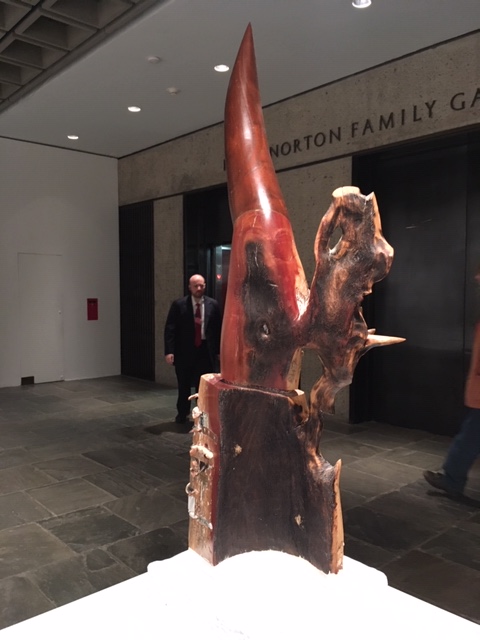
materials, to Africa, to Alabama. And as we walk around the work it seems to be a strange beast seeking to escape confinement. The stunning polished red colored carob wood is flame like.
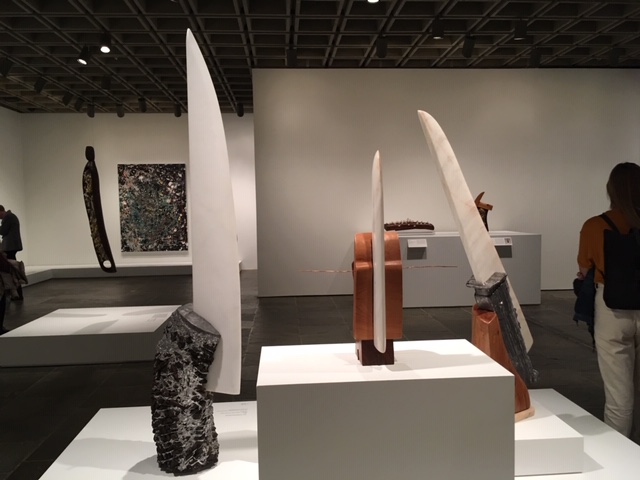
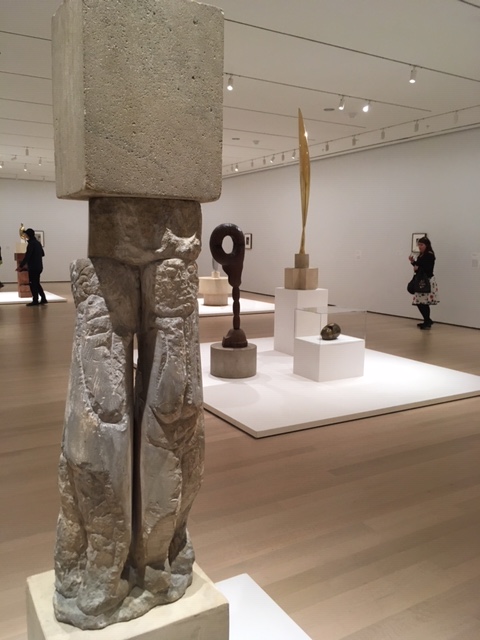
These two installation shots suggest one of Whitten’s inspirations must have been Brancusi (the lower installation is a small show at the Museum of Modern Art). We see the same exploration of materials, of the base, of meticulous aesthetics, of elusive content.
But he is absolutely original, a word I rarely use (nor do I often write about abstract art.) But I strongly felt the layers of content in these works bringing together so many different traditions, mythologies, types of knowledge.
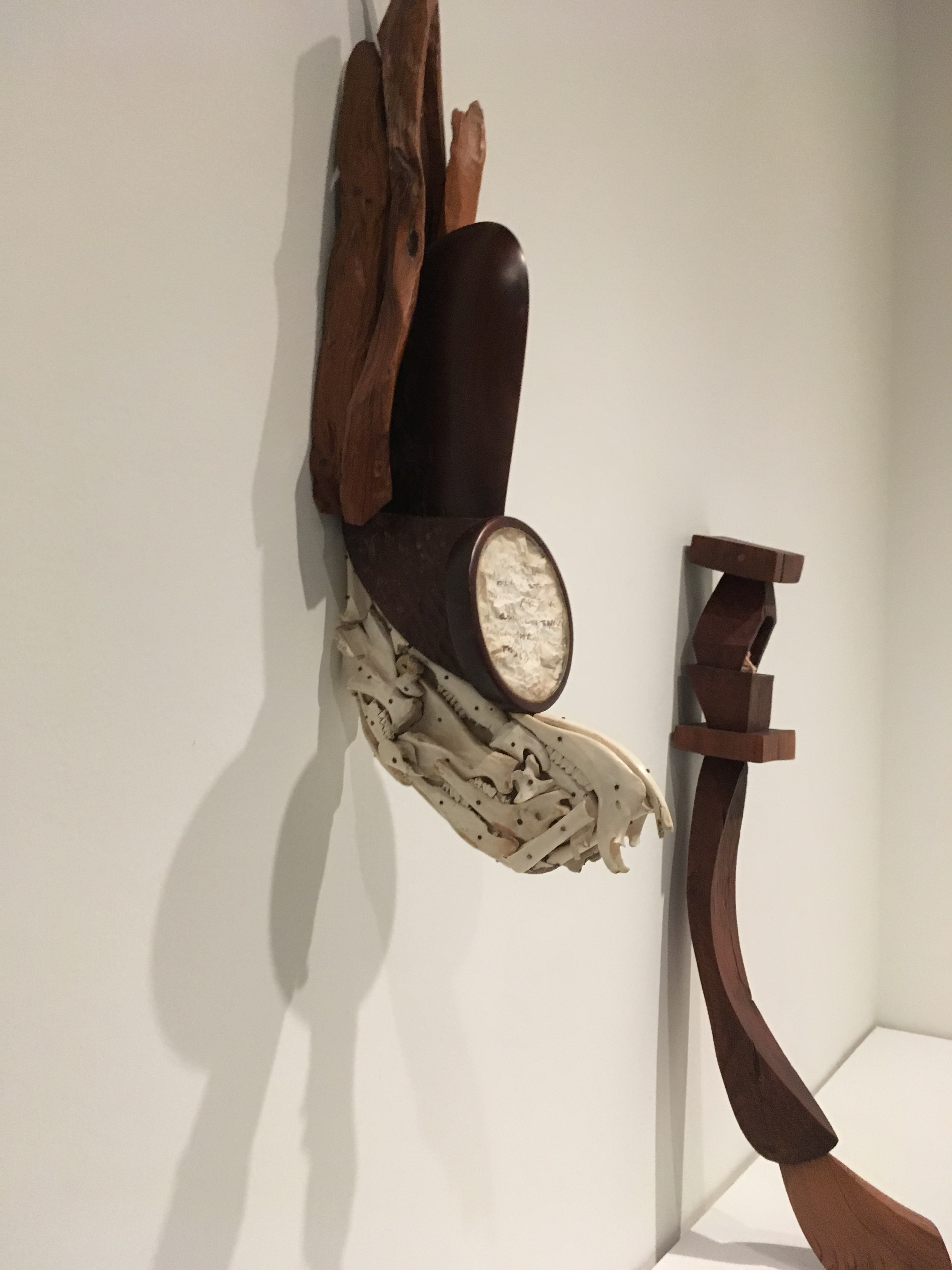
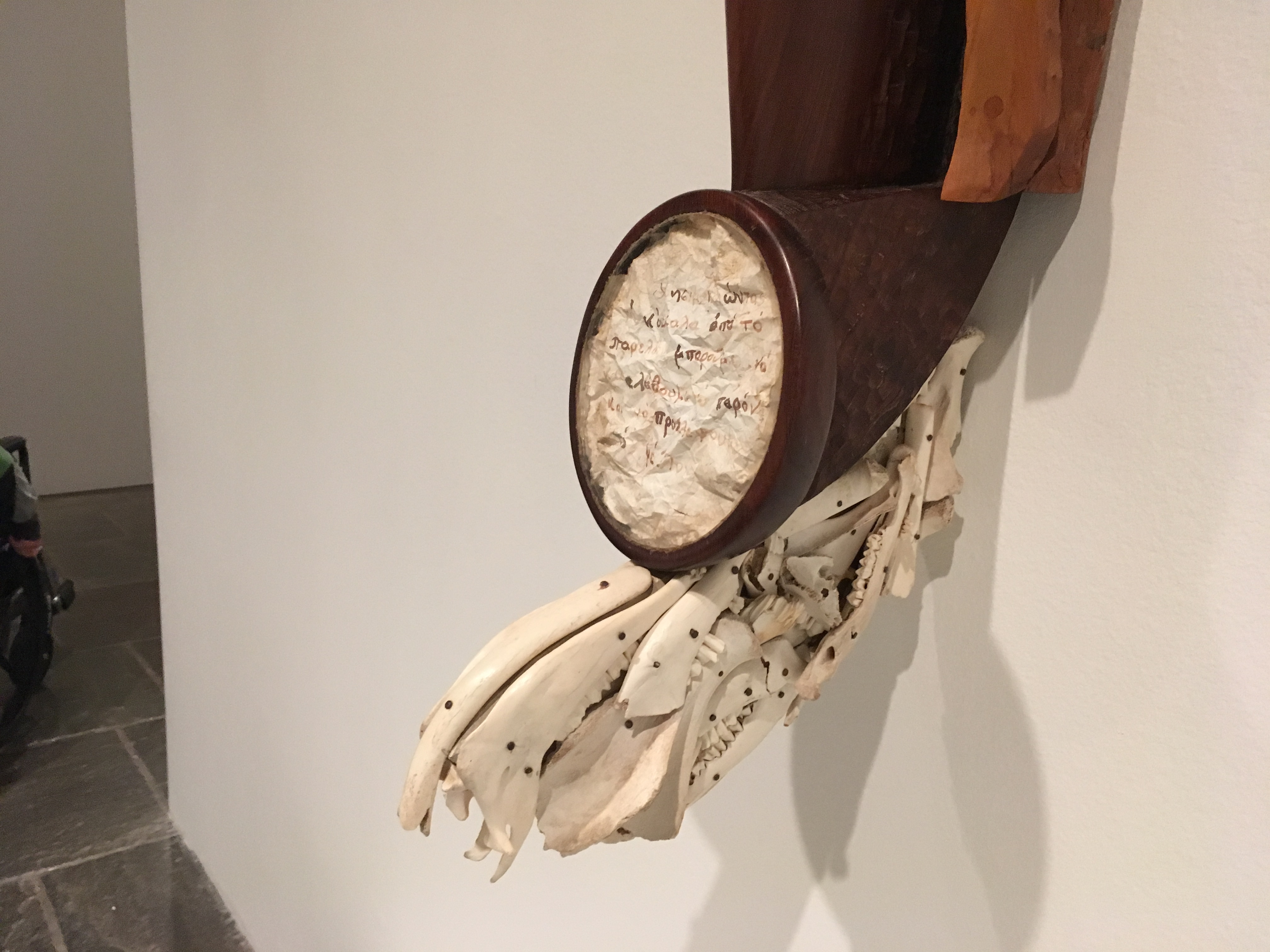
Phoenix for the Youth of Greece, 1983 is one of the earlier sculptures. It includes mulberry wood, olive wood, bone, glass and a small piece of writing. Underneath is an”ossuary”, cluster of bones made of jaws of small fish and above a mysterious parchment with the phrase
“Using the bones from the past, we can understand the present and foresee the future.”
The soft olive wood frames the hard shiny mulberry.
But all of these materials suggest a larger story or myth, illusive, but still very present.
In addition to the layers of mythology in the sculpture, another series of work, the “monolith series” payed homage to great African Americans, in a medium that Whitten developed, hand made acrylic tiles: these stunning works, shimmer in the light, as the “portrait” emerges from its surfaces. But again, they are basically abstract works, with homage to such people as Chuck Berry, James Baldwin, Eduard Glissant, Terry Adkins and Mohammed Ali. The one below is to Chuck Berry. (Black Monolith XI Six Kinky Strings: For Chuck Berry)
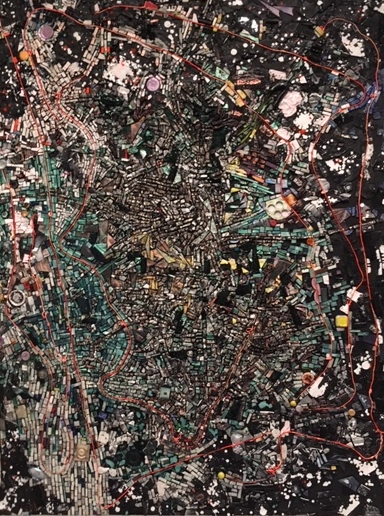
The riveting complexity of the surface evokes music, and certainly that is another crucial reference point for Whitten.
It is exciting to be confronted with a body of work by a well known artist that has never been shown before. All of these works are a revelation. Here is the Tomb of Socrates.
with wild cypress, black mulberry, marble, brass and mixed media
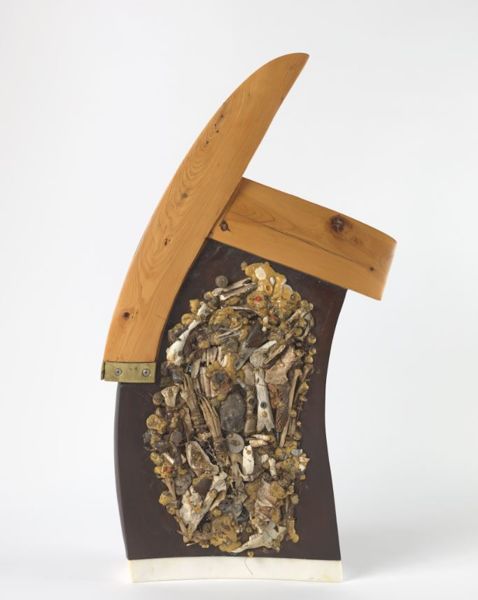
It is shaped like a shield, with all sorts of found materials . At the center is a black stone that suggests the philosophers skull. As we know Socrates died by drinking poison because a new political order ganged up on him and declared him dangerous. We need this piece today to remind us of what happens when governments reject knowledge.
Why have these sculptures never been shown before? I came up with the idea of logistics. They were all made in Greece, they are fragile, they are embedded in that landscape, that history, mythology, that geography, not far from Africa. Perhaps Whitten felt he wanted them to stay there, whereas his abstract paintings are very much a part of US American post World War II world.
He was one of a handful of African American artists to succeed throughout his life in the mainstream. Was he simply better than those who have less recognition, or was he less threatening because he did not pursue political content. Thinking about the tone of approval in the quote at the beginning of the article, abstraction was certainly more illusive as a means of speaking than the unavoidable imagery of a Charles White ( who was also successful, but in a different arena) .
But I will say that for Whitten it was not only what was in style, it was definitely not because he wanted to hide behind it in order to be safe. Abstraction worked with his abstract way of understanding the world. His abstraction is not an empty gesture, it is an act based on wide ranging exploration of ideas.
Based on the homages quoted above , it is clear that he was held in a certain amount of awe by his colleagues and fellow artists. I wish I had known him. Perhaps I would know the answer to my question.
There is no doubt though that he was deep, poetic, and incredibly willing to take chances. He came from deep poverty in Alabama in the 1940s. His father died when he was five, his mother left with seven children to raise alone. She must have been a remarkable woman. He went to segregated schools but was already interested in shop and music. But what a leap to end up as a major painter in New York City already in the early 1960s.
So the mystery of life and success remains, is it initiative, luck, mentoring, perseverance, charm, talent. We know that for a black man in the art world of the 1960s and 1970s in New York City, brains alone was not enough. The fact that his experiment with materials fit with what was acceptable at that time is a conjunction of time, place, person, inclination. He may also have been just lucky in his timing.
Late 60s and early 70s the art world was shifting from its exclusive focus on white men making abstract paintings, but diversity was not yet established as a crucial consideration ( it still isn’t). He slipped in then, and off he went.
But to return to the sculptures, which I can’t help feeling are his greatest art. Why were they never shown? Because they didn’t “fit” what the art world wanted? Or because he saw them as personal and informal explorations. I want to believe that he saw them as an ongoing exploration, a synthesis of all his ideas. They were not ready for the world until after he died.
Thank goodness we have them now.
This entry was posted on November 3, 2018 and is filed under African American fiction, African American history, Uncategorized.
Charles White: Humanist
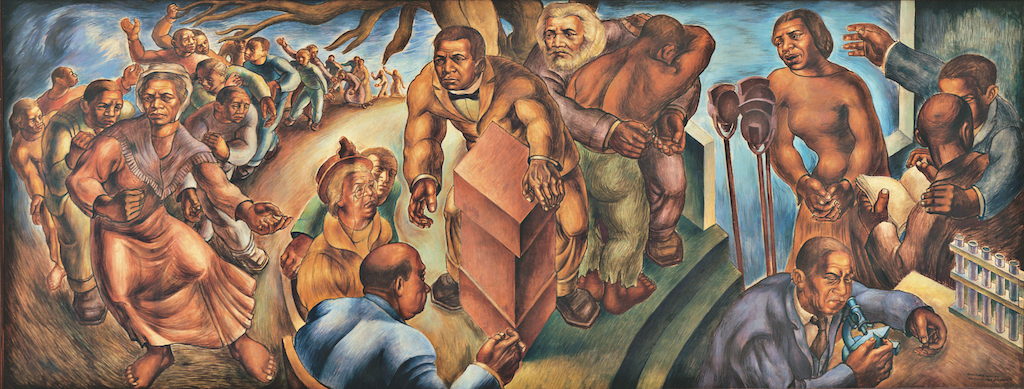
The huge mural by Charles White, “5 great American Negroes” overwhelms us before we even enter the Charles White retrospective at the Museum of Modern Art in New York.
In this first mural Charles White created for the government sponsored WPA mural program, Sojourner Truth leads a march of freed slaves that recedes into the background in a tapering curve on the left. In the center, Booker T. Washington promotes his famous Tuskagee College to potential benefactors standing at a lectern with Frederick Douglass behind him holding a grieving slave. In the right foreground, George Washington Carver peers through a microscope and behind him Marion Anderson performs against a blue sky; the two are linked by a young man reading and a mentor pointing dramatically toward a future.
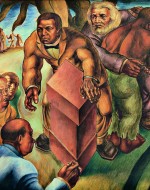
In the mural White has successfully juxtaposed carefully observed portraits of well known African Americans by placing them in a succession of deep and shallow space. Portraiture and powerful black bodies, with a particular emphasis on hands and gestures, characterize much of his work throughout his career. Four other murals during these years, are represented in the exhibition by studies and sketches such as the vivid detailed carbon pencil over charcoal portrait of Paul Robeson. We see Robeson as a powerful but troubled person, a brilliant talent and political activist who payed a heavy penalty for that during the McCarthy era.
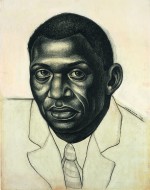
The stunning Charles White retrospective at the Museum of Modern Art foregrounds the artist’s deep commitment to presenting the humanity and dignity of African Americans. He died young (1918 – 1979) at age sixty one, and saw profound changes in the US and his own life, but he always followed his own vision
“For me, the thing that matters most is not the form per se, but the depth of the content. I may experiment with new compositional forms, but my chief concern is always with expressing a particular feeling or emotion.”
In his earliest years as an artist in the 1930s, as with many African American artists who became prominent after World War II, the WPA programs provided professional acknowledgement, the support to make art, and a sense of community. African American artists who joined the federal programs were often self educated in art in public libraries and classes, also sponsored by the WPA. The artists in Harlem and Chicago had a community of supportive musicians, poets, writers and visual artists which proved invaluable in their early development.
More rural artists especially in the South were isolated before the government programs began, excluded from white public libraries and access to any art training. The community centers and art schools the government sponsored provided both jobs and a sense of personal support. I am thinking here of the less famous, but also extraordinary James W. Washington,Jr. who joined the WPA program in Gloster Mississippi, based entirely on his own study and survival skills in the Jim Crow South. He went on to have a successful career as a sculptor in the Northwest.
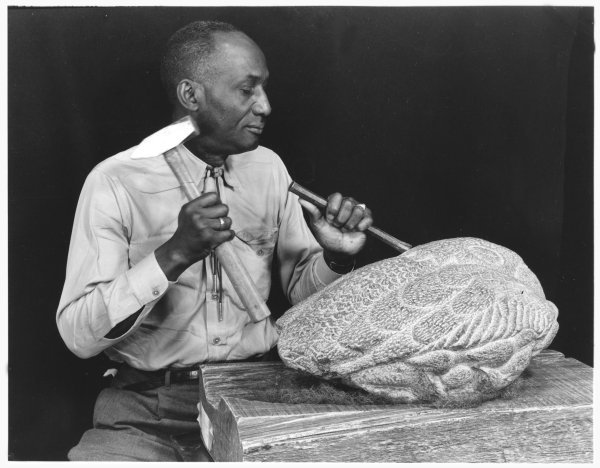
As I looked at White’s portraits, as well as his anonymous individual figures, I could feel the challenges that these people overcame, I could feel their anger, and their hopes, their poignancy and power, resilience and resistance, strength and dignity.

White declared “I like to think that my work has a universality to it, I deal with love, hope, courage, freedom, dignity – the full gamut of human spirit. When I work, though, I think of my own people. That’s only natural. However, my philosophy doesn’t exclude any nation or race of people.”
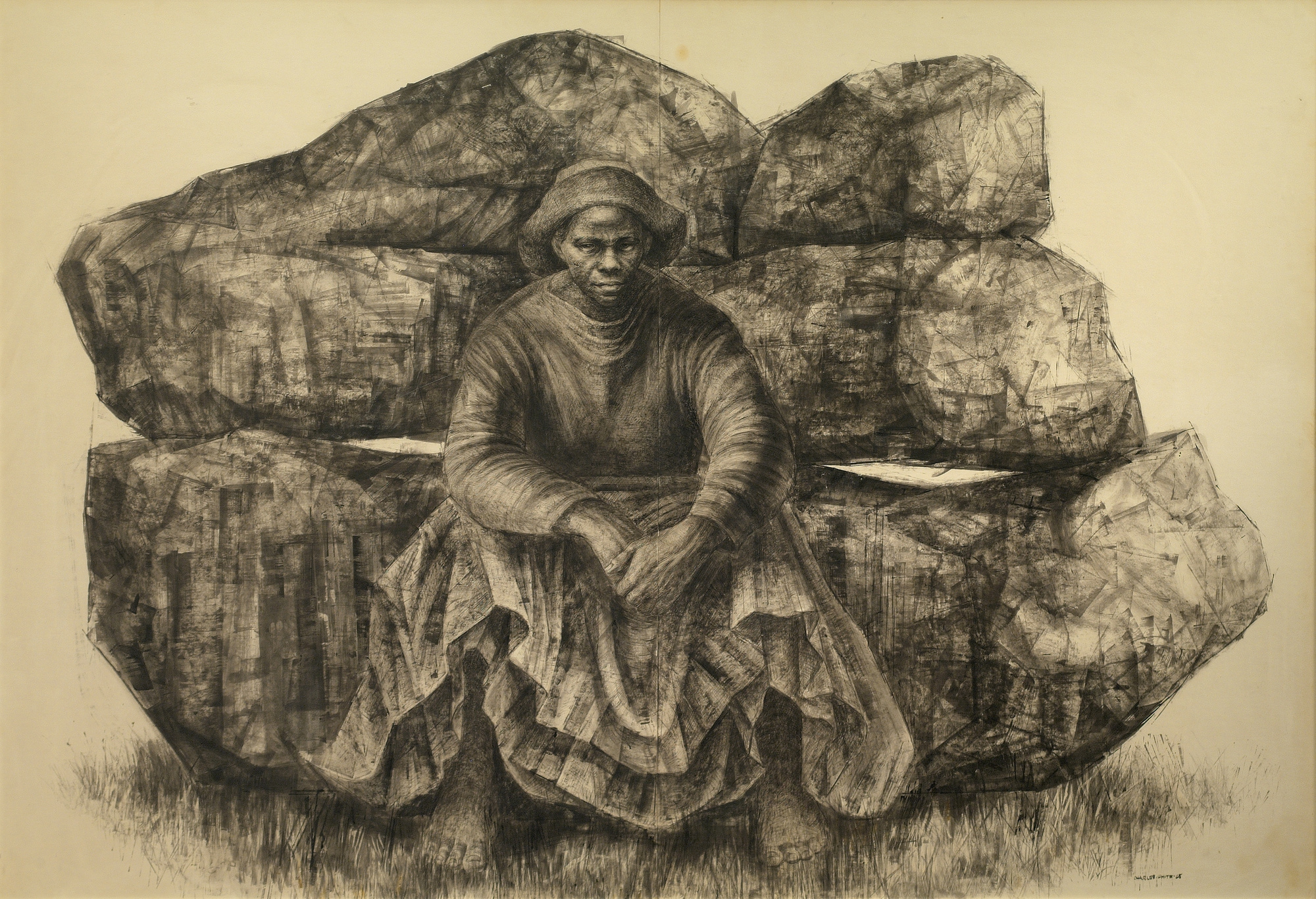
During the 1960s White’s work altered dramatically. His drawings became much larger, dominated by a single figure. General Moses (Harriet Tubman) 1965 sits legs apart, with arms on her knees, hands crossed in front, her expression one of anger. She sits in front of a wall of massive rocks cut unevenly (and brilliantly rendered by White). This work created at the height of the obsession with abstraction in American art, defies us in every way and the large figure defies the world.

In 1966 White created several large figure drawings with the title J’Accuse, based on the anti semitic Emile Zola drama in 19th century France. Each of the five works suggest different emotions. In this drawing we have the enigmatic African mask carried on a woman’s head covered with grass and swathed in a voluminous robe. We see her immense strength in the voluminous robe and determined expression, even as the African sculpture gives her spiritual power that alost seems to lift her up.
White stayed with the figure, increasingly embedding it in a large textured surface. The complex drawing awes us with his mastery. The figures engage the interior lives of people challenged by life. They honor resistance to oppression through strength and love.
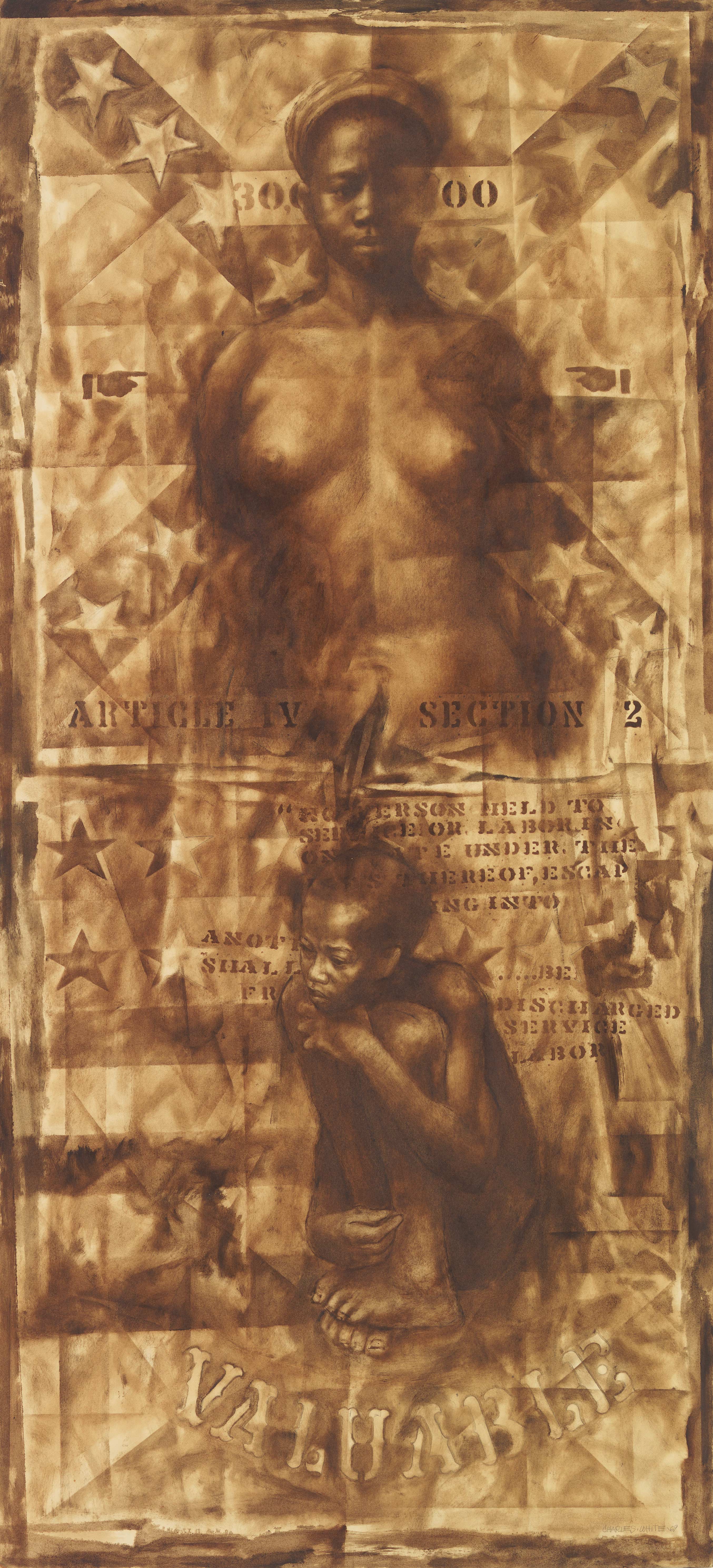
In his series Wanted Posters ( above no 17, 1971) he conveys the injustice of the system through subtle facial expressions and deep compassion.
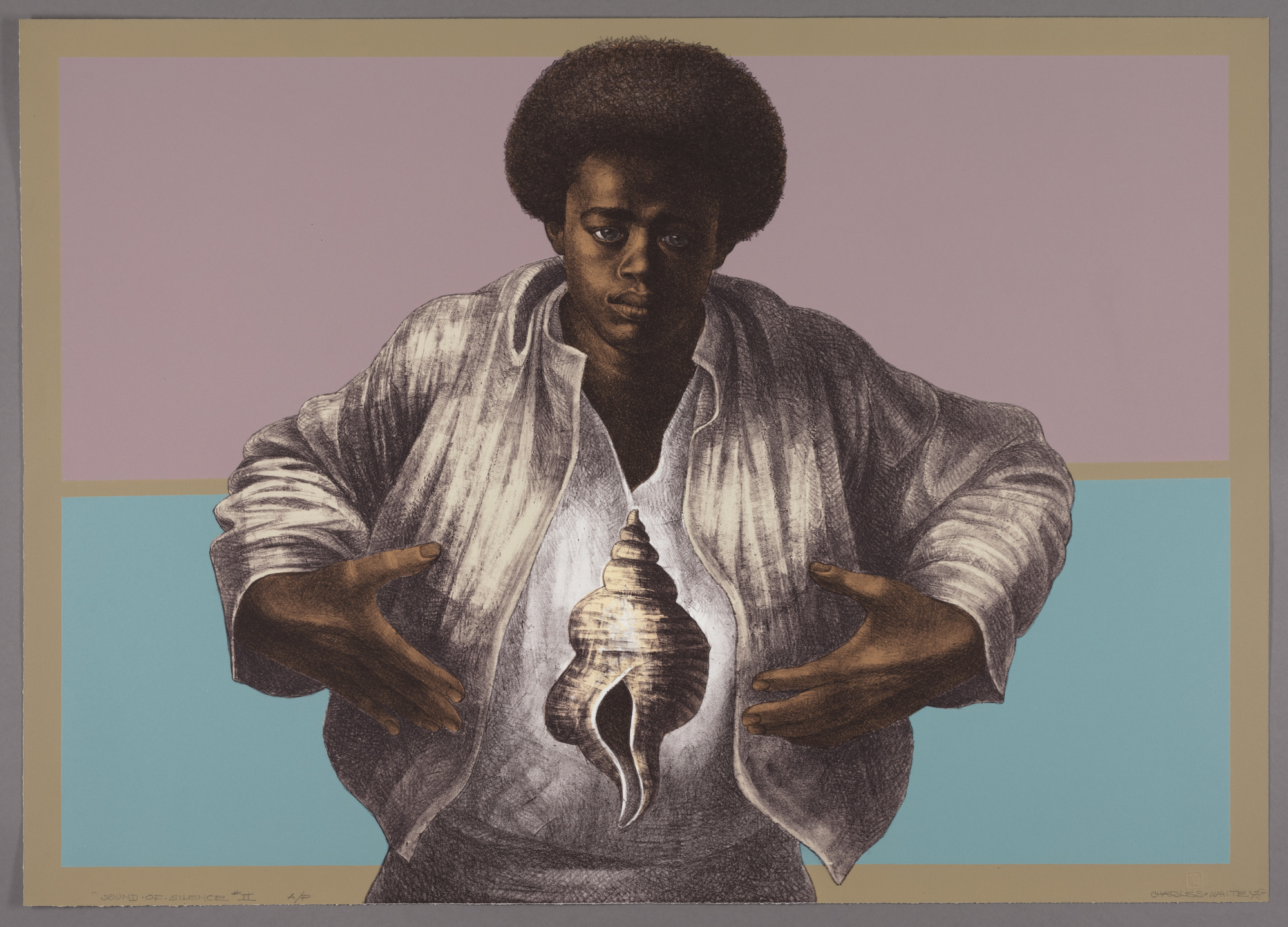
Just a few years before he died, he was still experimenting with new formats, media and content, as in Sound of Silence, a black man with a large conch shell at his center, suggests symbolism, but ambiguously. Is the shell protecting him? empowering him? We don’t know.

Indeed with Charles White, it is easy to make glib comparisons with white mainstream references, that are often completely inadequate. The most glaring example of this type of comparison is with Our Land, 1951. A powerful and defiant woman holds a pitchfork as she looks out from her doorway. In the catalog she is repeatedly compared to Grant Wood’s American Gothic (which White would have known in the Art Institute of Chicago). She could not be more different from the pale, insipid farmer and his daughter. White’s woman with her giant hands and assertive posture is clearly saying don’t come here or this fork will be a weapon. I immediately thought of the artist Clarissa Sligh’s story of her uncle who was killed and left on her mother’s doorstep when she was ten years old and he was twelve. This pitchfork holding woman protects her family with her working woman’s hands and her very sharp pronged fork.
Kellie Jones’s essay in the catalog “Charles White, Feminist at Midcentury,” provides a much needed new perspective on activist African American feminists in California. We all know that the history of feminism in the art world has been woefully controlled by a group of white women in California. Jones essay gives us a fresh start.

Another great insight from the exhibition is White’s life long close friendship with Harry Belafonte. Indeed, Belafonte narrates parts of the audio in the exhibition. They inspired and encouraged each other. Music played a major role in White’s life and many of his portraits give us famous singers such as Mahalia Jackson and Bessie Smith.
Every one of these paintings and drawings is riveting aesthetically and in its expression of a powerful persevering humanity. We feel these people from the inside, rather than passing over them from the outside because of the color of their skin.
I watched a discussion online between one of the (white) curators of the exhibition, and the (white) director of the Museum of Modern Art. A question from the audience came as to why White was so neglected after he died. In the answer there was no reference to racism in the art world ( nor did that word occur at any point in the discussion). But it is obvious that white art history still practices tokenism when it comes to artists of color. Thank goodness the three museums showing this major exhibition are finally giving one of the great twentieth century artists his due.
This entry was posted on October 29, 2018 and is filed under African American history, American Art, Art and Activism, Art and Politics Now, Uncategorized.
World War I America at the Museum of History and Industry and some personal history
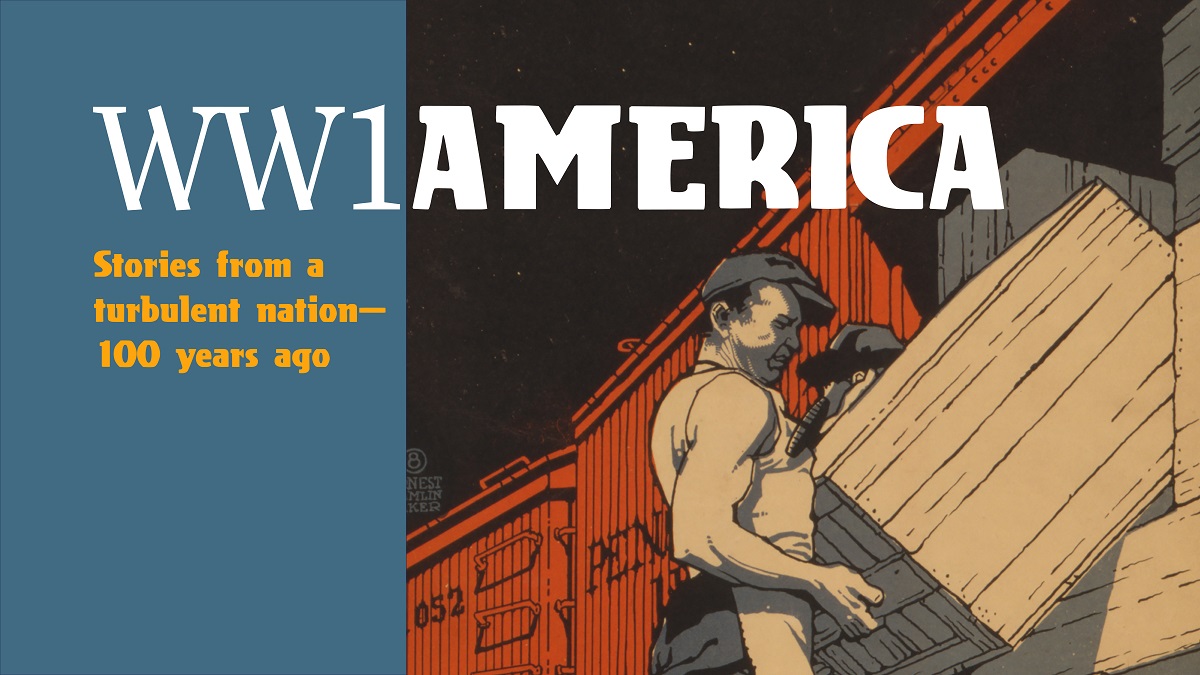
As we approach the hundredth anniversary of Armistice Day for World War I on November 11, over very own Museum of History and Industry is hosting the only exhibition on that subject on the entire West Coast. Armistice Day began as a protest against the horrors of war. It has evolved into a celebration of veterans, a very different purpose. This exhibition covers the full range of the issues raised by war, emphasizing the massive changes in US society.
First organized by the Minnesota History Center in partnership with the National Constitution Center and other institutions, MOHAI has added a significant Seattle component. Leonard Garfield, the dynamic Director of the Museum, commented at the opening, much of what we see in today’s Seattle began during World War I.
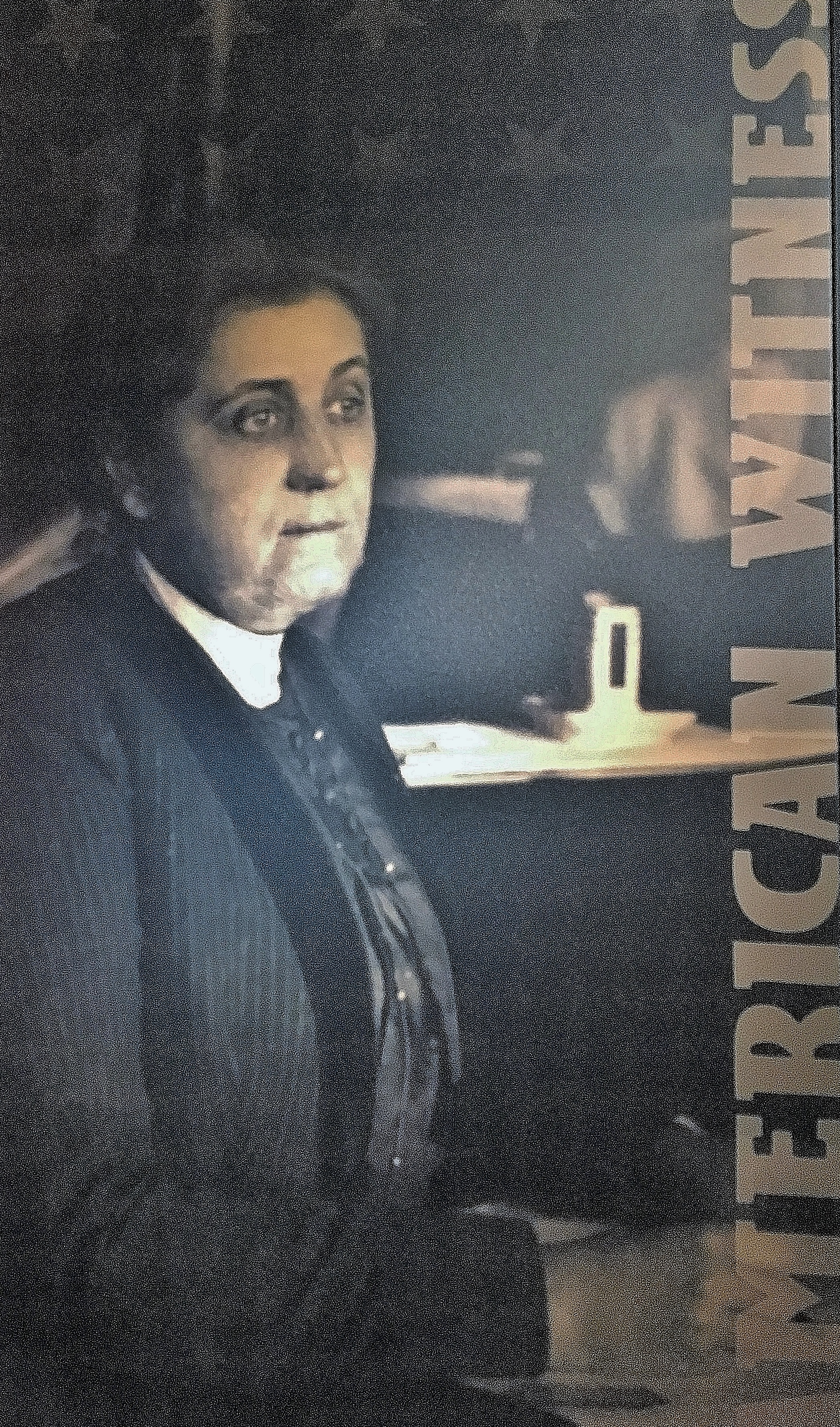
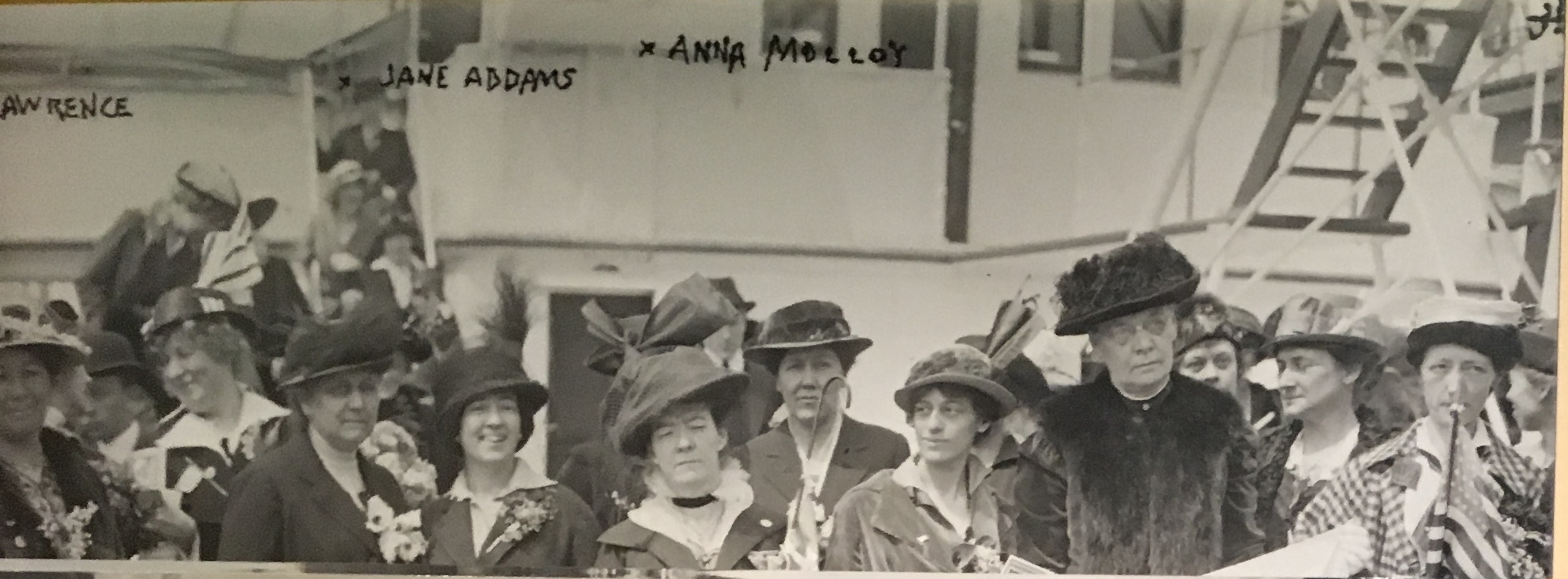
I was happy to see the anti-war movements, led by women like Jane Addams, at the beginning of the exhibition. Addams led an outcry with other women against the war as well as founding the Women’s International League of Peace and Freedom after the war, an organization that is still in existence today.
Women are prominent throughout the exhibition: Seattle Mayor Bertha Knight Landes organized women’s clubs to support the war;
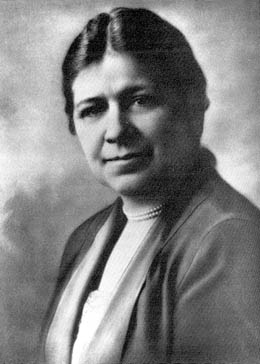
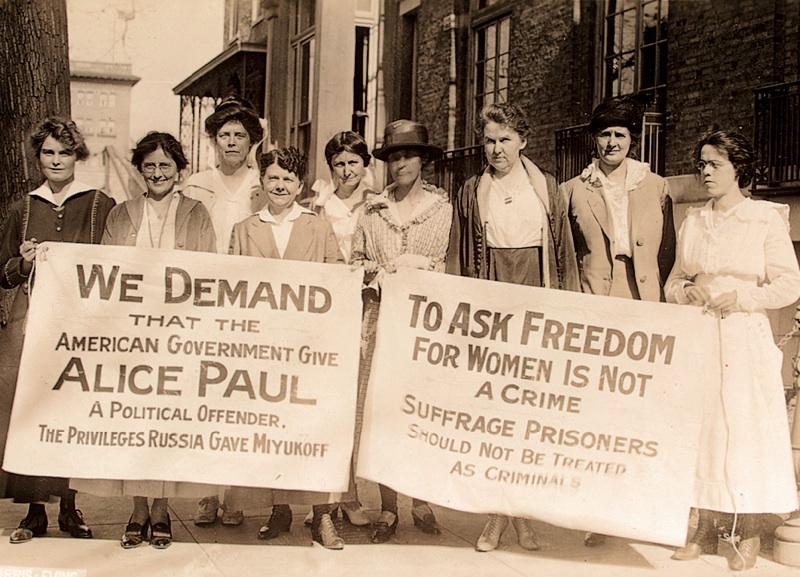
Alice Paul, a leader of women’s suffrage, protested in front of the White House, was imprisoned and then went on hunger strike. Here are some of her supporters.
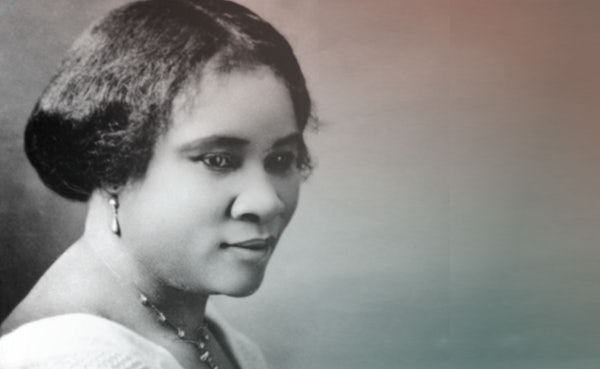
Mme C J Walker, the first female self -made millionaire through her famous hair care empire, supported the African American troops and spoke out for Civil Rights.

Women also volunteered with the Red Cross as ambulance drivers and nurses and joined the workforce here.
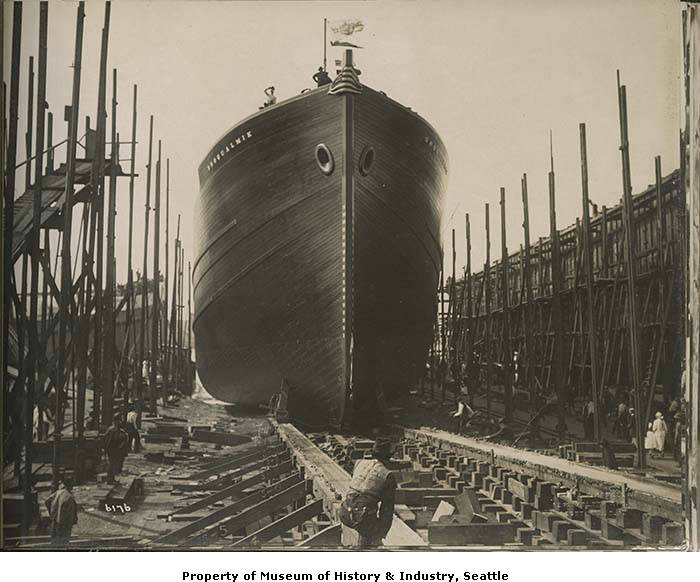
Other themes were massive industrialized war machinery, home front consumerism, conscription -with an emphasis on African Americans in the exhibiiton – here is a picture of the Harlem Hellfighters who performed outstandlingly in the Meuse Argonne battle,

the sinking of the Lusitania in 1915, popular culture such as newly invented sound recordings, Charlie Chaplin’s movies, and Houdini.

There were new treatments for veterans with disabilities (300,000 documented cases.)
The show concludes with anti immigrant furor,
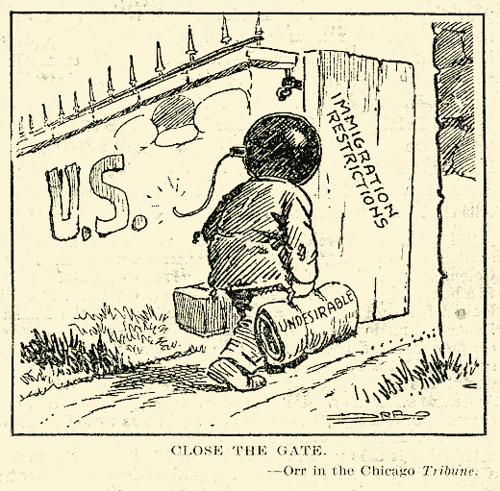
the Red Scare,
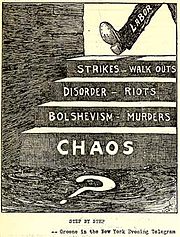
and the Seattle General Strike of 1919.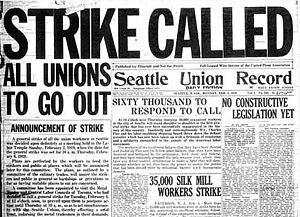
The exhibition adopts the new techniques for exhibiting historical artifacts that incorporate our input with touch screens, and other tricks.

For example we are asked to judge punishment based on the 1917 Sedition Act that was applied to Edward Snowden.
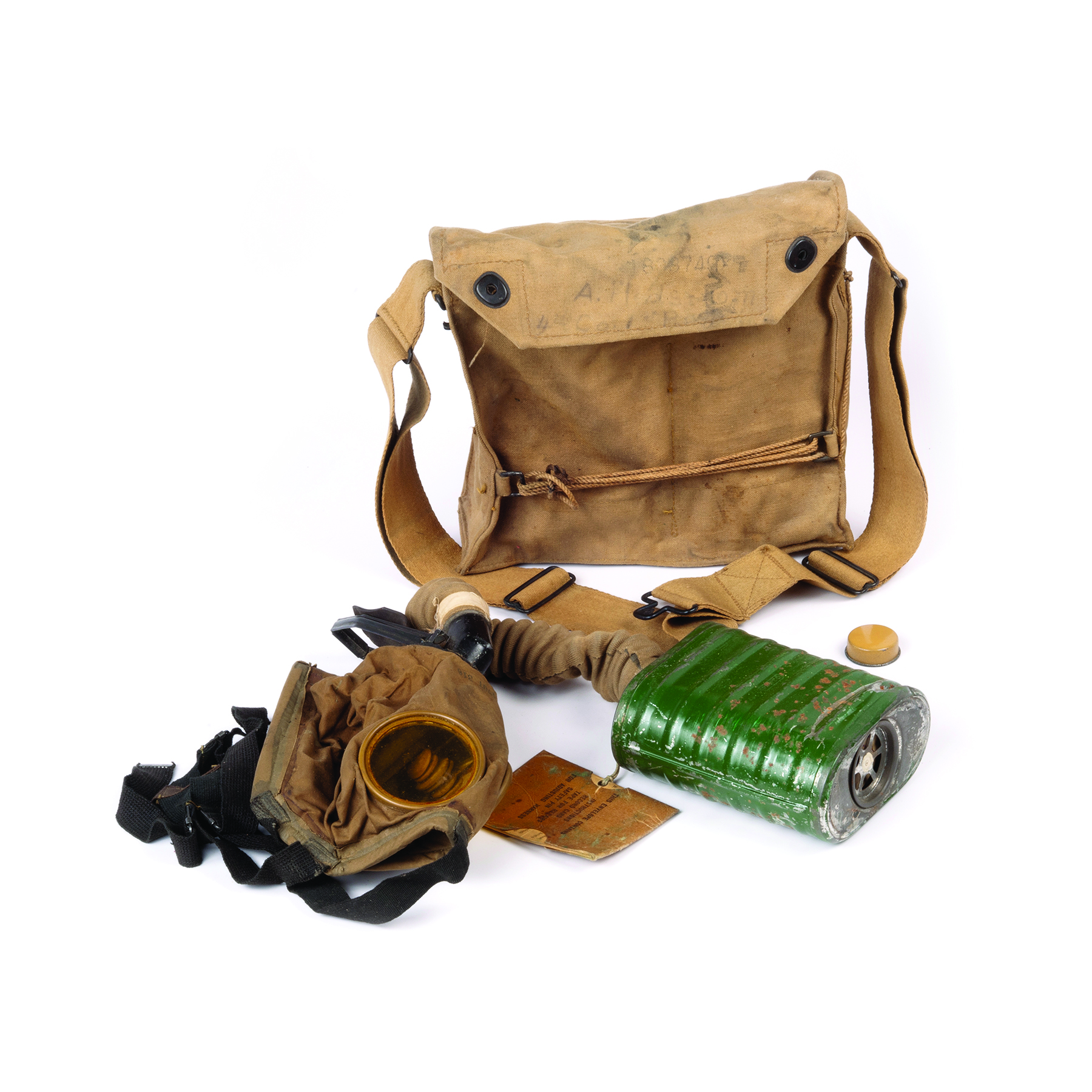
But, looking at an artifact like a gas mask cannot convey the feeling of a young soldier when a call goes out to don the mask as a green cloud of poisonous gas descended. Not to mention that we cannot possibly grasp the horrors of war.
Part II Personal History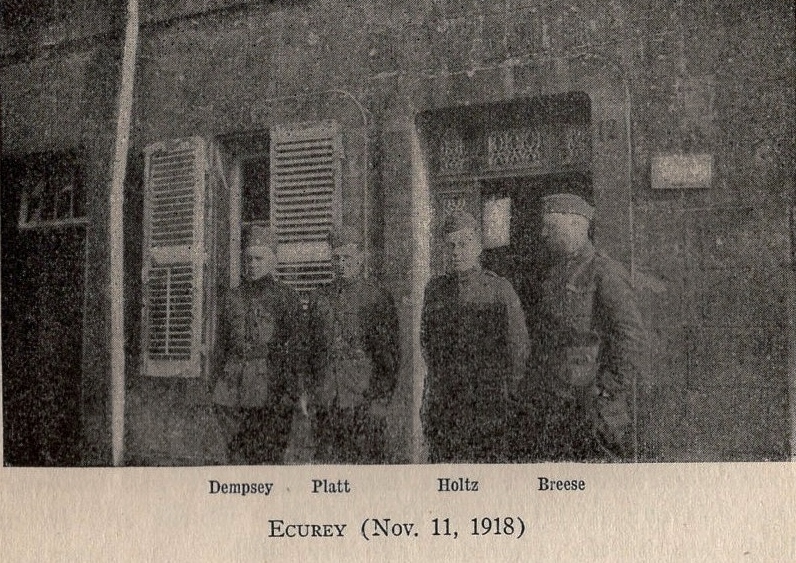
I got a distant sense of the horrors because my father ( in the end First Lieutenant) Rutherford H. Platt, fought in World War I and wrote up the history of his “Battery F 323rd Field Artillery.” It details their movements and actions in training, travelling to France, their participation in the battle of the Meuse-Argonne ( in the “Argonne Forest” as you see just dead trees by then) and Verdun (September – November 1918) in which half of the deaths of American soldiers occurred.
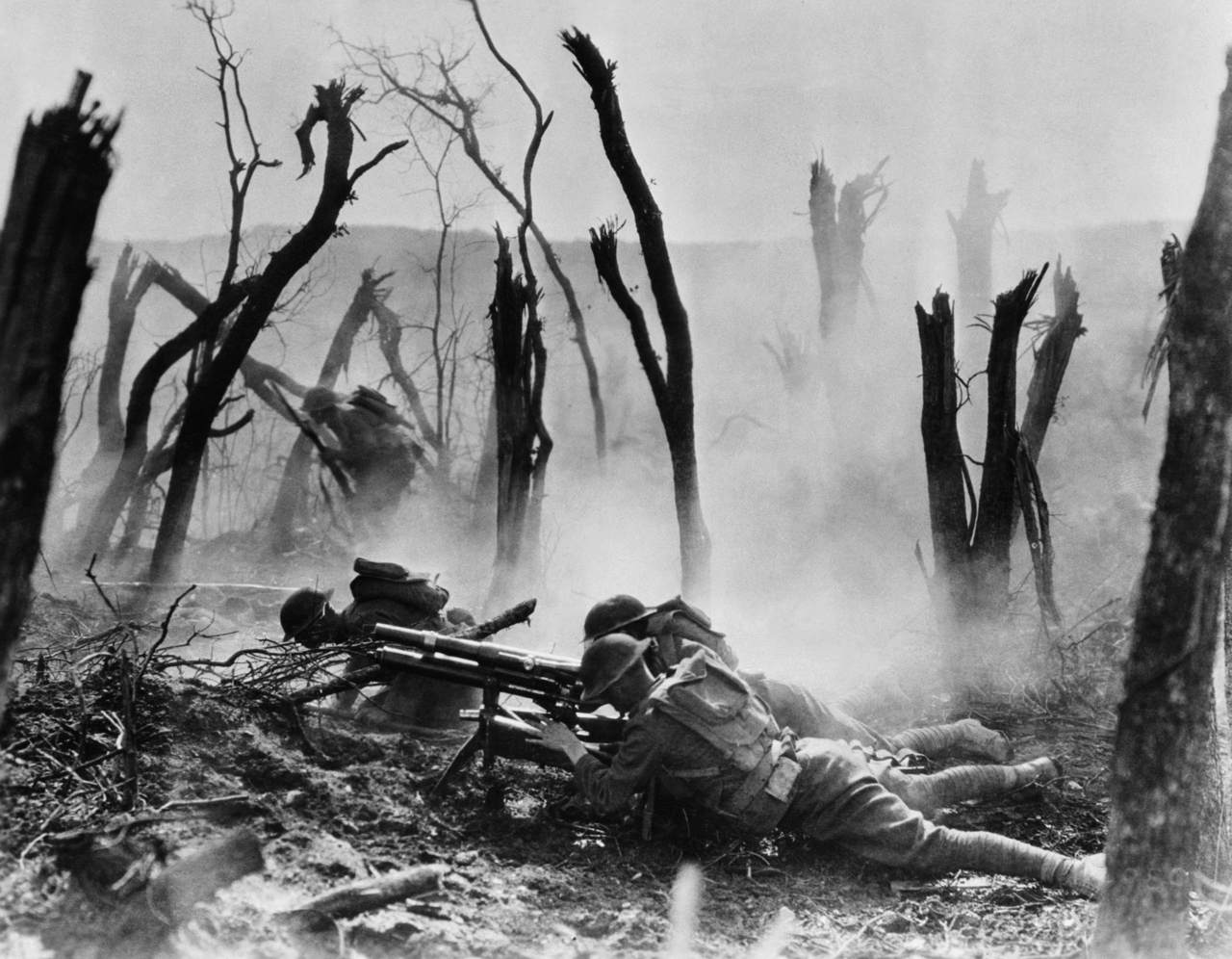
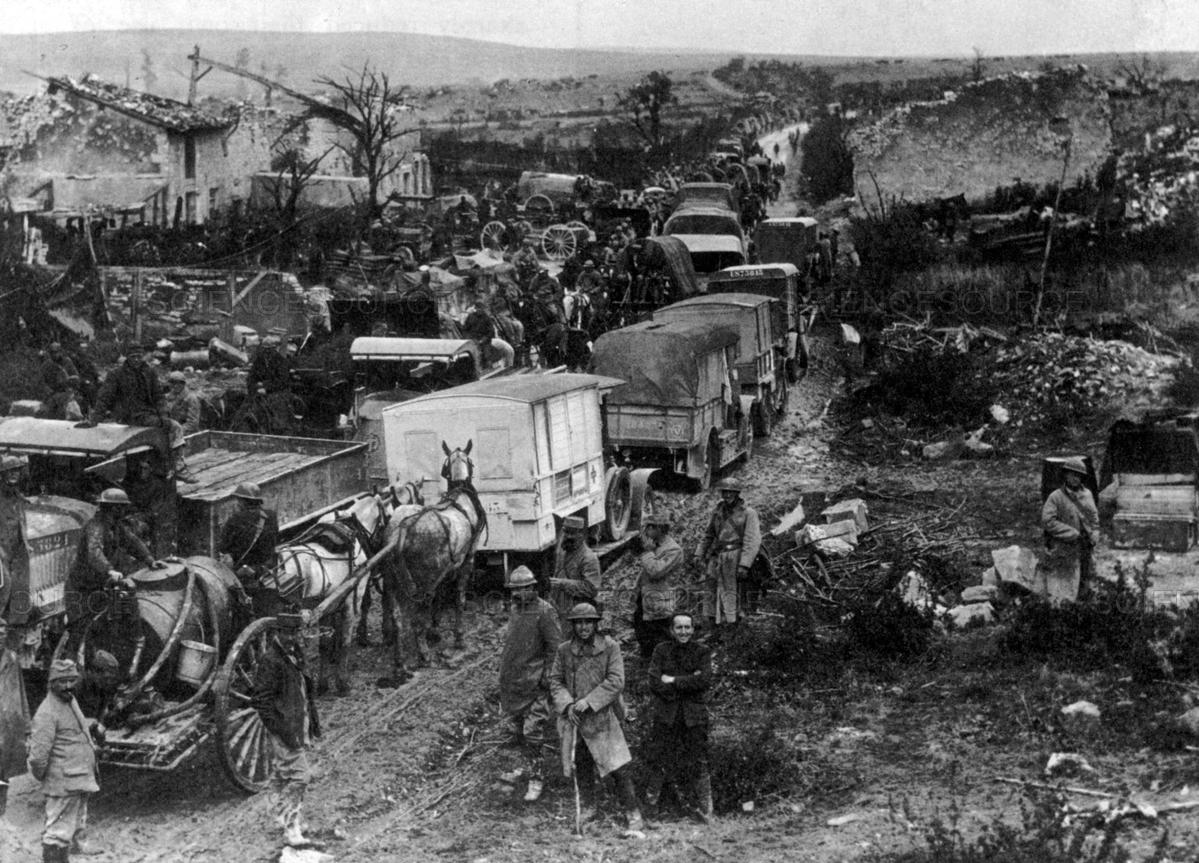
He and his fellow soldiers in Battery F were fortunate in being held in reserve most of the time, although they did experience frequent fire fights and constant shelling, a traumatic experience that often went on for days and meant instant death if a soldier took a direct hit. The shells were fired without seeing the target however, and so frequently missed. But the constant sound, stress, and possibility of death meant huge trauma.
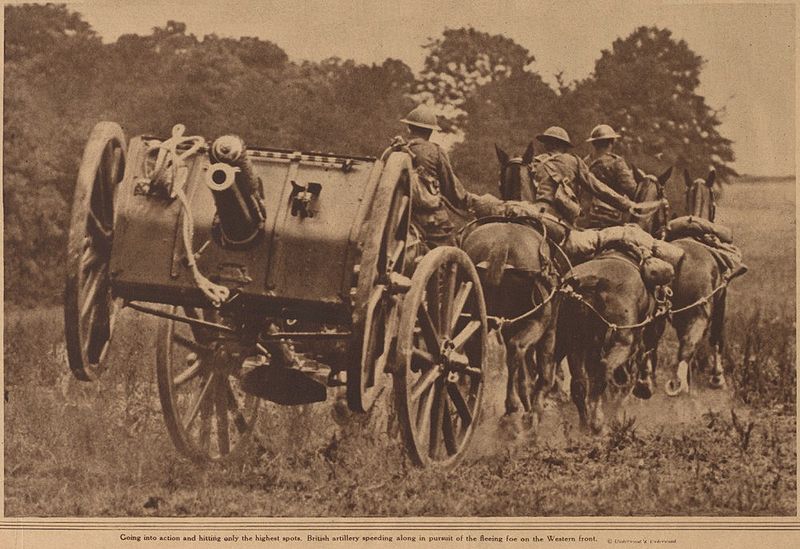
The book frequently refers to the caring and condition of the hundreds of horses who hauled the equipment up and down muddy hills, and uneven roads. Although we may have seen War Horse, the dramatic play about one World War I horse, we forget how many thousands of horses were in the war and how many died.
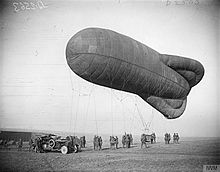
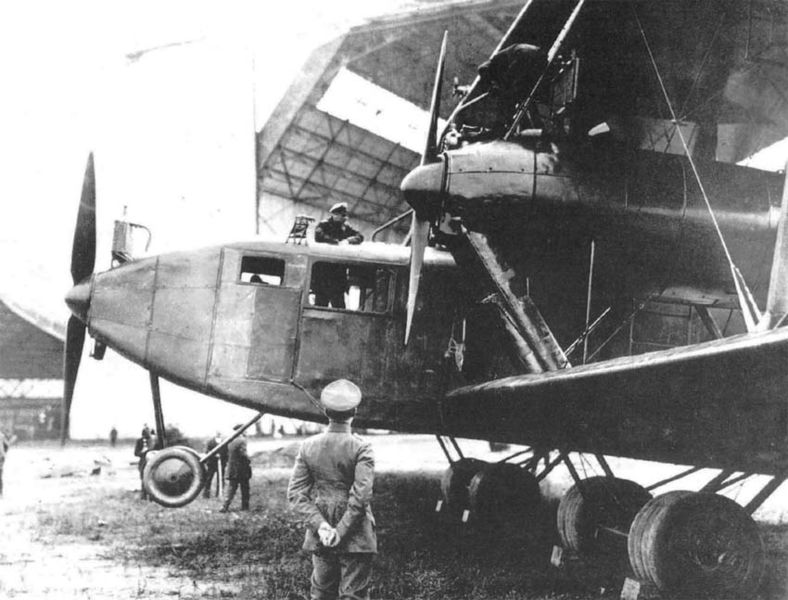
Aerial warfare was a newly destructive force in 1918 that the book dramatically describes, juxtaposed to the now archaic observation balloons that were frequently strafed by airplanes.
The chaotic communications, endless hours spent standing ready and waiting for the next order to move, and the ever present mud, lack of sleep and food, and anxiety, are true of all war experiences. Following the armistice, Battery F marched for two months through Germany, then finally returned home in May.
My father never talked about his war experiences.
But for some strange reason, he woke us up every morning with “reveille” an echo of his army experience.
He also published the war stories of one of the officers that trained him to be a soldier. Mr Archer USA is an “oral history as told to R.H. Platt” of an Army professional who signed up at 16, immediately went to Cuba at the same time as the Rough Riders, went into the “Forbidden City” during the Boxer Rebellion and spent years in the Philippines serving under Pershing who went on to be head of all American Forces in World War I.
Part 3
Many US soldiers lost their lives in 1917-1918, but it cannot be compared to the horrific slaughter of young men from Great Britain, Germany and and other countries. My British husband’s father and all but one of his uncles (who was a conscientious objector) fought in the war, one died, all were traumatized. His uncle, Charles Carrington, spoke and wrote of his experiences as a 20 year old officer,
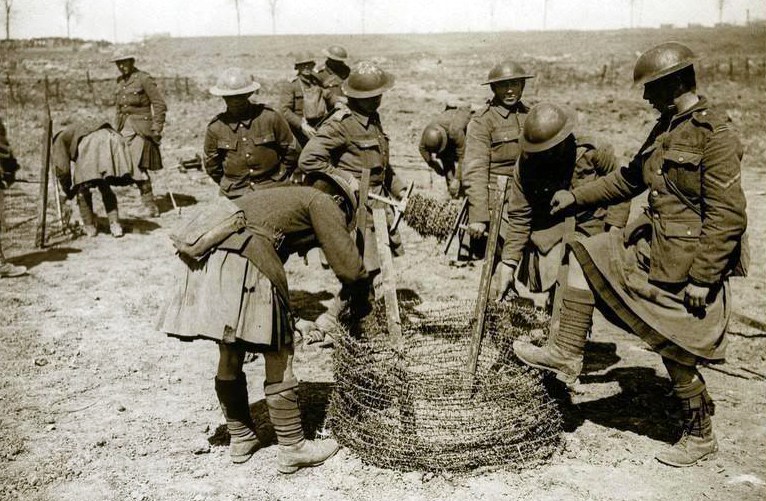

giving us minute detail on the huge challenges (such as silently carrying rolls of barbed wire in a zigzag trench at night), the horrific sound of the war with the newly created industrial guns, and his training of young men to be sent off to die as late as September 1918.
But the greatest loss of life occurred after the war with the Influenza epidemic. Seattle again is featured as proactive in preventing its spread.
Leonard Garfield declared about the exhibition at MOHAI “WWI America tells a huge story – with consequences that continue to ripple through our world and our community today.”
How true that is! We are now in permanent war, and permanent anti war movements. Boeing is one of the largest military contractors in the world and of course, anti-immigrant hysteria escalates with each passing day. Our environmental catastrophe started escalating in World War I and the military continues to emit tons of toxic chemicals and pollution.
“WWI America” Museum of History and Industry
Sept 1, 2018 to Feb 10 2019
MOHAI will be hosting these important events: October 3 “Coughs and Sneezes Spread Diseased: The Spanish Flu Epidemic,” October 20 “Fashion during World War I” October 20, and December 5 “Dissent:Patriotism or Treason?”
On the weekend of November 11, the 100th anniversary of the Armistice, Bells for Peace will ring nationwide at 11am. MOHAI will have a series of events from Saturday to Monday (https://mohai.org/exhibits/ww1-america/check for details).
This entry was posted on September 25, 2018 and is filed under Uncategorized.
Carletta Carrington Wilson’s “letter to a laundress”
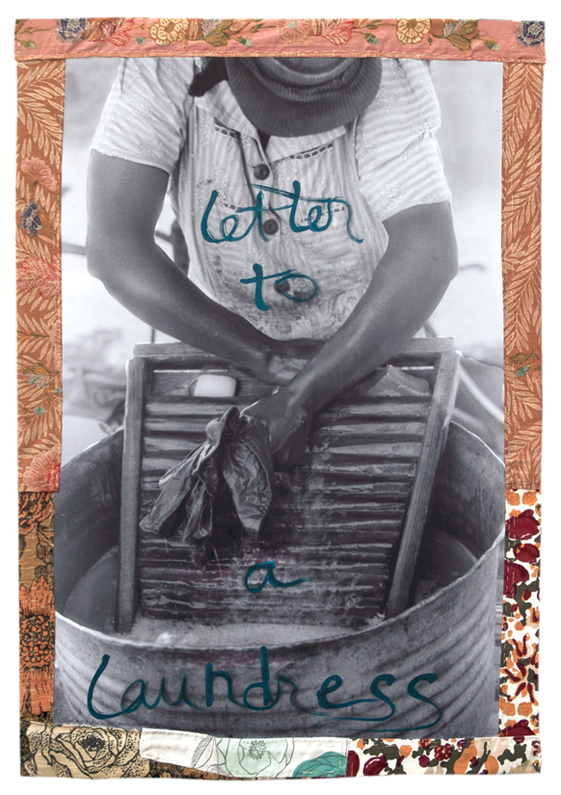
Carletta Carrington Wilson, Jack Delano, Tenant Farmer wife washing clothes, Greene County Georgia, June 1941, reprinted by CCW for poster design by Al Doggett
Carletta Carrington Wilson addresses her “letter to a laundress” to her great great grandmother, but her profound photo/poem installation currently on view at the Kittredge Gallery in Tacoma (only until September 29) honors the work of all those who, in her words, “took in wash.”
She found photographs of anonymous laundresses in the archives of the Farm Security Administration, most of them taken in the late 1930s by such well known photographers as Dorothea Lange, Marion Post Wolcott and Russell Lee.
The “letter” is a poem written in blue script on the photographs, and recited by the artist in a pod cast as we view the work.
Mounted on fabric, the photographs are pegged to a line, and hang above our heads. As we walk between three lines of closely packed “laundry” the poem unwinds, describing, the many steps of doing laundry before the advent of machines and drip dry fabric.
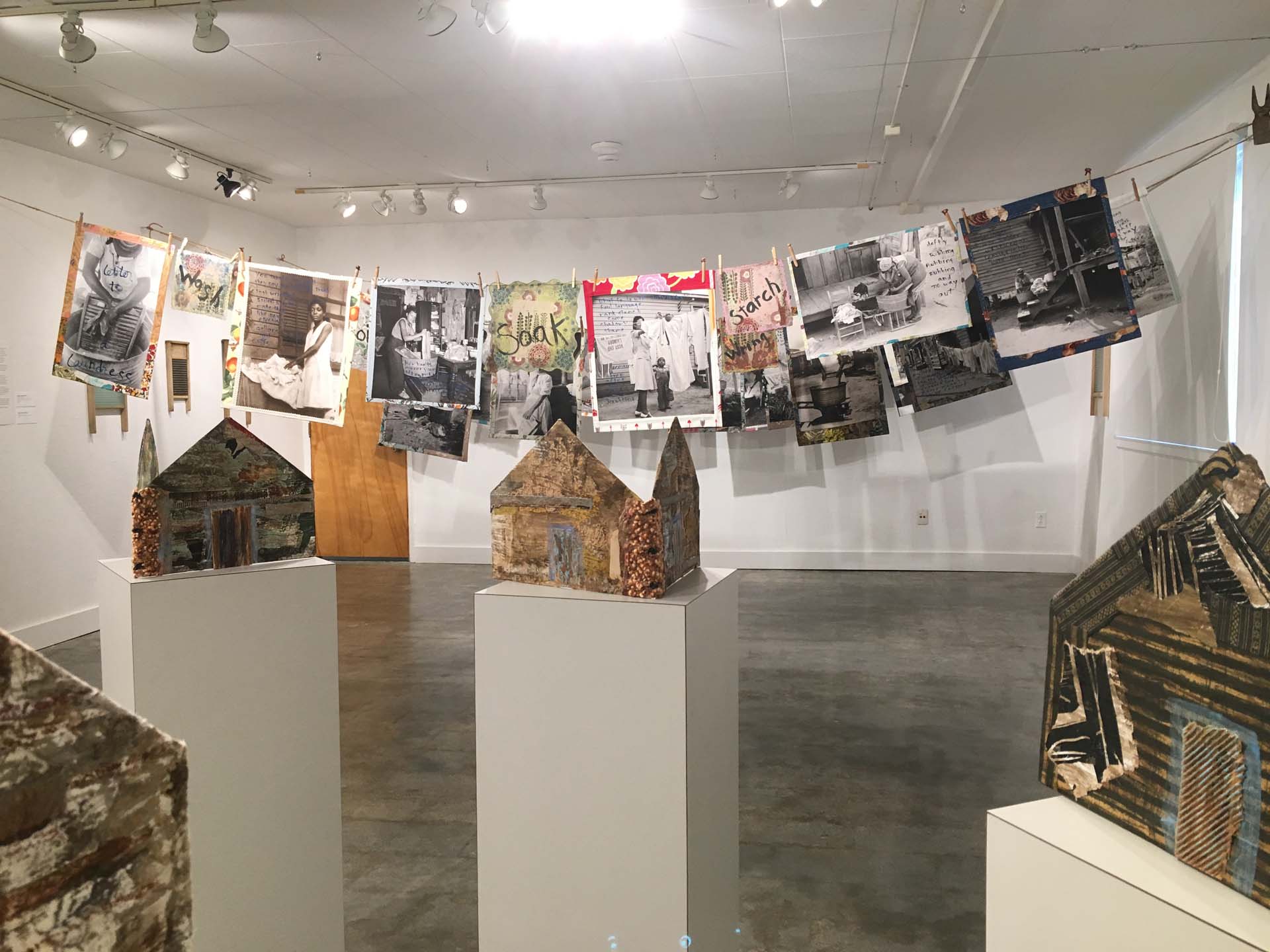
Carletta has identified ten steps
each with a single word:
Wash Soak Starch Wring Boil Pin Rub Scrub Hang Press.

Photograph on the right “you taught her well” photograph by Doris Ullman Negro Girl Ironing, Place unknown 1938
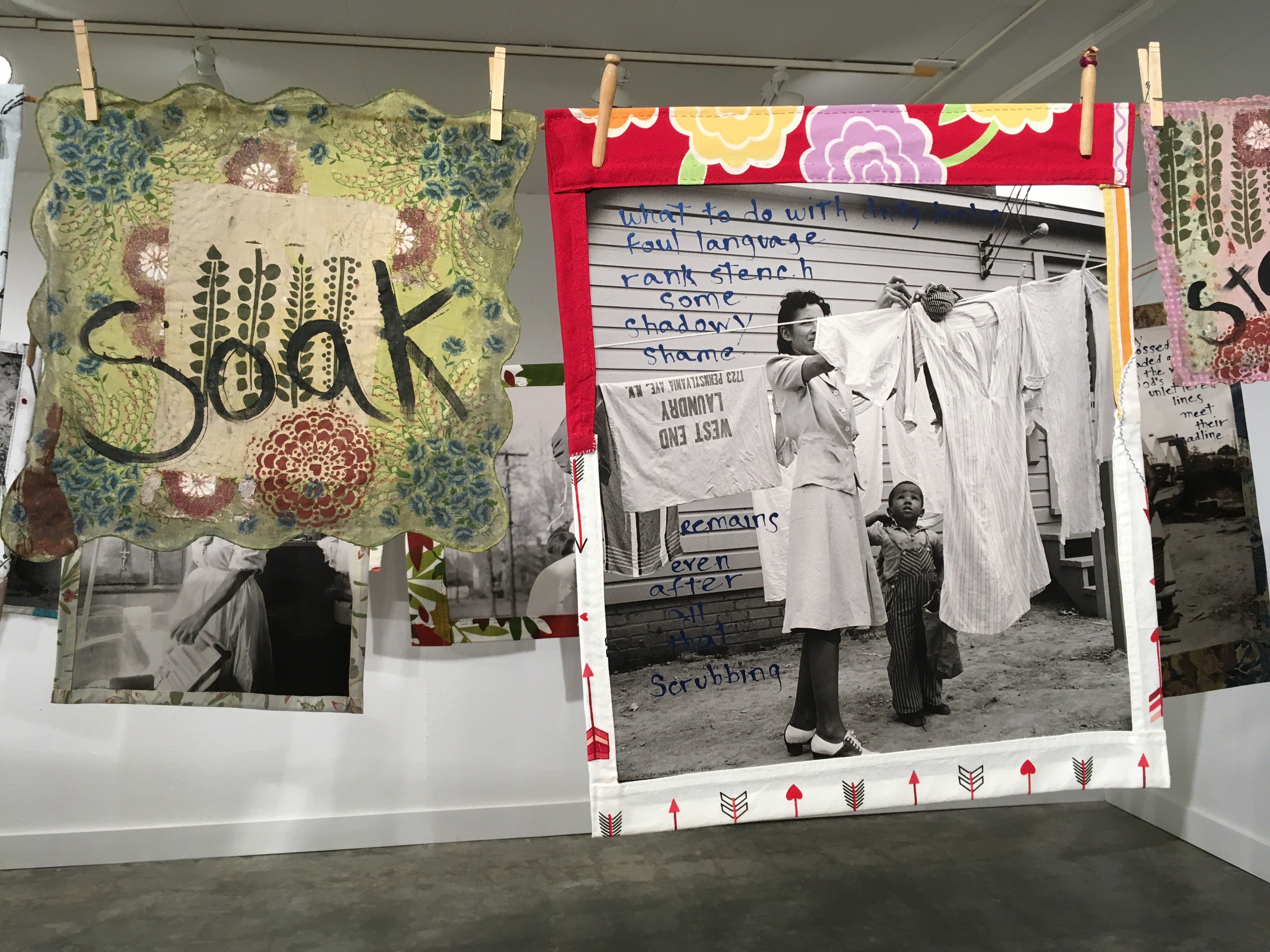
“what to do with dirty looks” Marjory Collins Arlington Virginia FSA trailer camp project for Negroes hanging out washing in front of the community building, April 1942

deftly rubbing, rubbing, ” Russell Lee Wife of FSA client, former sharecropper, Washing clothes in front of old cabin, Southeast Missouri Farms, May 1938, right photograph “wringer iron holder Dorothea Lange, Washington facilities on a Greene County Georgia tenant farm July 1937
The photographs are arresting, suggesting the real labor of doing laundry and how it evolved. Some of the photographs are actually from the late nineteenth century, early washerwomen, using a washing stick to stir laundry in a tub, others are using a washboard, that iconic object now seen only as a relic (several are included in the exhibition).
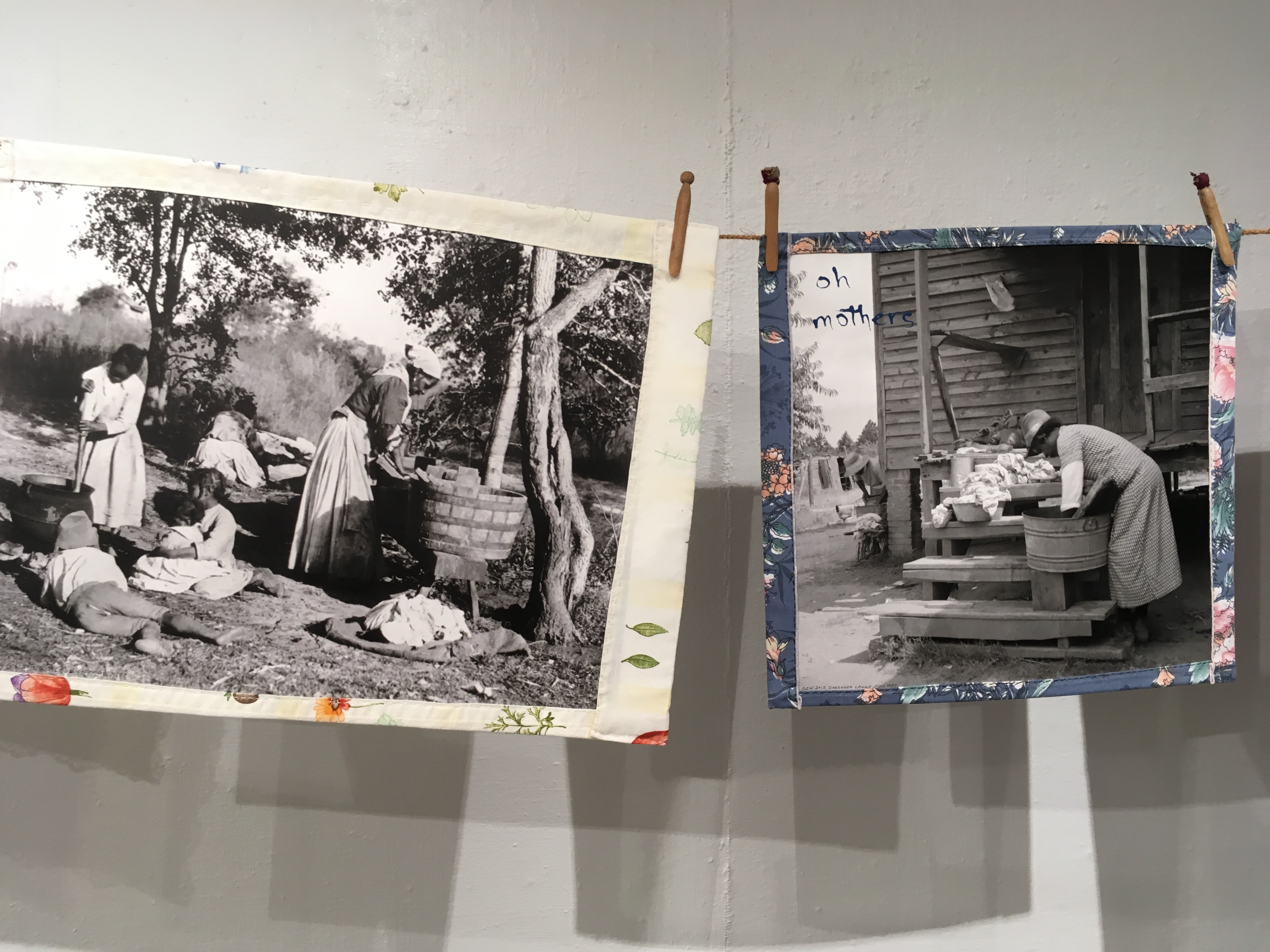
Left no title, right “oh mothers,” Dorothea Lange Washing Facilities on a Greene County, Georgia tenant farm July 1937
The separate steps, such as an iron wringer
now so lost to us, appear in these FSA photographs.
The women rarely look up or out, never at the camera, the photographer. We have all types of women from those dressed in a muslin shift to elegant women in suits and shoes with heels.
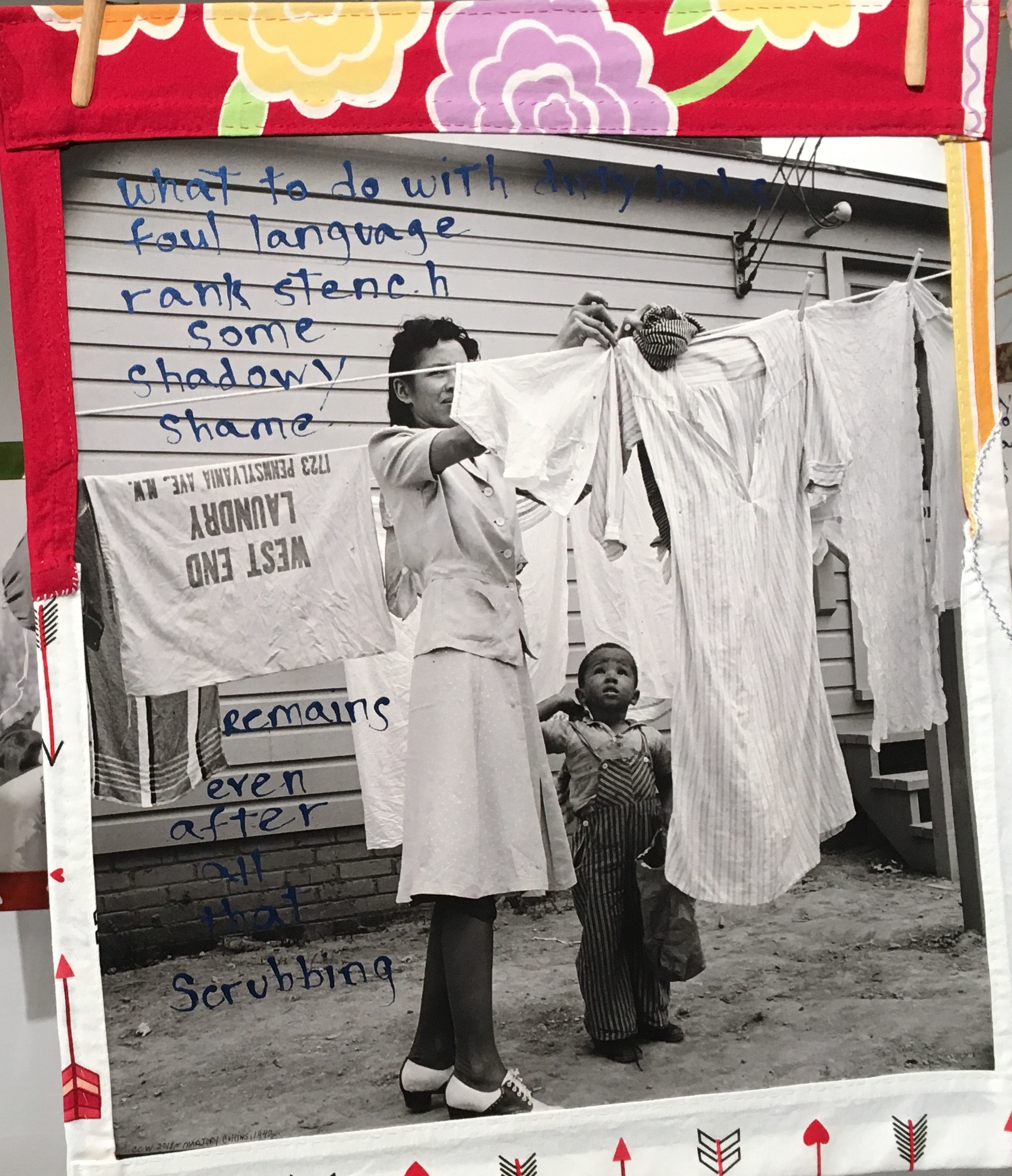
Carletta Carrington Wilson deeply feels words, their meanings, double meanings and symbolism. Thus here, as offered by the artist, is a shift from laundry to something more sinister:
“hoist baskets tote tubs lug those loads every bundle extends a line
a line awaiting a line awaiting its hangings.” And suddenly as Wilson wrote the poem, she realized the double meaning of hanging as also lynching.
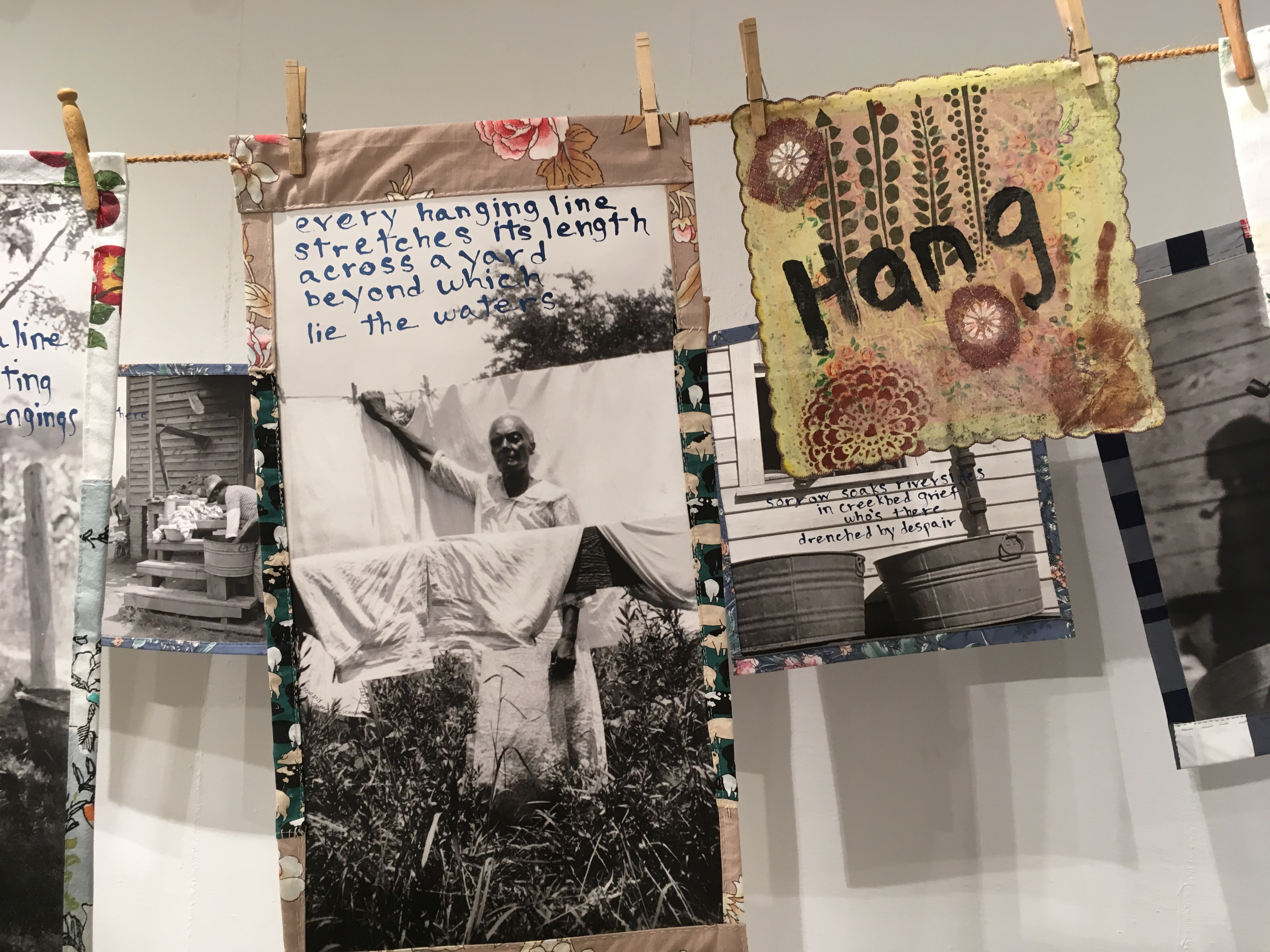
“every hanging line” National Photo Company Collection, photographer not identified: Orelia Alexia Franks, ex-slave, Beaumont Texas, July 3, 1937
As the artist said in a lecture “The lines of the poem lead the reader away from the mundane duty of washing clothes to a disturbing image of lynching. Thus, we are led into the awful reality that links these women beyond the ordinary task of laundry.
“Post emancipation, in the late 19th and early 20th century there was a rise in the number of lynchings in the south. These mothers, sisters, aunts, grandmothers, cousins and friends knew, were related to, heard of, witnessed and buried someone who had been lynched. They, also, washed the clothes of someone who participated in a lynching. I was just speculating, but this was confirmed by a woman who spoke to me after one of the artist talks”*
This exhibition includes other intense works as well: across one wall is a series of fabric works called “field notes” from 2014 with Carletta’s trademark layers and meanings hidden in their patterns and textures.. You can spend a long time exploring these works, which are, as the artists suggests, like landscapes. One of her themes in her work is the “text of textiles” the steps from cotton into cloth and the metaphors that emerge from fabric.
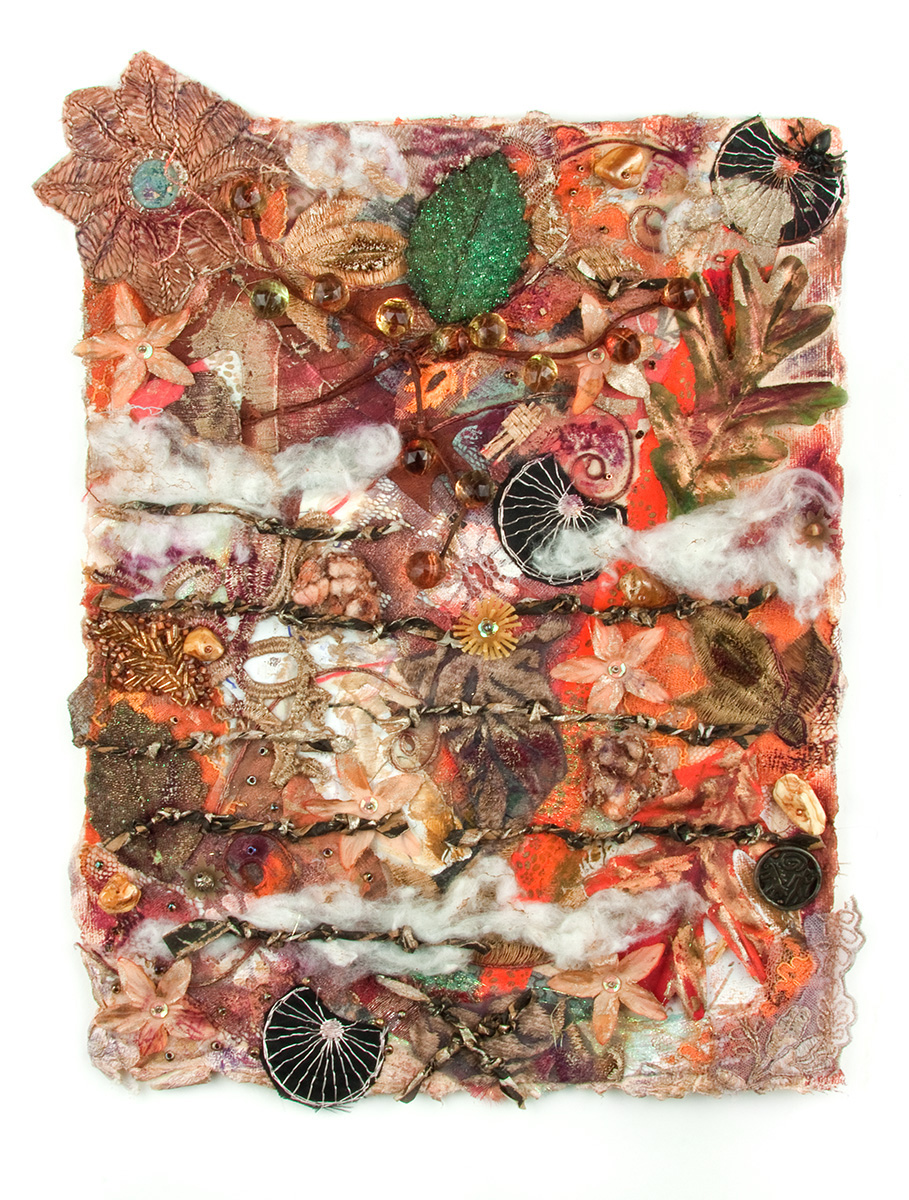
fieldnotes wrap my hand tight
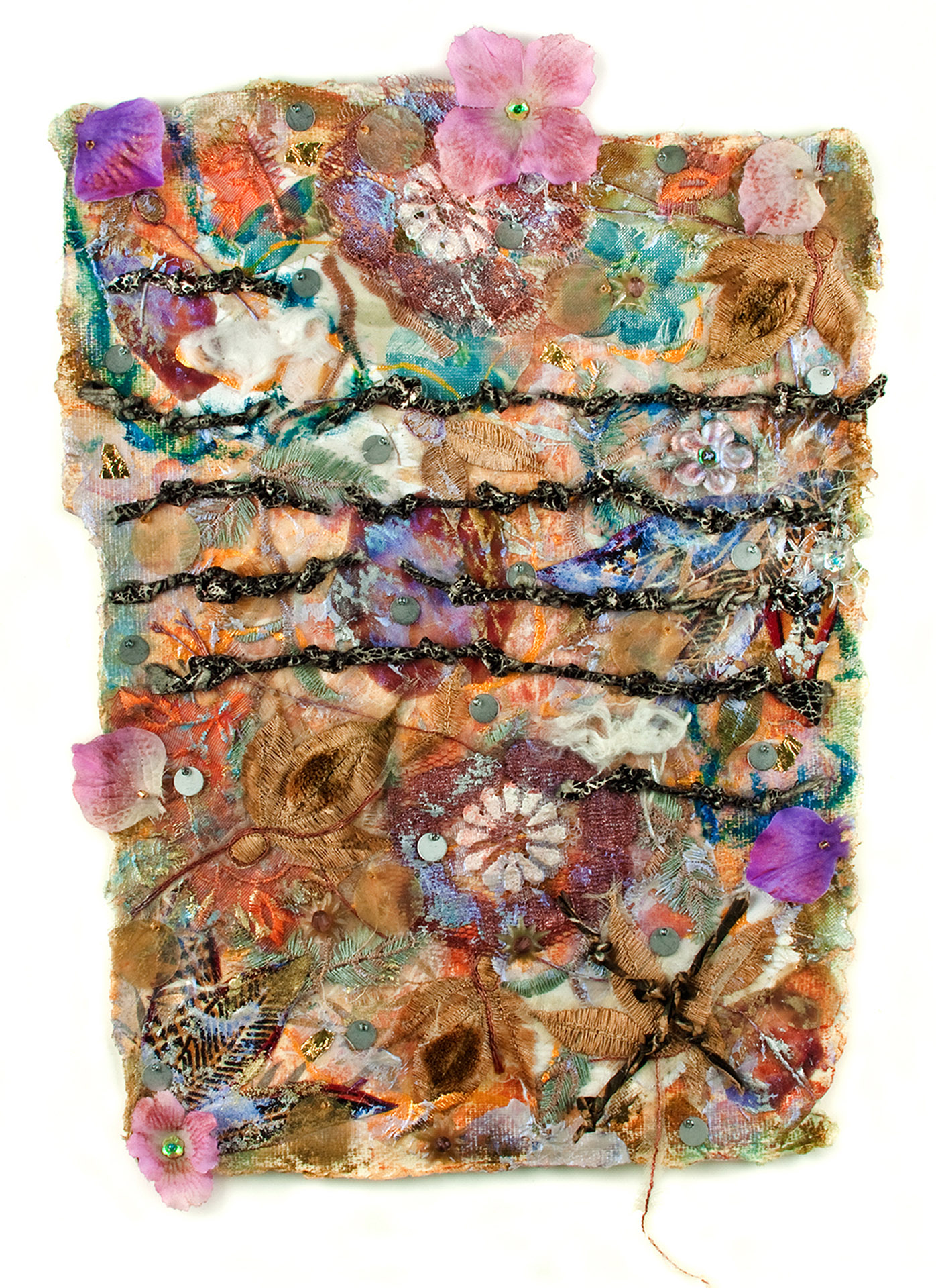
field notes woke ‘fore day
Then there are simple cut out house shapes, what the artist calls “wordless books.” in a series called “knot my name haint my house”. They refer to the fact that 90 percent of enslaved people were illiterate. The blue around the doors is called ” ‘haint blue’and was used to deter ghosts” the artist explained.
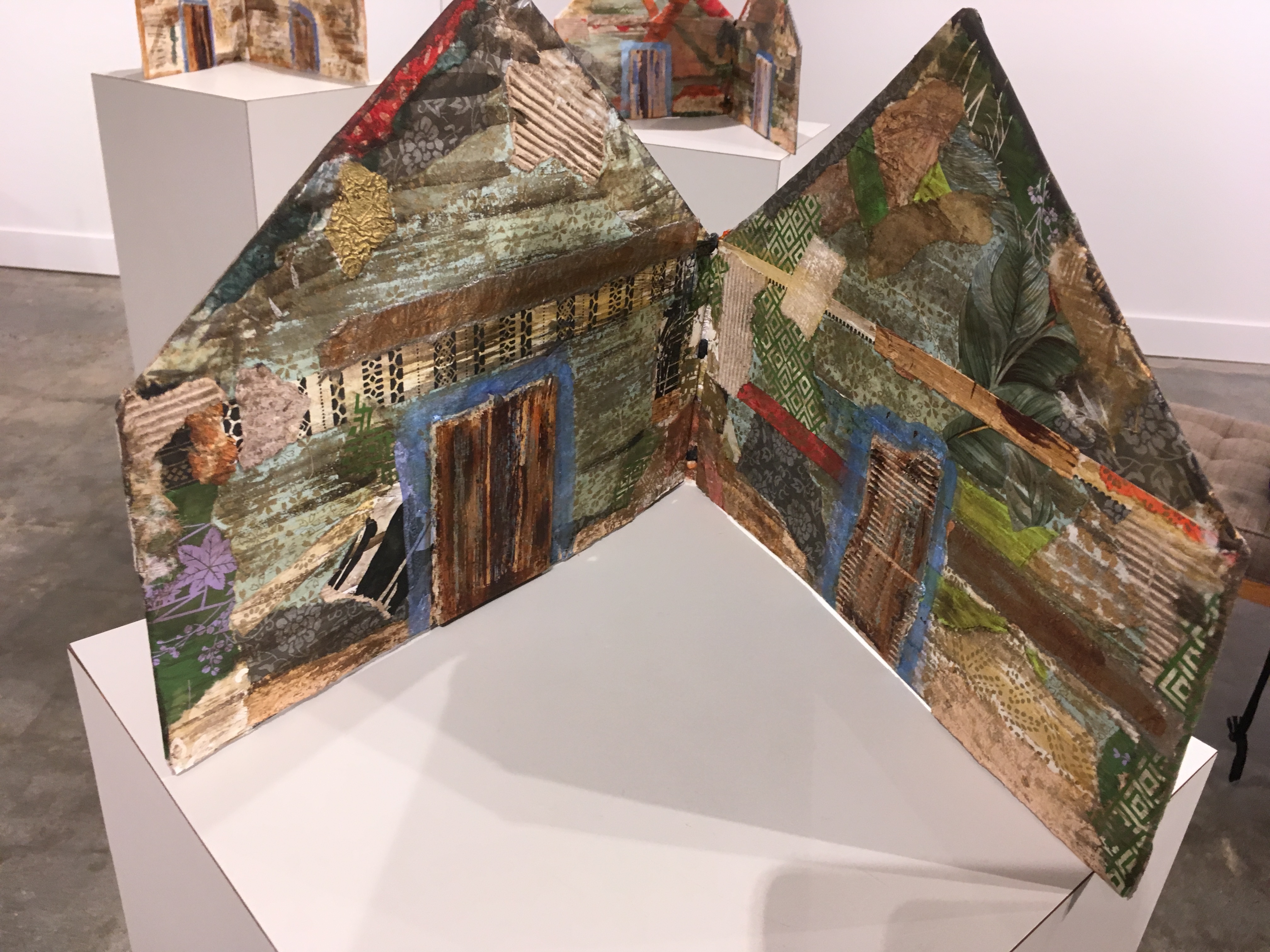
Carletta Carrington Wilson from the series “knot my name haint my house”
On one wall a “knotted line” again has double meaning, the names are (k)not names, but the names given by slave masters, here taken from a plantation inventory. The artist elaborated
“The idea is that once a person become enslaved their lines of descent are knotted. Each time a person is sold, with each name
change and change of place of bondage the loss of knowledge of familiar ties becomes, increasingly, knotted and unknown.”
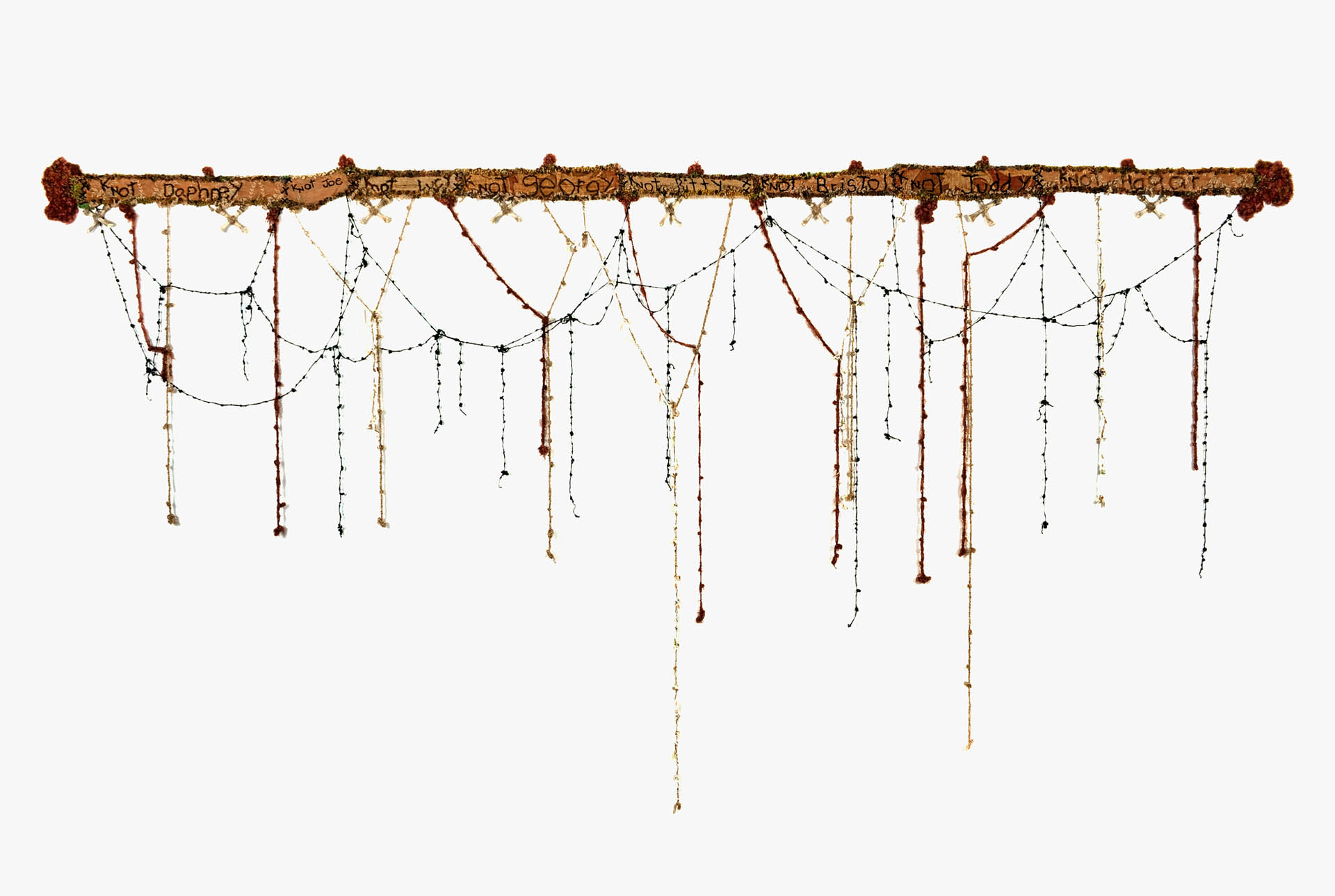
Carletta Carrington Wilson “the knotted line” Photo by Mark Frey
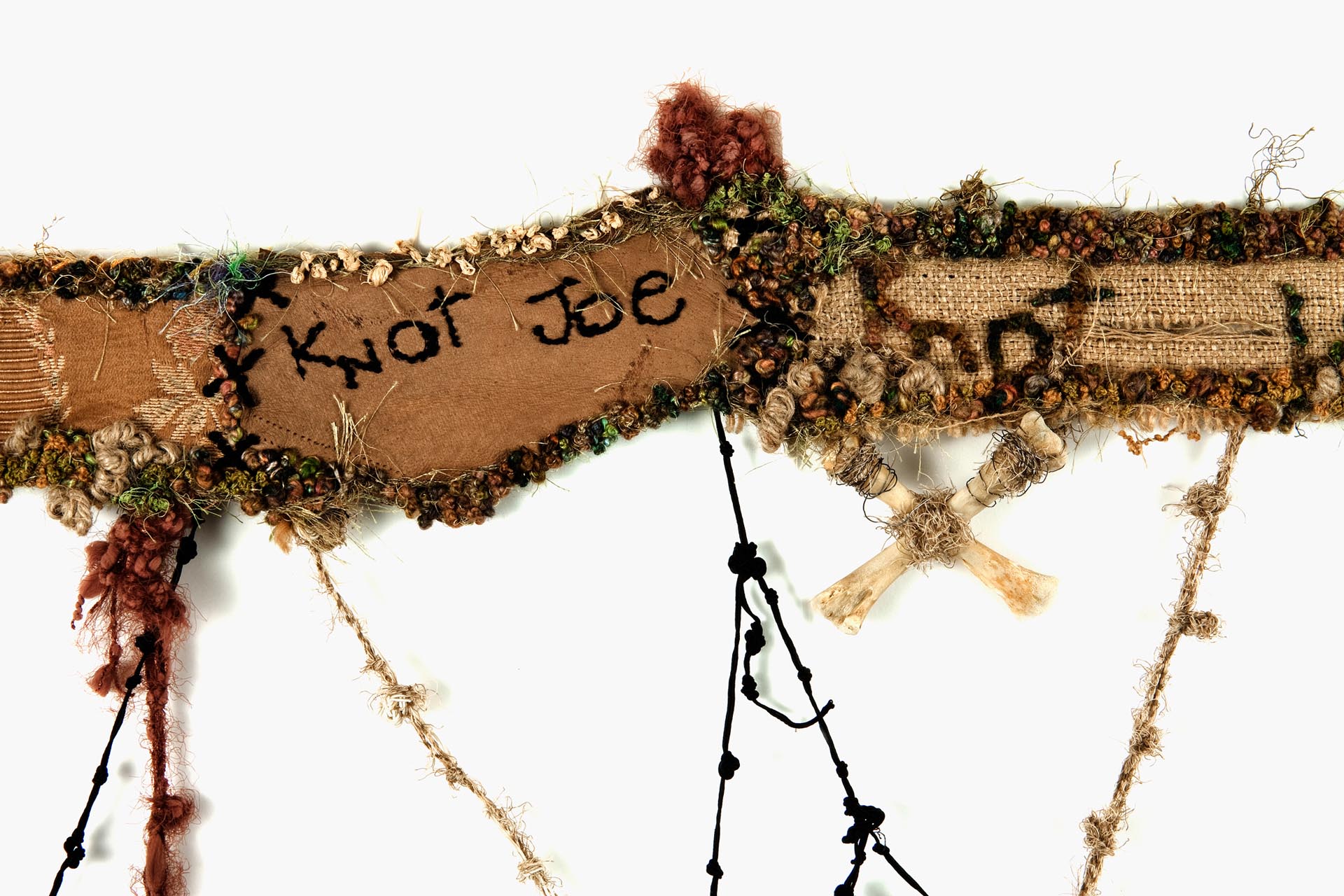
Photo by Mark Frey
The “blood knot” lies below “2 resist dying”, another title with more than one meaning. two indigo blue wall hangings in dye resist. The artist describes the work “2 resist dying” as referring to both the resist-dye process and, also, that of a man and woman resisting their enslavement.
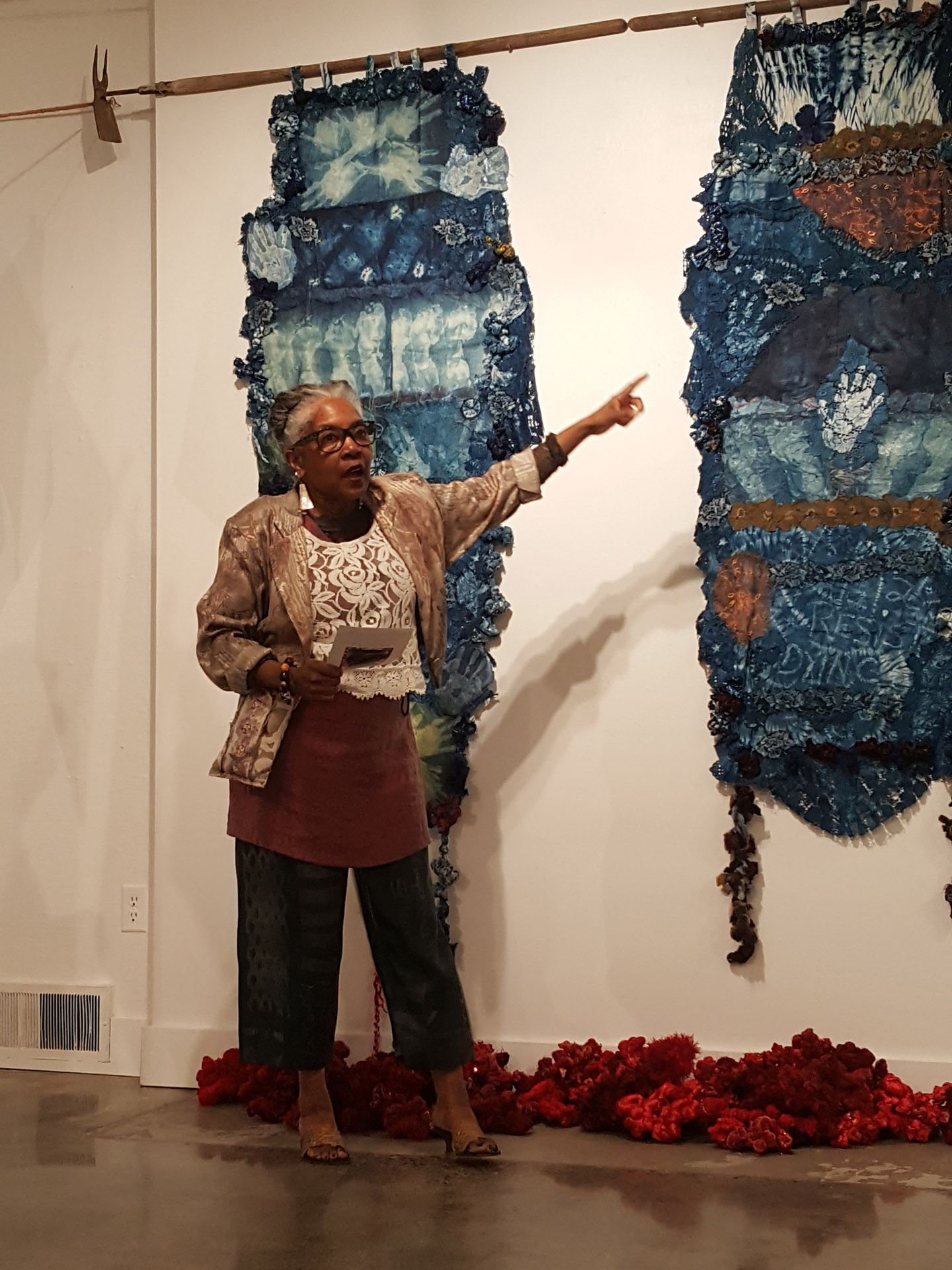
The artist explaining the work “2 resist dying” Photo by June Sekiguchi
Underneath is a “blood knot, “a tangled pile on the floor invoking the intermixing (knotting) of blood among people involved in the slave trade. The artist specified “The “blood knot” represents the knotted blood lines of Africans, Europeans, Asians and Indians as a result of the global trade networks formed during the transatlantic slave trade. ”
Carletta Carrington Wilson poet, collagist, historian, one of the most intriguing creative minds I have known. Here’s hoping this exhibition can move to a major museum soon.
*Thank you Carletta Carrington Wilson for sharing this text and other information and images for this blog post.
This entry was posted on September 7, 2018 and is filed under African American fiction, African American history, American Art, Arican American history, Art and Activism, Art and Ecology, Art and Politics Now, art criticism, Civil War, ecology, Uncategorized.
Three inclusive events in Seattle give me hope


The first event was the 55th anniversary of the March on Washington sponsored by Mt Zion Baptist Church, the oldest African American church in Seattle and a pioneer of Civil Rights Leadership under the Reverend Samuel B McKinney.
Here you see our new police chief Carmen Best marching with us. Low key, not putting herself forward.
We marched down 19th street from Union St. to Mt Zion led by the “filthyfem corps,” a trans group of fantastic musicians.
then a series of speeches outside and inside the church.
Inside we had staggering music and poetry and presentations from a wide range of different people
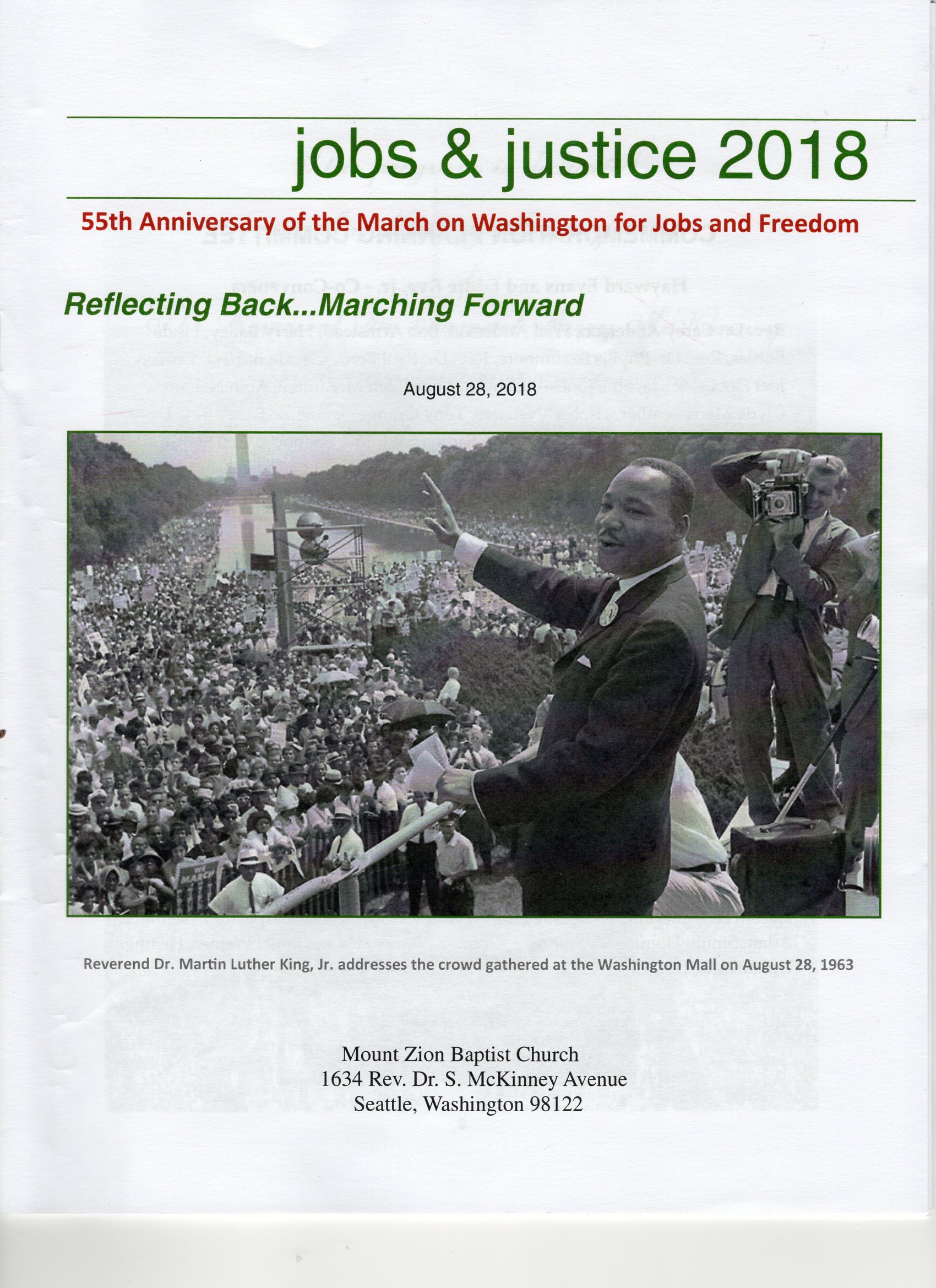
It was a moving and memorable event.

The march launched the campaign to repeal I 200 and the encouragement to sign the petition for I 1000 that will negate I 200. I 200 eliminated Affirmative Action ( we are one of only 8 states that have repealed it). It was an early example of Tim Eyman and allies such as Wade Connerly from California, pushing through a right wing petition. It said “The state shall not discriminate against, or grant preferential treatment to, any individual or group on the basis of race, sex, color, ethnicity, or national origin in the operation of public employment, public education, or public contracting.” I 1000 would repeal that. It is hoped to put it before the State Legislature in January.
In the video taken by Christina Lopez two youth (seen here) recite the vast impacts of the tossing out of Affirmative Action for workers, students, and many other groups. A bell tolls after each statement. 
Inside we had speakers that included a rabbi, Daniel Weiner, a leader of the American Muslim Empowerment Network, Aneelah Afzali (a fabulous speaker), Native American spoken word, by Quinault Indian Nation member, Heather Upham, Legislators, community activists, ( such as Jorge Baron, head of NWIRP) Reverend McKinney’s daughter, Dr. Lora-Ellen McKinney, who honored over eighty people who “fought for freedom, justice and the dignity of all people”. Here she is with a photo of the famous Jacob Lawrence.
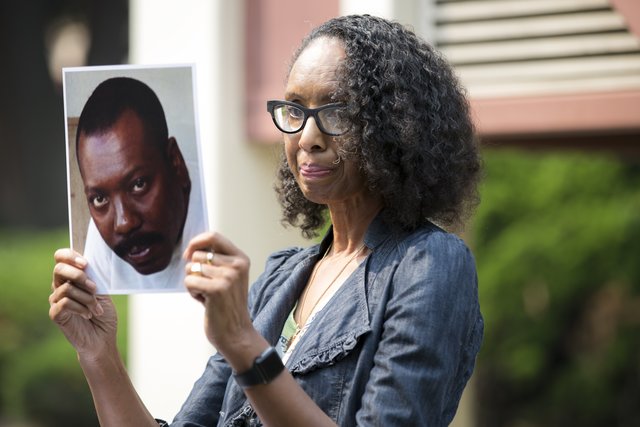
and much more. It was wonderful to have everyone coming together. The singing of”Lift Up Your Voice and Sing” by Josephine Howell, brought tears to our eyes, the music captured by Christina Lopez.
Likewise the Mayor’s Arts Awards two days later reached out to many communities with awards to individuals:
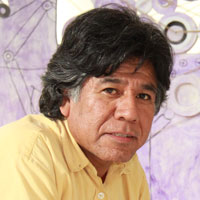
Fulgencio Lazo, my good friend and outstanding artist, who connects us to Oaxaca Mexico. Studio Lazo, an organization of artists and community members especially showcases the creativity of Latino artists, writers and musicians.
Tarik Abdullah a local chef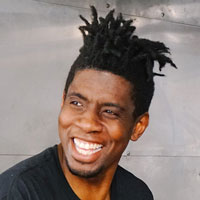 artist, innovator, and community activist. His culinary creations honor traditions from North Africa and the Mediterranean; his artistry comes through not only in his food, He cooks with the younger generation by teaching week long summer camps called “In the Kitchen with Chef T”
artist, innovator, and community activist. His culinary creations honor traditions from North Africa and the Mediterranean; his artistry comes through not only in his food, He cooks with the younger generation by teaching week long summer camps called “In the Kitchen with Chef T”
Karen P. Thomas a musican who is encouraging non binary identity for singers traditionally divided into Men’s choruses and Women’s choruses. She has been artistic director and conductor of Seattle Pro Musica since 1987.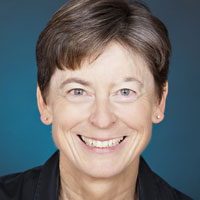
Jorge Enrique Gonzalez Pacheco, a Cuban poet and film maker. He is Founder and Chief Programmer of the Seattle Latino Film Festival (SLFF),
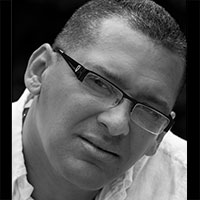
Paula Boggs, musician, public speaker, fundraiser and philanthropist. She is also a Board Member of numerous for-profit and non-profit organizations. Boggs and the 6-piece Paula Boggs Band traverse jazz, world, rock and Americana.
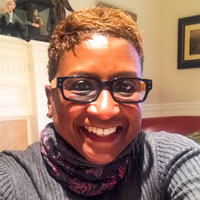
For the first time, cultural categories were broadened beyond traditional definitions of art and culture. I think it was a great idea. I was also happy to see the move to individuals who build community, instead of mainly established cultural organizations (although they are all exceptional also).
The third event was “Decolonizing Immigration” at the Seattle Public Library on the same night as the Mayor’s Arts Awards.
Organized by Davida Ingram, it also made a point of being inclusive.
We began with wonderful 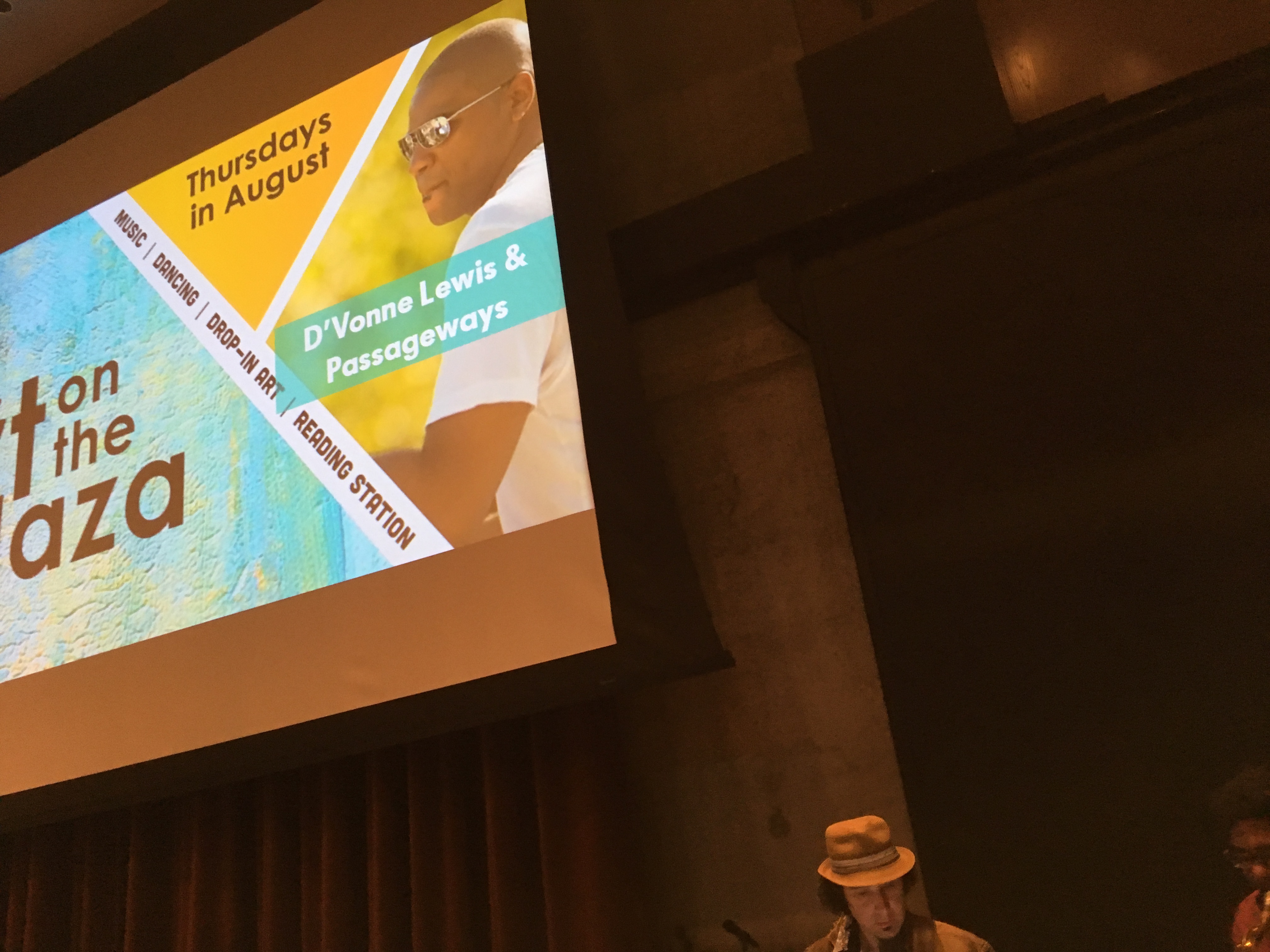 music by D’Vonne Lewis and Pathways.Passageways—Drummer D’Vonne Lewis’ new group celebrates the Black Diaspora from Seattle’s rich African-American jazz heritage to rhythms from South Africa, Central America, and Senegal. Passageways is: D’Vonne Lewis, Ari Joshua, Alex Dugdale, and Thione Diop.
music by D’Vonne Lewis and Pathways.Passageways—Drummer D’Vonne Lewis’ new group celebrates the Black Diaspora from Seattle’s rich African-American jazz heritage to rhythms from South Africa, Central America, and Senegal. Passageways is: D’Vonne Lewis, Ari Joshua, Alex Dugdale, and Thione Diop.
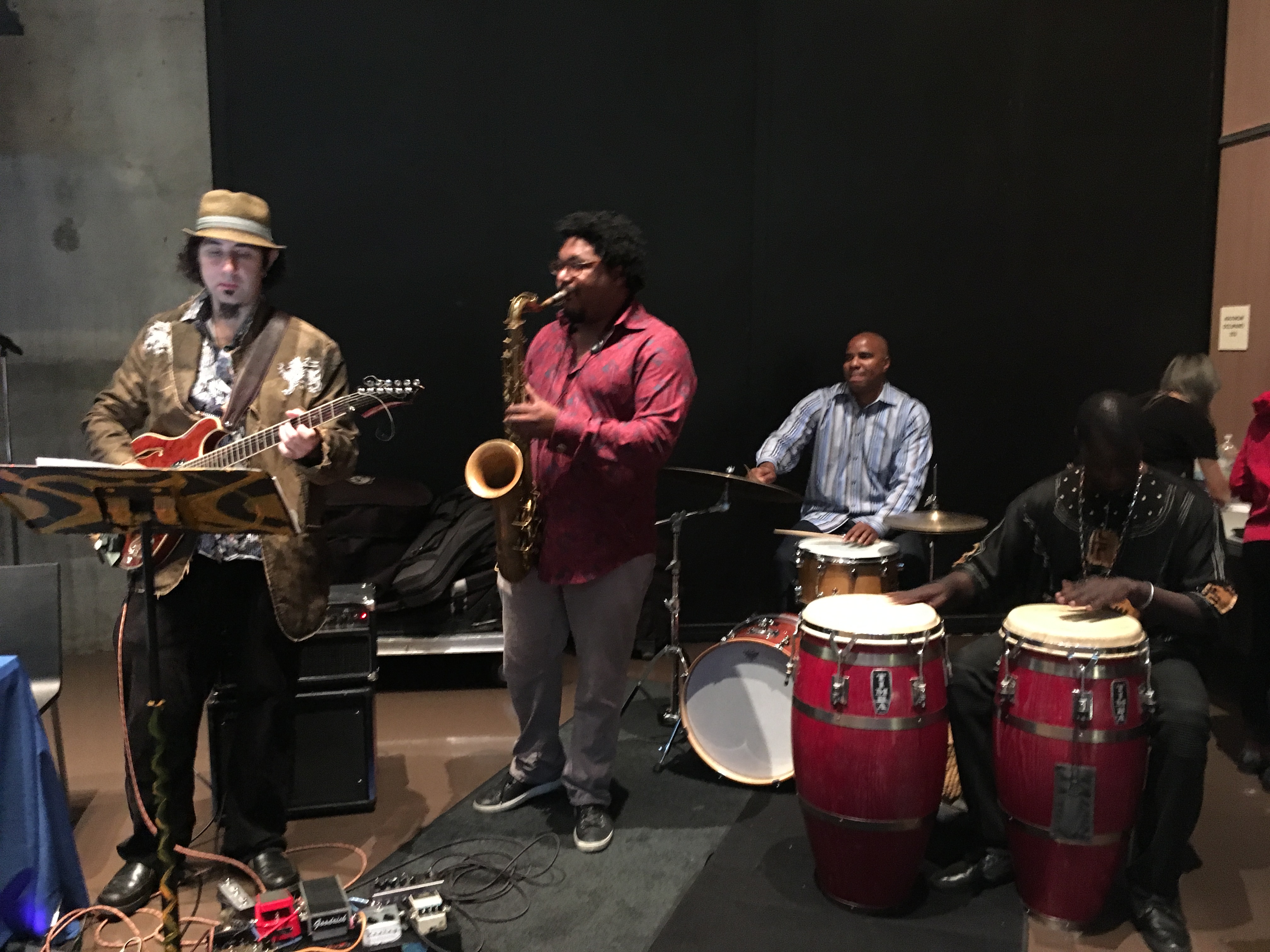
We had the history of immigration law by Enoka Herat of the ACLU who also defined what “decolonizing immigration” means. Notice “Turn and Talk” : we were asked to speak to our neighbor about our own story.

“To decolonize immigration, we must decriminalize and demilitarize enforcement against Indigenous, Black and Brown people. We must build a system that centers the power and humanity of immigrants, recognizing that migration- for love, opportunity, health, refuge is a fundamental aspect of being human.” Enoka Herat
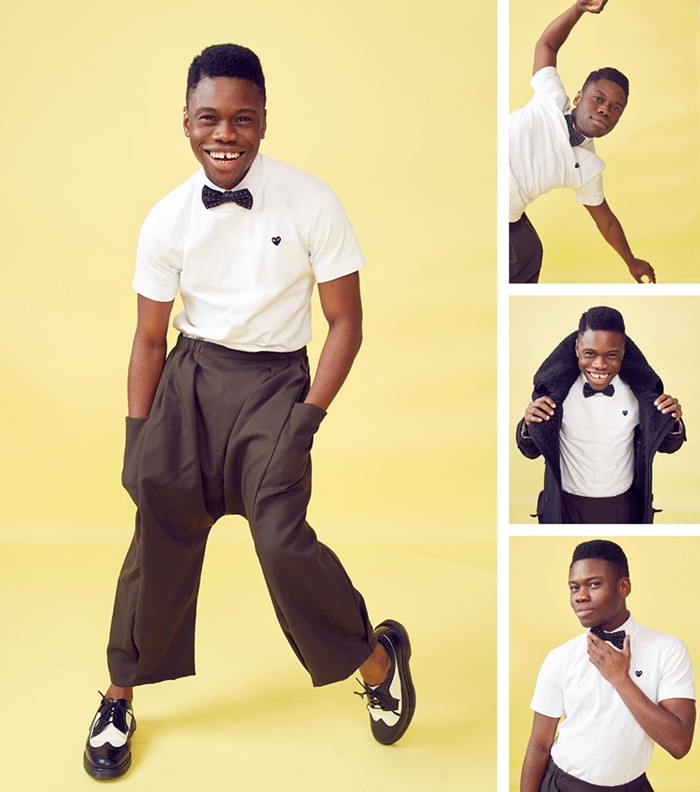
We also had an interactive dance led by the incredibly charismatic David Rue that we all took part in. We were divided as an audience into three rhythms. Rue also spoke as an immigrant from Liberia ( indigenous Liberian, in contrast to the Americans who were encouraged to migrate there in the “back to Africa” era).
Ken Workman Duwamish Tribe fourth generation great grandson of Chief Seattle opened the event.
We heard from three poets learning English as a second language in a special program at the library. Their poetry that is published in a small book Learning to Love America
here is a short excerpt from Roberta Mocanu , born in Romania
My Roots
“I am an immigrant
Of the world
Why don’t you listen?
When I tell you my roots are bleeding”
….
Tom Ikeda spoke of Japanese detention camps and later oppressions, The Japanese are acutely aware of the illegality of detention and its arbitrariness.
I left as David Rue was speaking about his journey from Liberia.
Other participants who spoke were
Ellany Kayce Native activist
Graciela Nuñez Pargas Journalist,
Hodan Hassan social activist, feminist, climate justice organizer
Tuesday Velasquez
There will be a podcast which I will link when it is online.
It was not simply a sit and watch evening: the message was you are part of the community, you are part of the issue, you are part of the story. You are part of the solution.
Hats off to everyone. All in one week. Hurray for Seattle.
This entry was posted on September 4, 2018 and is filed under Uncategorized.
Indigenous Artists and Contemporary Environmental Issues Part II
The despoliation of Indigenous reservations through fossil fuel extraction, pipe lines, uranium mining, and many other disastrous environmental policies, is a subject of the work of several prominent
Indigenous artists. Currently on view is the work of John Feodorov in the exhibition “In Red Ink,” curated by RYAN! Feddersen at the Museum of Northwest Art, La Conner
His four part work “Desecrations” :
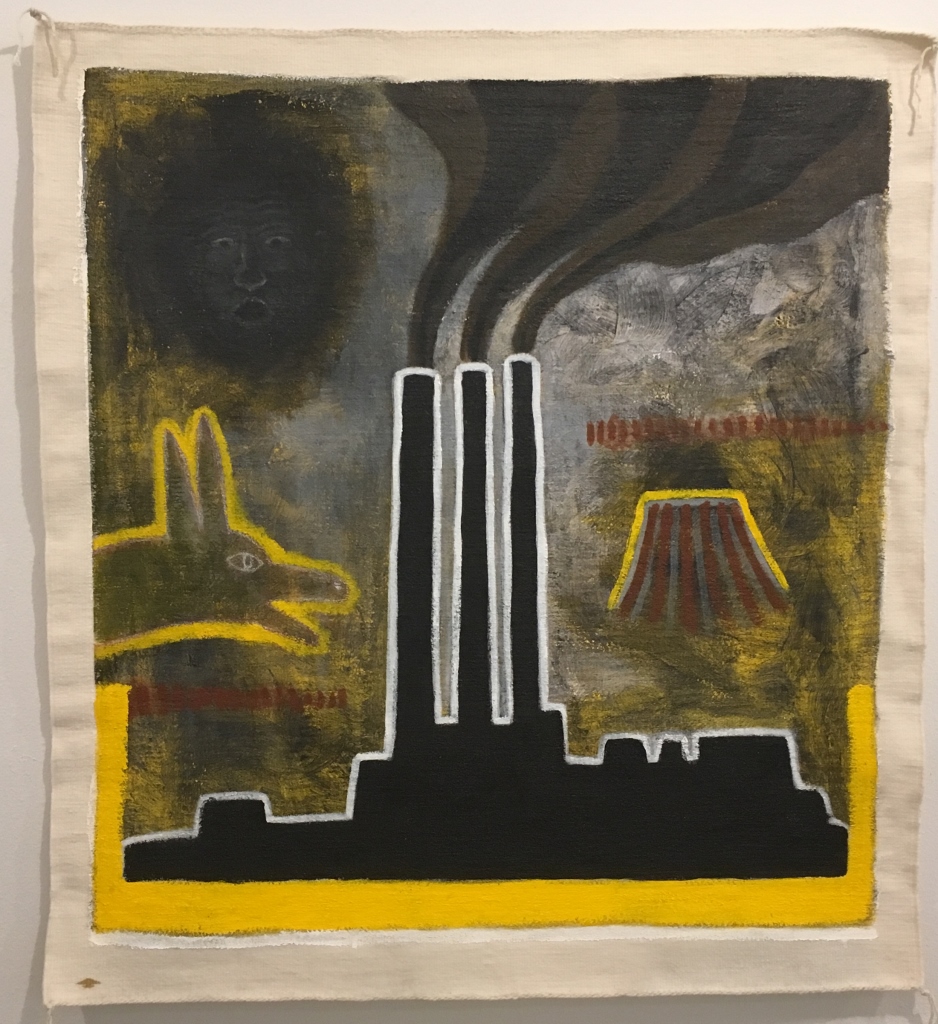
#1the Coal plant
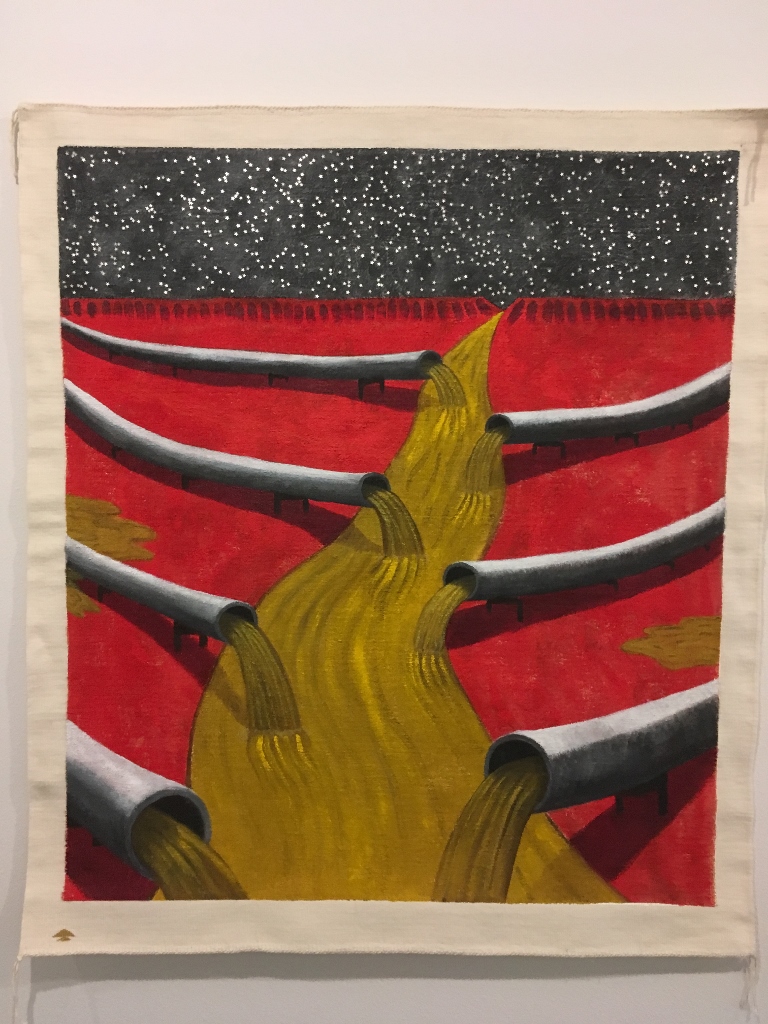
#2 the pipe lines
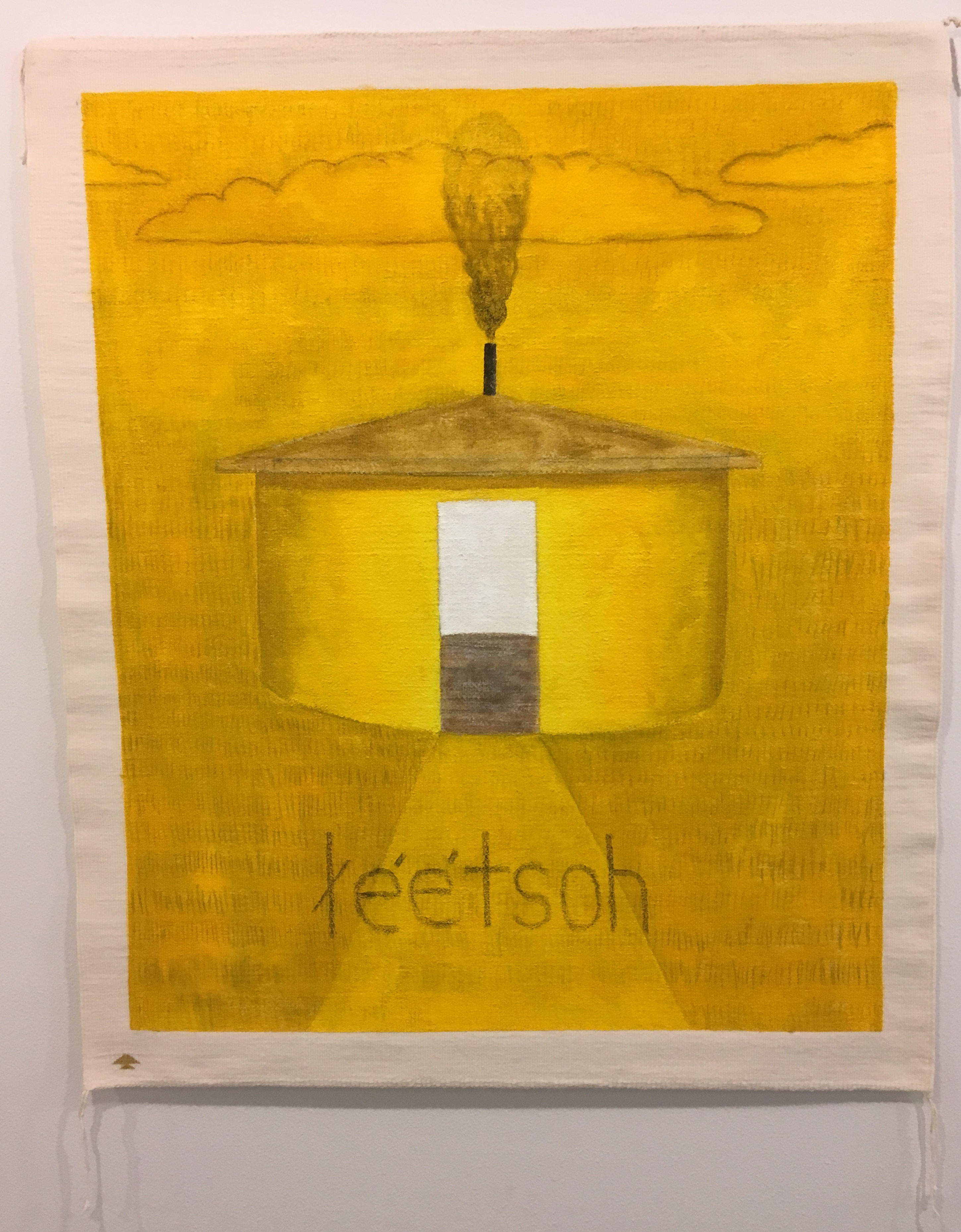
#3 the yellow radiation house
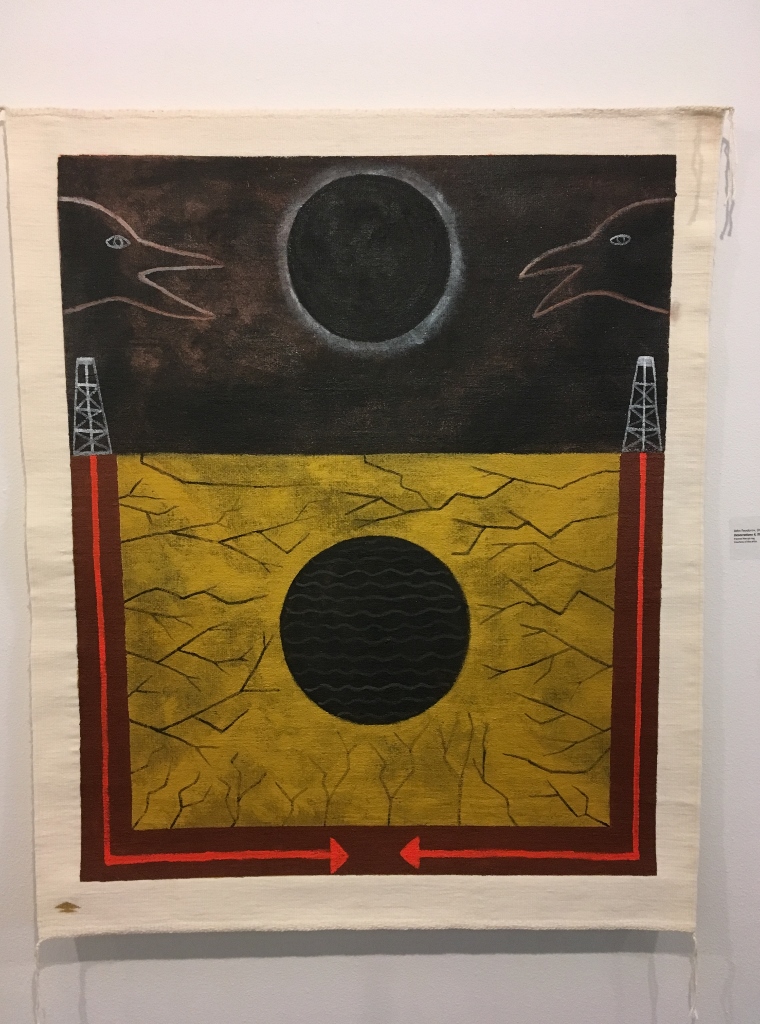
#4 fracking cracks in the earth
He painted these images on specially woven white Navaho rugs created by Navaho master weaver Tyra Preston.

Feodorov explained that as he painted on the rugs, he felt he also was committing an act of desecration:
“The series responds to ongoing environmental threats to traditional Diné lands and communities (including toxic pollution caused from uranium mining, coal burning, and fracking), as well as the exploitation and pollution of indigenous land around the world. But, it also refers to my hesitation in painting upon Tyra’s beautiful weavings.
“Just as Native lands are under constant threat, so are Native cultures. For me, these rugs act as metaphors for both land and culture. By painting upon them, perhaps I have also desecrated them? My mother taught me that weaving is a sacred art, taught to our Diné people by Spider Woman. So it was with some hesitation and great respect that I decided to undertake this series. Understandably, Tyra asked many probing questions of me before agreeing to participate, as well as consulting with a Navajo elder/medicine man from her community. I wish to thank Tyra Preston for weaving these gorgeous rugs, without which this series could not have been realized.”
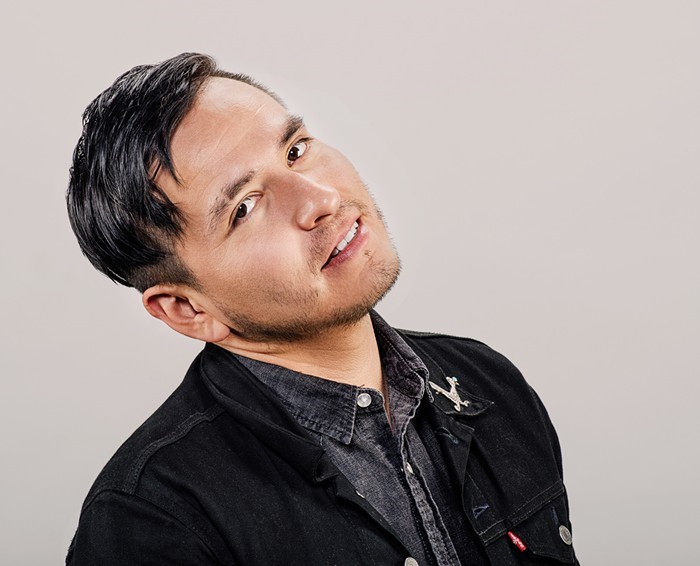
A second Navaho artist is addressing nuclear pollution on the reservation: Demian DinéYazhi’ (photo by Patrick Weishampel) is currently showing an installation at the Henry Art Gallery, University of Washington as a result of winning the Brink Award. His work includes poetry, sculpture, and video intersecting to create a powerful statement.
It begins with confronting us as viewers with a manifesto presented in segments on a video screen:
“By entering this space you have agreed
To become a lifelong agent
Against humanitarian
And environmental injustice
You have agreed to forfeit your racist misconceptions
of Indigenous identity & respect the sacredness
of Indigenous traditional practices
You are not stepping into the past or staring into a
Picture plane void of Indigenous inhabitants
You are not glorifying western historical inaccuracies
Or romanticizing the cowboys and Indians narrative
By entering this space you agree to never again place
Your hand over your mouth in a mock “war cry”
Or teach your children to be ignorant of the
Indigenous peoples whose land you
Have claimed as your own
From this moment onward you have agreed to learn
The history of the Indigenous ancestral lands
That were stolen & continue to be stolen
Through settler colonial violence
&environmental genocide
By entering this space you have agreed to center
Your politics, social movements & institutions
Of knowledge around the Indigenous peoples
Whose lives & cultures were forever altered
In pursuit of this post-apocalypitic
heteropatriachal colonial nightmare”

The space itself includes more poetry presented in a slide show and with reference to a huge uranium spill that occurred at Church Rock, New Mexico in 1979.
I am going to insert here Emily Pothast’s excellent article in the Stranger, based on her interview with the artist:
“In July of 1979, a breached dam at Church Rock, New Mexico, sent more than a thousand tons of radioactive waste tumbling into the Puerco River. Despite being the largest release of radioactive material in US history, the incident received almost no media coverage. Many residents who used the river for irrigation weren’t even notified, and the governor denied local requests to declare Church Rock a federal disaster area.
“Nearly three decades later, a team of public-health researchers linked the negligence to racism. The Puerco River flows through what settlers call the Navajo Nation—known in the Diné language as Dinétah—and the spill primarily affected rural communities on the reservation.
“Today, abandoned uranium mines dot the landscape like open wounds along what was once Route 66, lit up by garish neon signs advertising “Indian jewelry” to non-indigenous tourists. Many of these sites have not been cleaned up, and probably won’t be cleaned up.”
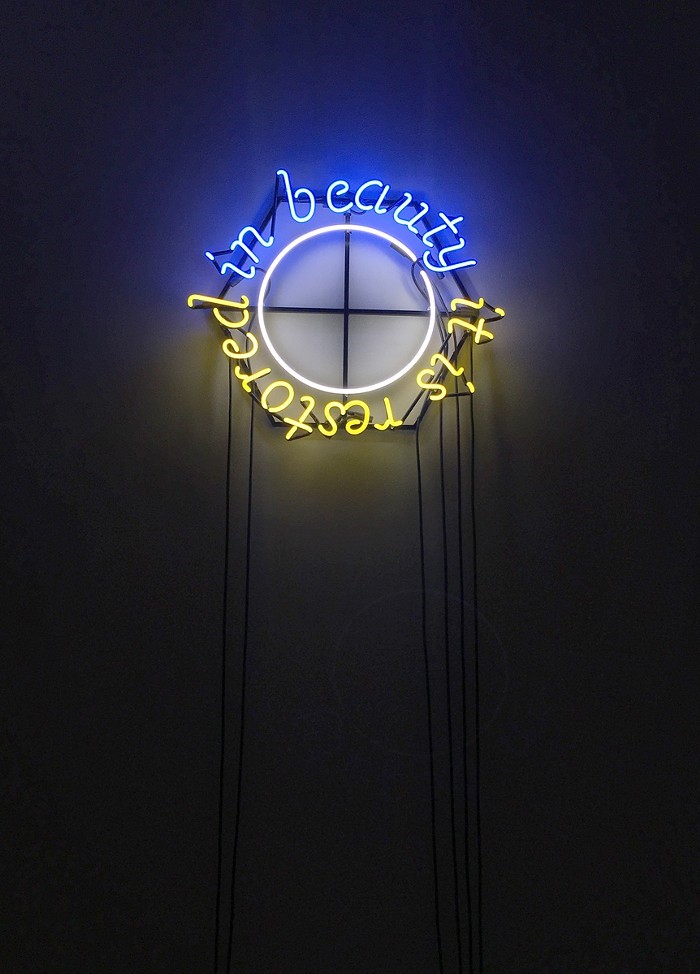
PHOTO BY EMILY POTHAST
“There are two pieces in the current exhibition by Demian DinéYazhi’ at the Henry Art Gallery that address this ongoing history head-on. The first is in beauty it is restored, a circular neon sign that glows like uranium but also reflects the balance of Navajo cosmology and the power of ceremony to make things whole again. The second is Hey Jolene, a visual poem projected from an analog slide projector onto a billboard-shaped screen. Its text extends the metaphor of toxic phosphorescence to the warm glow of an alcohol-soaked liver. Unlike many of the artist’s pieces, which pair texts with family photos and images of landscapes, the background behind these words is crimson.
“I use red a lot as a way to maintain an indigenous aesthetic,” says DinéYazhi’. “This is actually my finger pressing against the camera lens pointed toward the sun.”
“As for the text: “It’s about a friend who passed away a few years ago on her reservation. It’s one of the only pieces that addresses a specific individual, but this story line is very similar to every other indigenous person’s story within the Gallup region.”
“The artist’s hometown of Gallup sits just outside the Navajo Nation, some 17 miles south of Church Rock. DinéYahzi’ describes it as a colonized border town, a place where indigenous and Western worldviews intersect.
“The way land art has been constructed within contemporary art practice is to usually leave a mark against the land,” says DinéYahzi’. “Within an indigenous framework, it’s not about leaving your mark on the land, it’s about honoring a region as much as possible. Photography is a safe site to have an experience of the land that isn’t necessarily continuing in this legacy of taking or extracting.”
Another site of colonization that the artist’s work addresses is gender. “The Navajo tribe had four to five different gender systems,” they explain, adding that now there are elders who side with the assimilationist agenda as an expression of trauma incurred through settler violence. “Coming back to the ceremonial framework is a way to heal as a community.”
Thank you Emily Pothast for this clear explanation!

The third visual artist who has addressed contamination on Indigenous reservations for many years is Gail Tremblay. I have frequently reviewed her exhibitions on this topic which include video interviews, poetry by Arthur Tulee, large felt sculptures of lungs contaminated by cancer, and scientfic images of cancer contamination.
Here is one piece I wrote about at Daybreak Star gallery for the literary magazine Raven Chronicles in 2002:
“Iókste Akwerià:ne: It is Heavy on My Heart A room sized installation with large felt sculptures or organs with cancerous tumors, DVD, audio tape of singing, color copies of cancerous organs and cells, small felt sculptures of spiderwort, normal and irradiated.
The installation takes us over, rather than the other way around. It has a larger than life scale. Built out of felt, huge tumors grow on Lungs and Diaphragm and the Thyroid Gland. The cancerous tumors inhabit the room on the scale of human bodies, they invade our spirits, they invade our feelings. The felt surfaces seduce us with their beauty, but at the same time, the organs speak to us. Unlike the mute dolls, these organs speak; tell us their story, they testify, through the voices of many different Indians and many tribes, through images of cancer infected fish and polluted landscapes. They weave a tale of betrayal, the old tale and the new tale. The tale of the nuclear industry, its assault on traditional native lands, its campaign to deposit its waste on Indian lands, its careless removal of Indians or cajoling of Indians with money. The elders speak of the illness that the nuclear industry and its invisible radioactivity causes in their tribes, birth defects, growth delays, leukemia, skin diseases, asthma, heart disease, cancer, breast, lung, colon, prostate. They reply with legends, with poetry, with a clear alternative to the stealing of the insides of the earth, they speak of their way of life, their principles of living in the land, but not gaining from it. Grand Canyon, Navaho, Hvasupai, Laguna, Acoma, Shoshone, Peyote Yakima Colville, Wishwram, Prairie Island, Apache Choctaw. Sioux. These are the tribes of the tellers of the tale.
The poet Arthur Tullee wearing a bright red shirt recites his exquisite poems of legends of death,sickness, and healing. ”
In addition to these three artists we have the wide and ongoing resistance by writers, poets, visual artists, activists and the general public to the Kinder Morgan pipeline outside of Vancouver. The link is to a poetic video by an articulate young Indigenous woman.
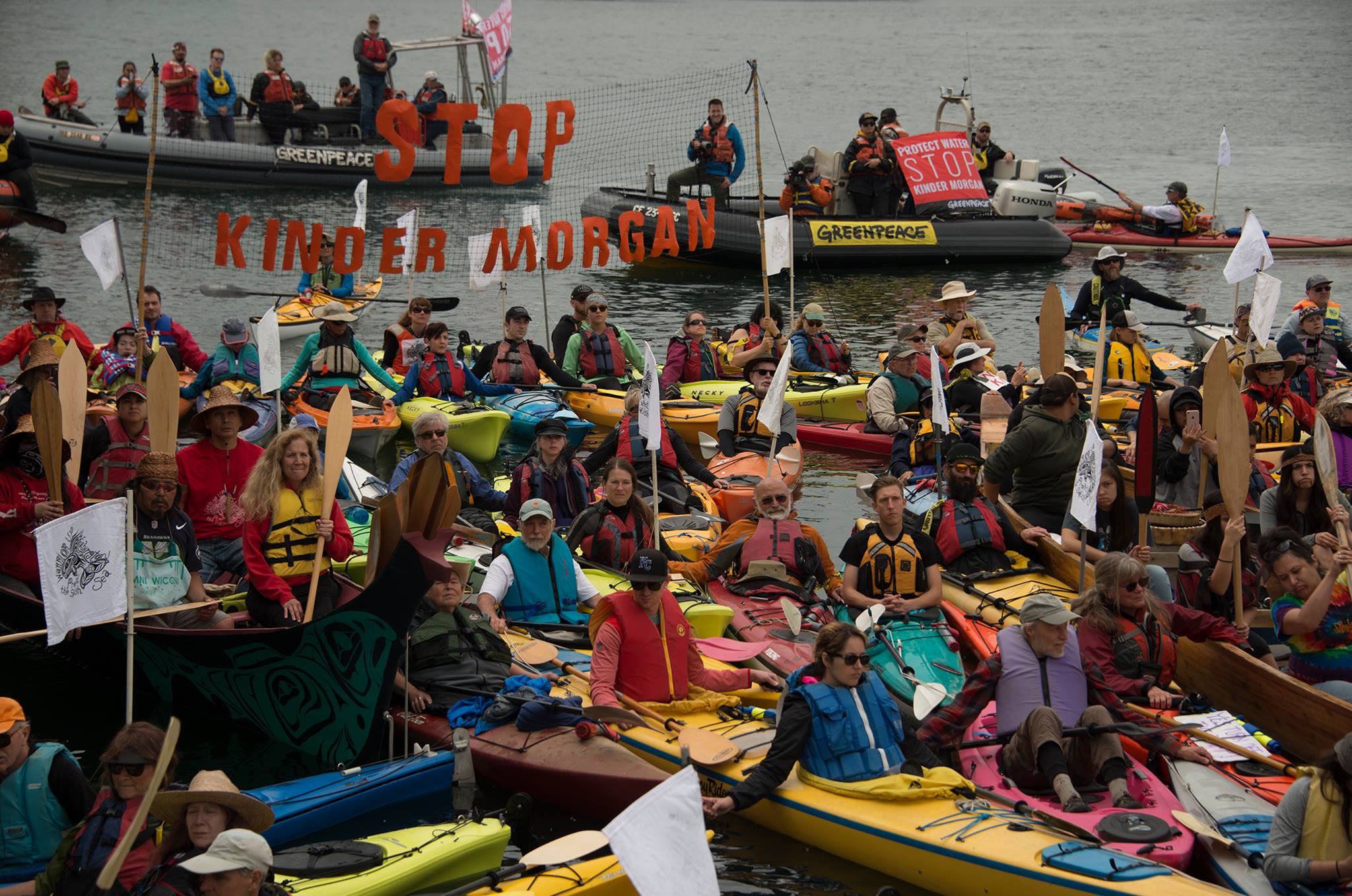
As of today, arrests are going on, and the destruction of protest camps is continuous. But the resistance is strong.
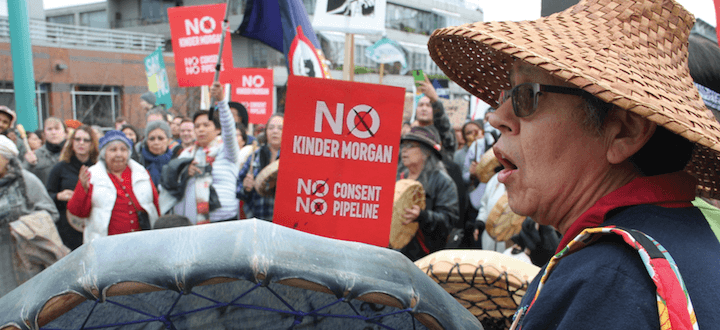
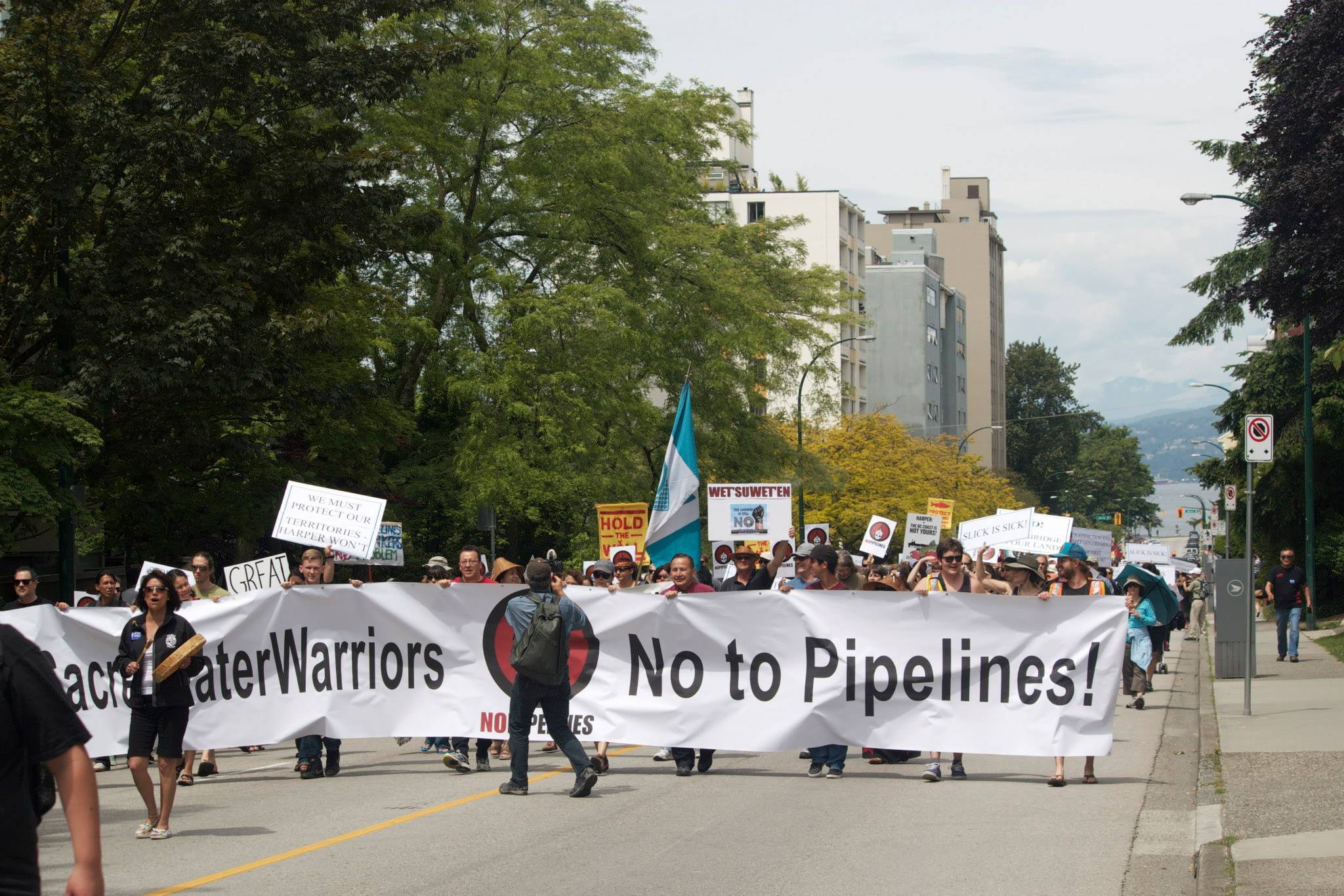
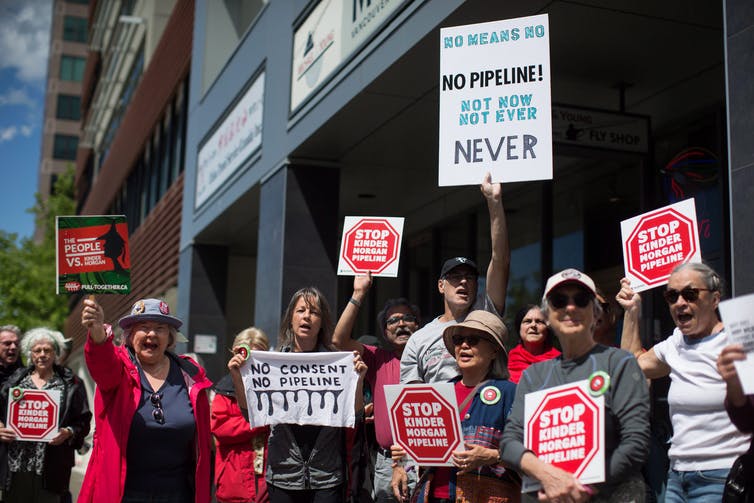
The Transmountain pipeline is on an existing route, but the plan is to triple its capacity. The protests have been in Burnaby outside of Vancouver BC all summer. Currently the Canadian government is looking for a buyer, since Kinder Morgan did back down and the government bought it with public funds -so much for Pierre Trudeau’s environmental credentials.
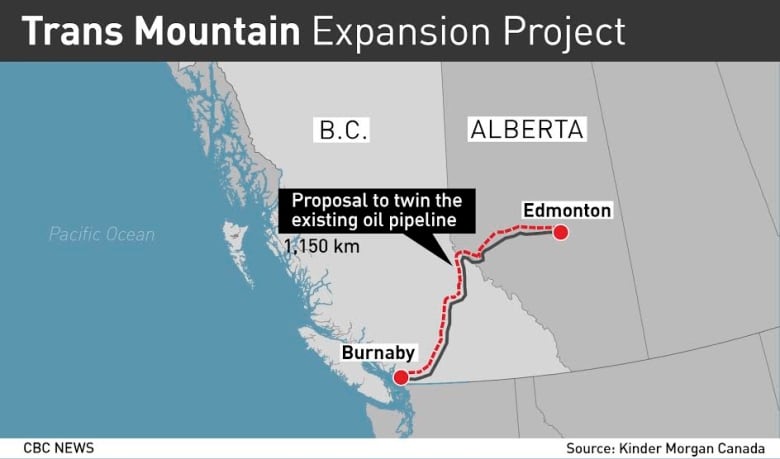
“Those arrested included 50-year-old Rita Wong, a poet and professor at Emily Carr University who organized Friday’s action on behalf of missing and murdered Indigenous women, according to a statement from Protect the Inlet, one of the many groups that oppose the Trans Mountain pipeline.
“The expansion of this pipeline would pose an increased risk to Indigenous women through displacement and man-camps, as well as everybody on Earth, through further climate destabilization,” she said in a statement, adding that “more people to make the connections between violence against the land and violence against Missing and Murdered Indigenous Women.”
“Wong was placed in what looked like a black lawn chair and carried away from the scene Friday
“Mairy Beam, Kathryn Cass and Deb Wood, who are all in their 60s, were also arrested.
“I was nervous, but also very proud to take a stand and to take a stand for Mother Earth and to stand for my granddaughters,” Beam told CTV News.”
This entry was posted on August 25, 2018 and is filed under ecology, indians, Indigenous activism, Indigenous Art, Uncategorized.
Indigenous Artists and Contemporary Environmental Issues Part I
Indigenous protests win Victory over Pipeline August 30 2018
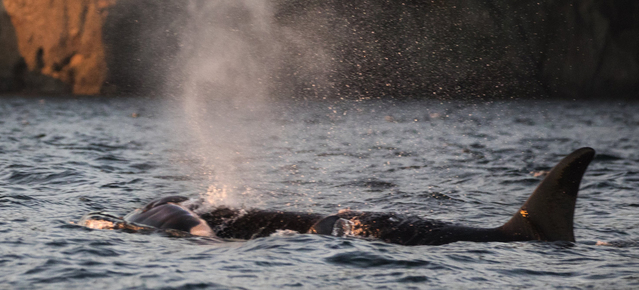
We cried every day as we followed the tragedy of the Orca mother Tahlequah holding her dead baby for 17 days. The pod she belongs to has not had a successful birth in several years, this baby died immediately after it was born.
The resident population of this Southern Resident pod is dying for lack of Chinook Salmon. It consists of only 75 whales. They are also disrupted by vessel noise (especially cruise ships) and toxins. Solutions are quieting vessel noise, less development in habitat , and breaching lower Snake River Dam. It is a huge job that requires going beyond token gestures, like not eating Chinook Salmon. Katie Kurtz outlines the pollution problem clearly and the urgency of supporting the superfund clean up of the Duwamish which is of course being rolled back by the current administration. Read her article “To Save the Orcas We must clean up the Duwamish.
The Lummi tribe consider the Orcas as family members. They refer to them as qwel ihol mechen or “The People who live under the sea,”.
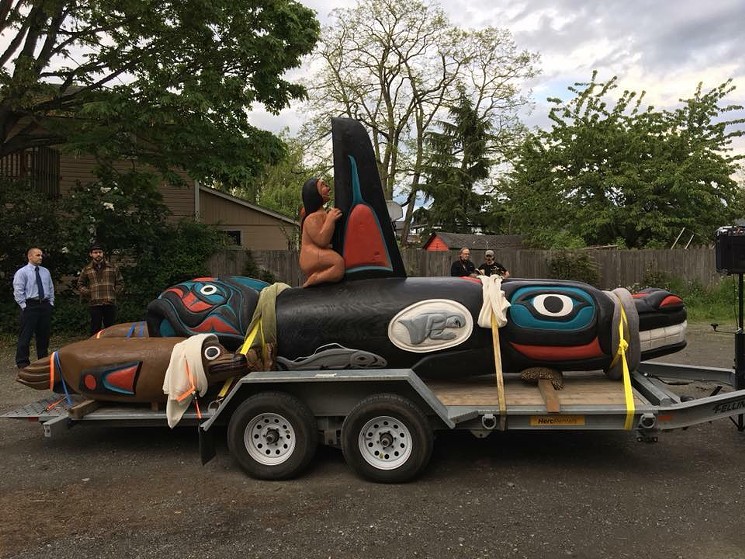
Before this summer of grief, the Lummi carved a totem dedicated to Tokitae, the last survivor of a horrendous capture of baby orcas in 1970 when a third of the population of this same pod of Southern Resident orcas were taken by aquariums for display. Three died during the capture. Tokitae is at the Miami Seaquarium.
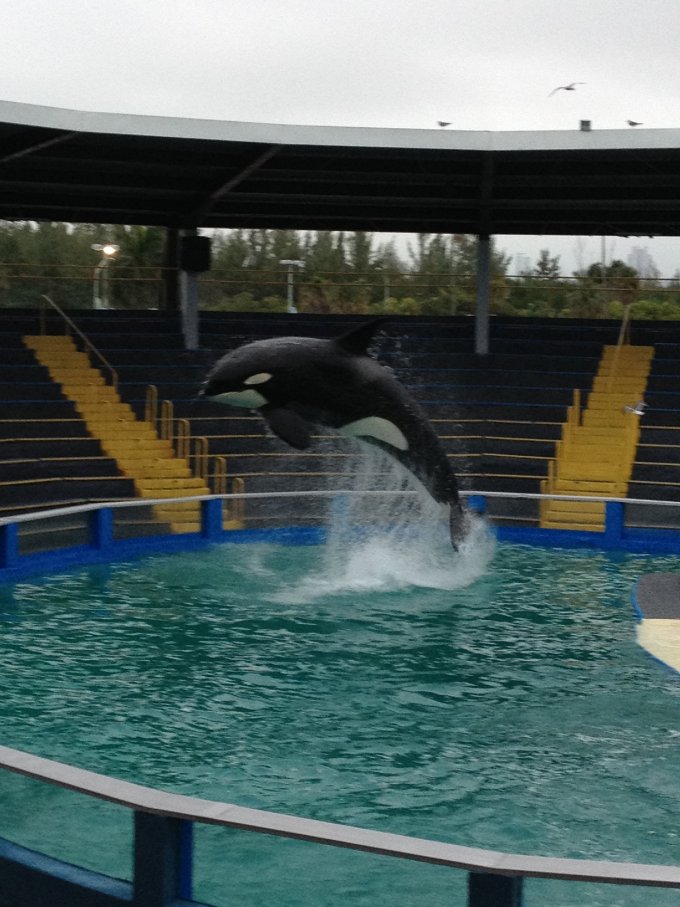
She is know as Lolita there and lives in an illegally small tank where she performs tricks for audiences. The Aquarium has refused to allow Tokitae to return to her family in the Northwest. When the totem reached Miami ceremonies were held outside the aquarium, but no one was allowed to come in.

At the same time the Lummi are collaborating with the National Oceanic and Atmosperic Administration to try to feed a wild orca in the same Southern Resident pod, who is starving to death. This is a risky and unprecedented operation, as Orcas are very smart and could entirely refuse or become aware of human feeding. The analysis is that she may have worms or an infection of some kind that is preventing her from eating.
Orcas eat about 420 pounds of Chinook Salmon per day.
This magnificent mammals are incredibly bright. During the capture of babies in the 1970s one of the witnesses spoke of the gathering of the pod around the capture site, their obvious grieving at the loss of their babies, loud crying. Once the babies had been removed in a truck, the rest of the pod left the area never to return.
Does this not sound familiar, as children are ripped from their parents and sent off to captivity. This is no longer in the news, but the children are still being detained.
I want to end with Gloria Bornstein’s beautiful Whale sculpture at Seattle Center. We need a lot more beautiful art like this that celebrates these special creatures. 
I want to acknowledge the incredible reporting of Lynda Mapes at the Seattle Times on this summer of grief and crisis with our Southern Resident orca pod.
This entry was posted on August 24, 2018 and is filed under ecology, First Nations Art, Uncategorized.
The stunning Olympic Peninsula with brief visits to three Native American tribal cultural events

Oh how fortunate we are in the Northwest to have the Olympic Peninsula! It is magnificent in mid July. We just completed a wonderful trip there, two nights at a cabin on Neah Bay.

We did the short walk to Cape Flattery, the furthest West point in US


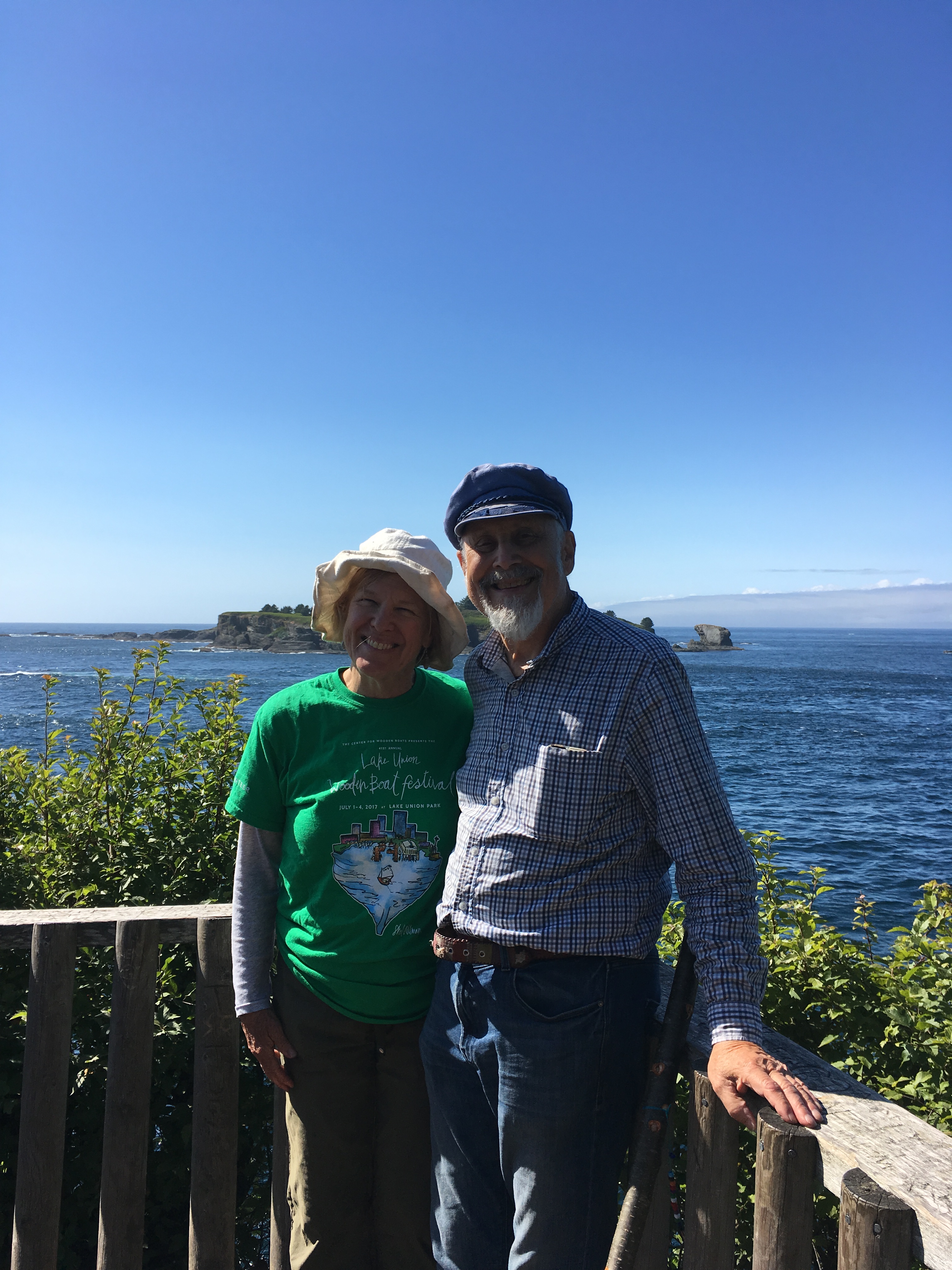
and two nights camping at the Mora campground, near Rialto Beach and La Push. That is Henry and his magnificent blueberry pancake
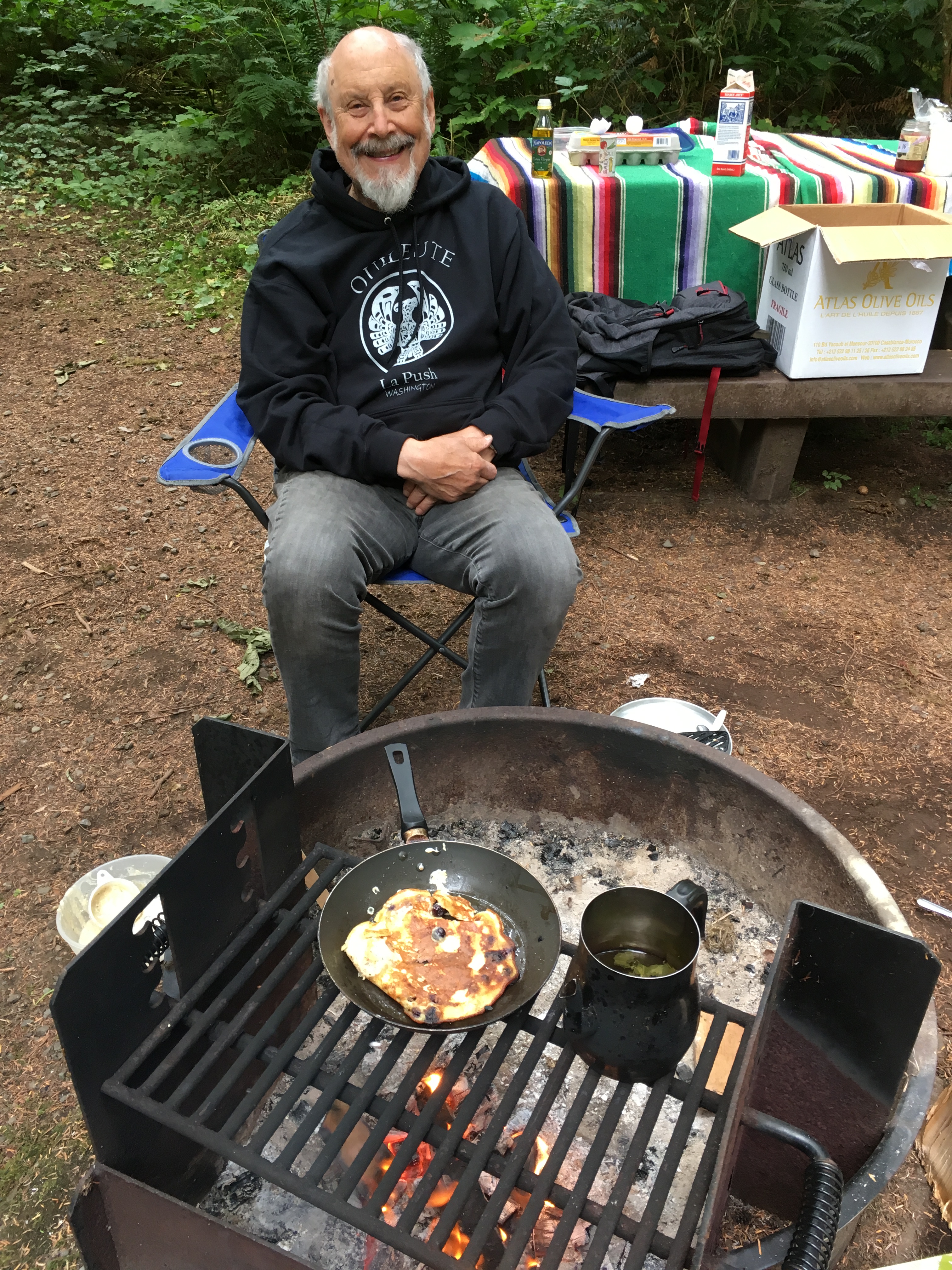

It was cloudy at Rialto Beach, but it is one of the most beautiful beaches in the world in my opinion, and part of one of the few wild seacoasts in the continental US, jointly managed by the Olympic National Park, Olympic Coast National Marine Sanctuary and the offshore National Wildlife Refuge.
Sadly, in spite of all this protection, plus the collaboration with Native tribes, our Orca population is declining rapidly, a baby Orca died today. Apparently they are starving because of reduced salmon runs. And our detestable national government is gutting the Endangered Species Act, adding yet another threat to the Orcas. At this time there are about 74 left.
Returning to a more joyful topic:
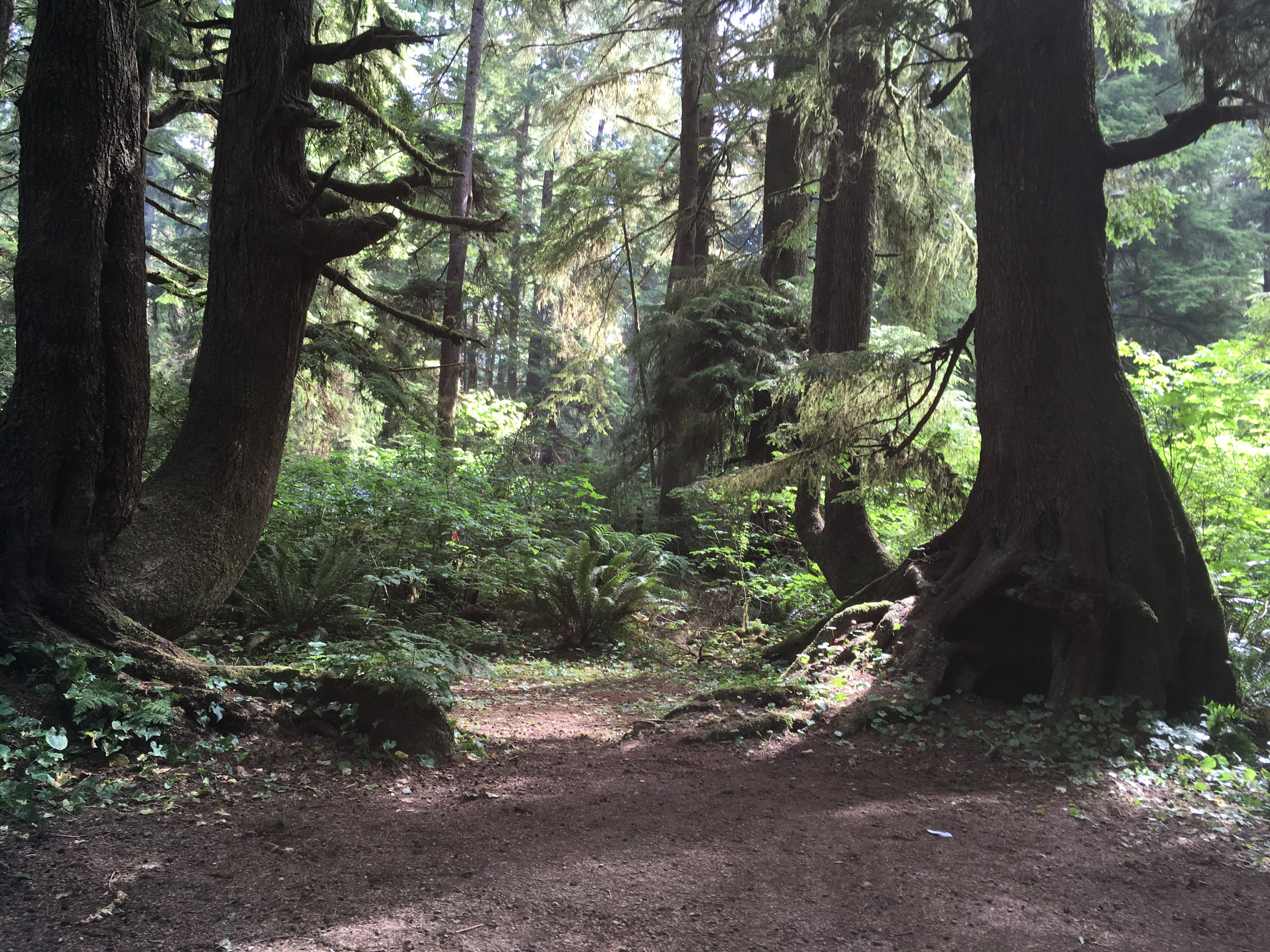
Our campsite was surrounded by old trees (not quite old growth, but almost). We had a stunning pair of trees near us with hollowed out bases. As we walked on the trails we saw other ancient trees with entangled roots that for me always resemble creatures.
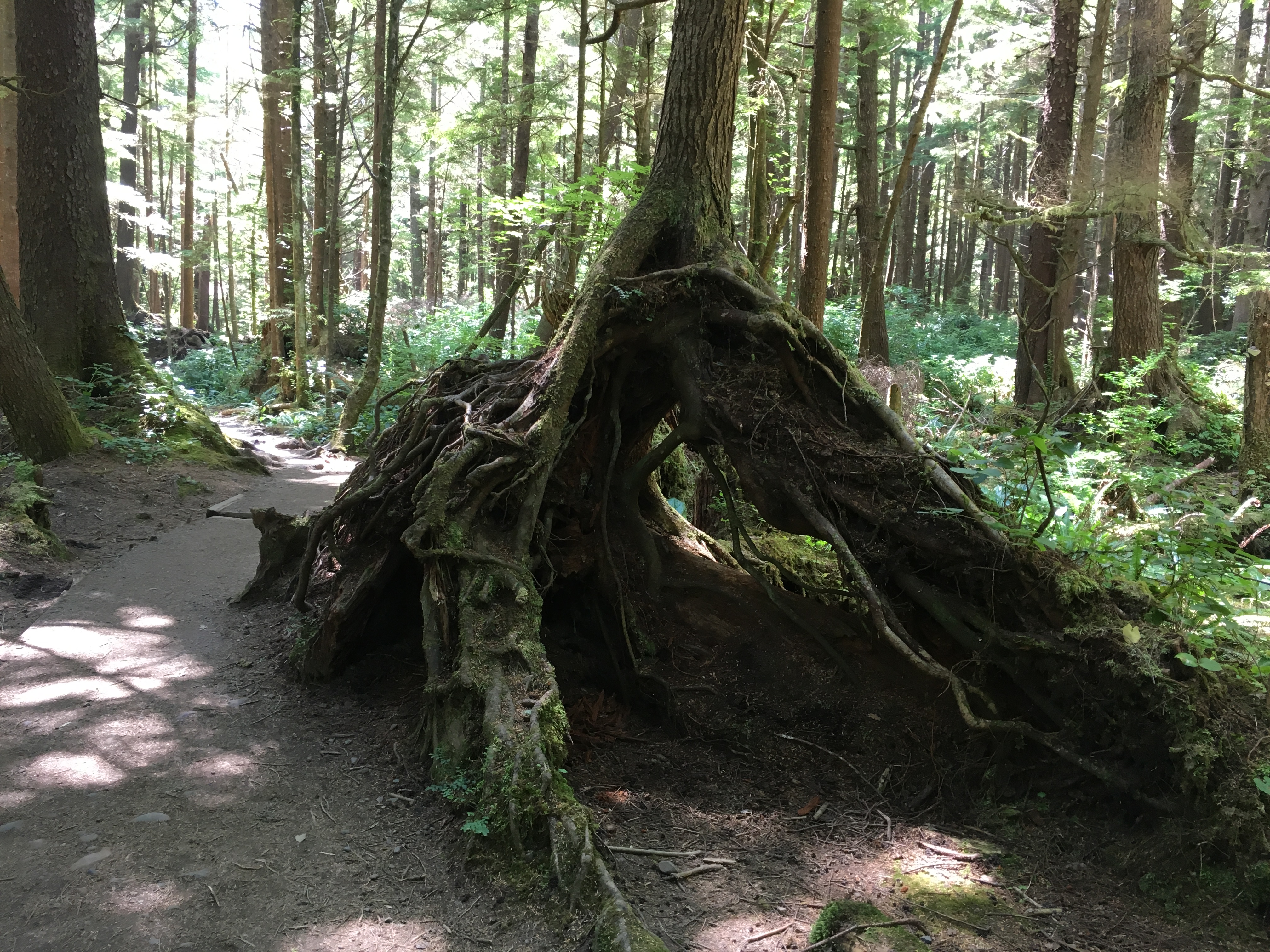

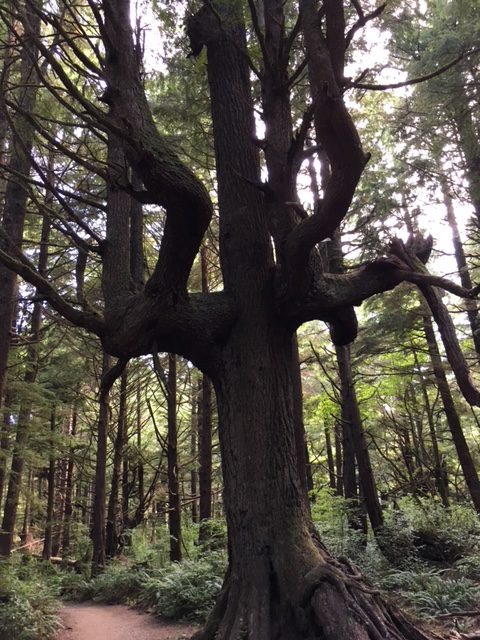
And these oddly bent branches on the trails.
I am prolonging our experience by looking at these photographs again. Henry did a wonderful job.


Part II
The Olympic Peninsula has many distinct Native tribes. We intersected with only three, first the Suquamish, right after the Agate Point bridge, live on what is called the Point Madison Reservation.

We visited their museum

for the exhibition, “Deconstructing Curtis Exhibition” a comparison of Edward Curtis photographs and those of the Suquamish Archive belonging to the museum of the same people, or the same place. It was fascinating, underscoring both Curtis’s skill as a photographer and his European romanticism.

Basket Maker, Suquamish archival photograph
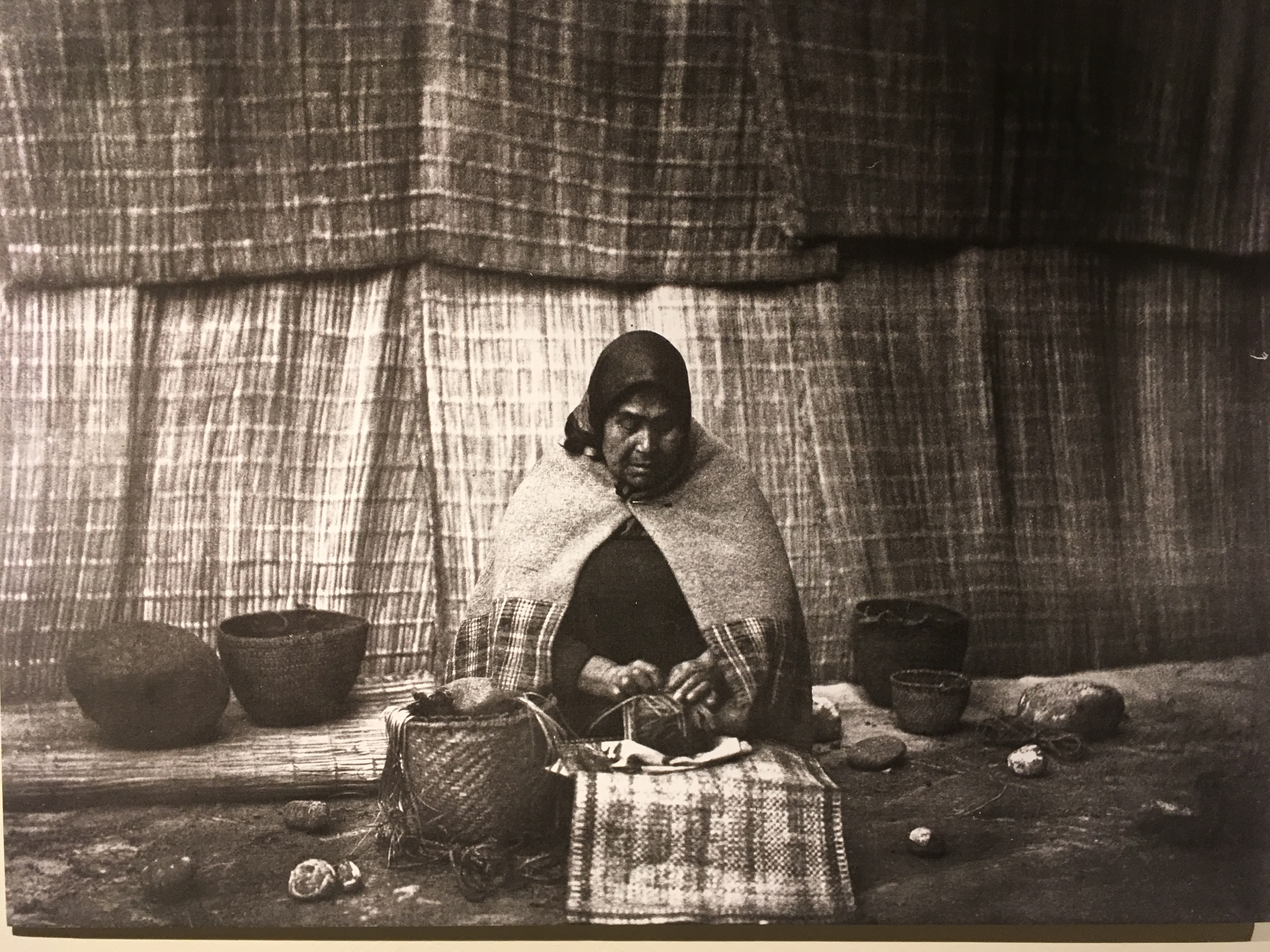
Edward Curtis Basket Maker
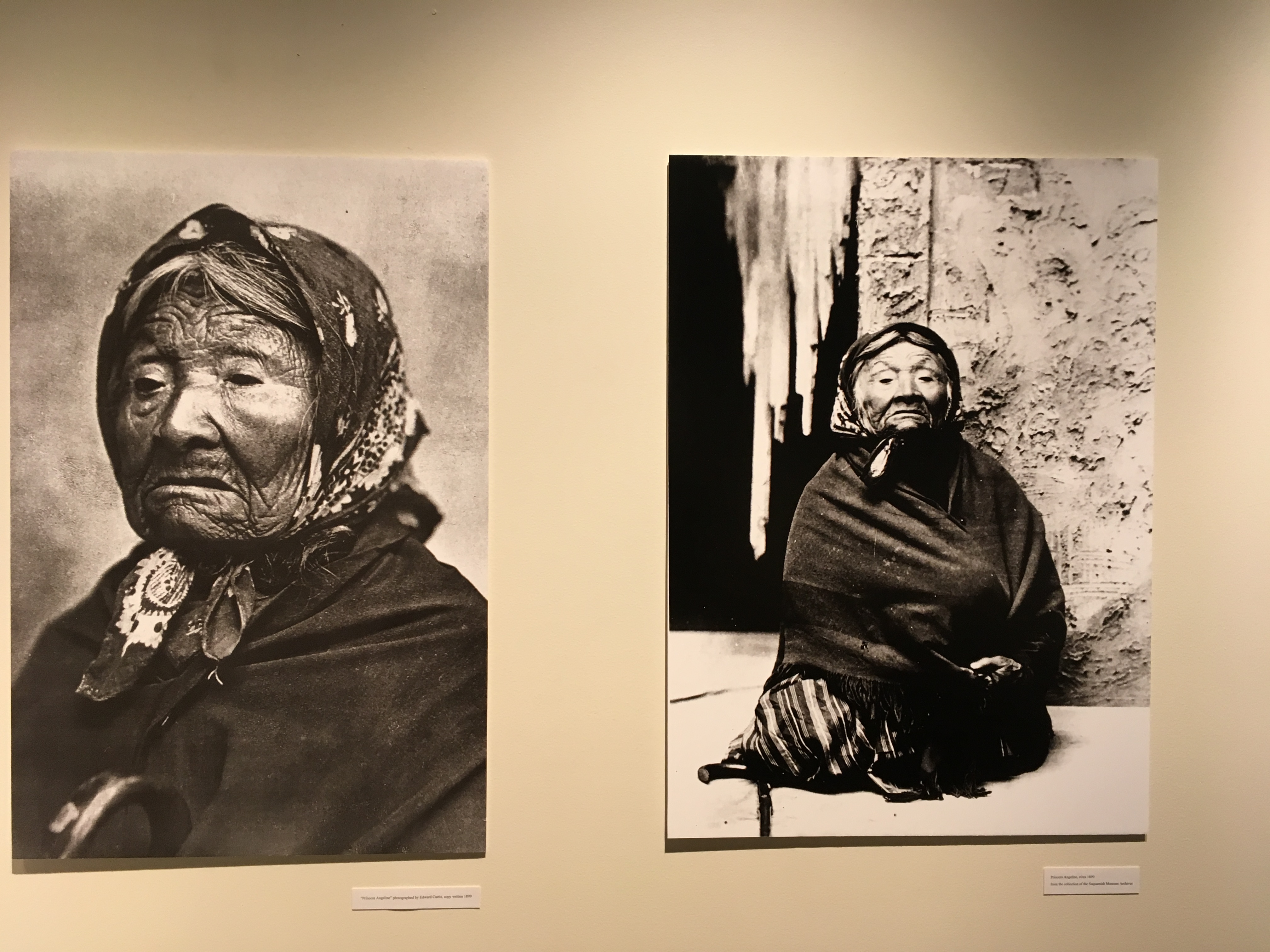
Princess Angeline, Chief Seattle’s Daughter who refused to leave her home. Edward Curtis photograph on left and Suquamish photograph on right. She frequently posed for Curtis around Seattle in his early career.
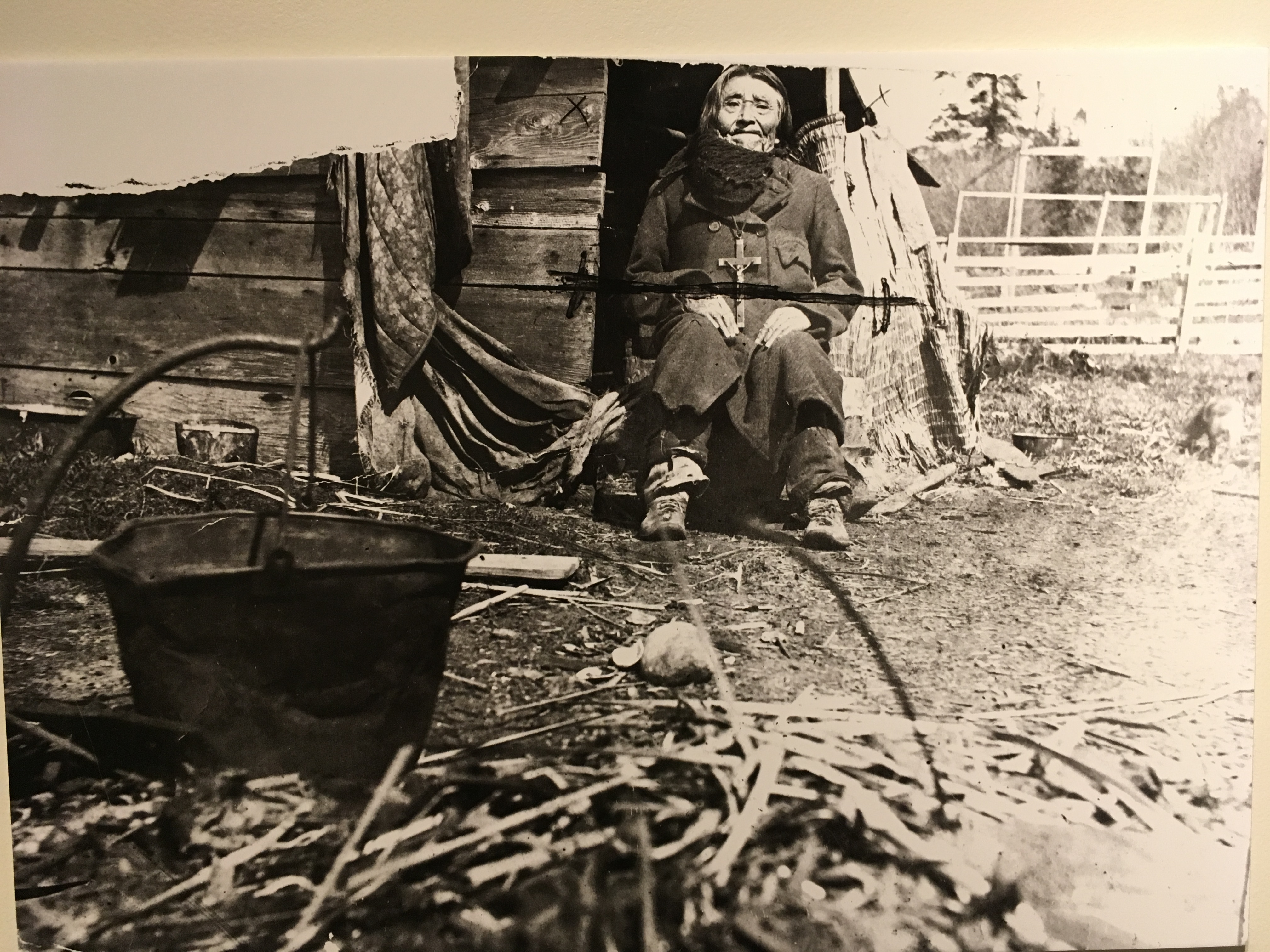
Jacob Wahalcu
In one case Wahalcu, we read Curtis detailed description of his spiritual journey quest. Wahalcu helped Curtis as an ethnographer. He must have trusted Curtis to tell him this story in such detail. Curtis writing and photography both veered wildly between sincere and absurdly racist.
Next we were fortunate to see a stop on this year’s annual Native canoe journey. In Neah Bay we saw three canoes
( two were identified, Quinault and Chehalis) and the participants gathered for a supper on the shore.
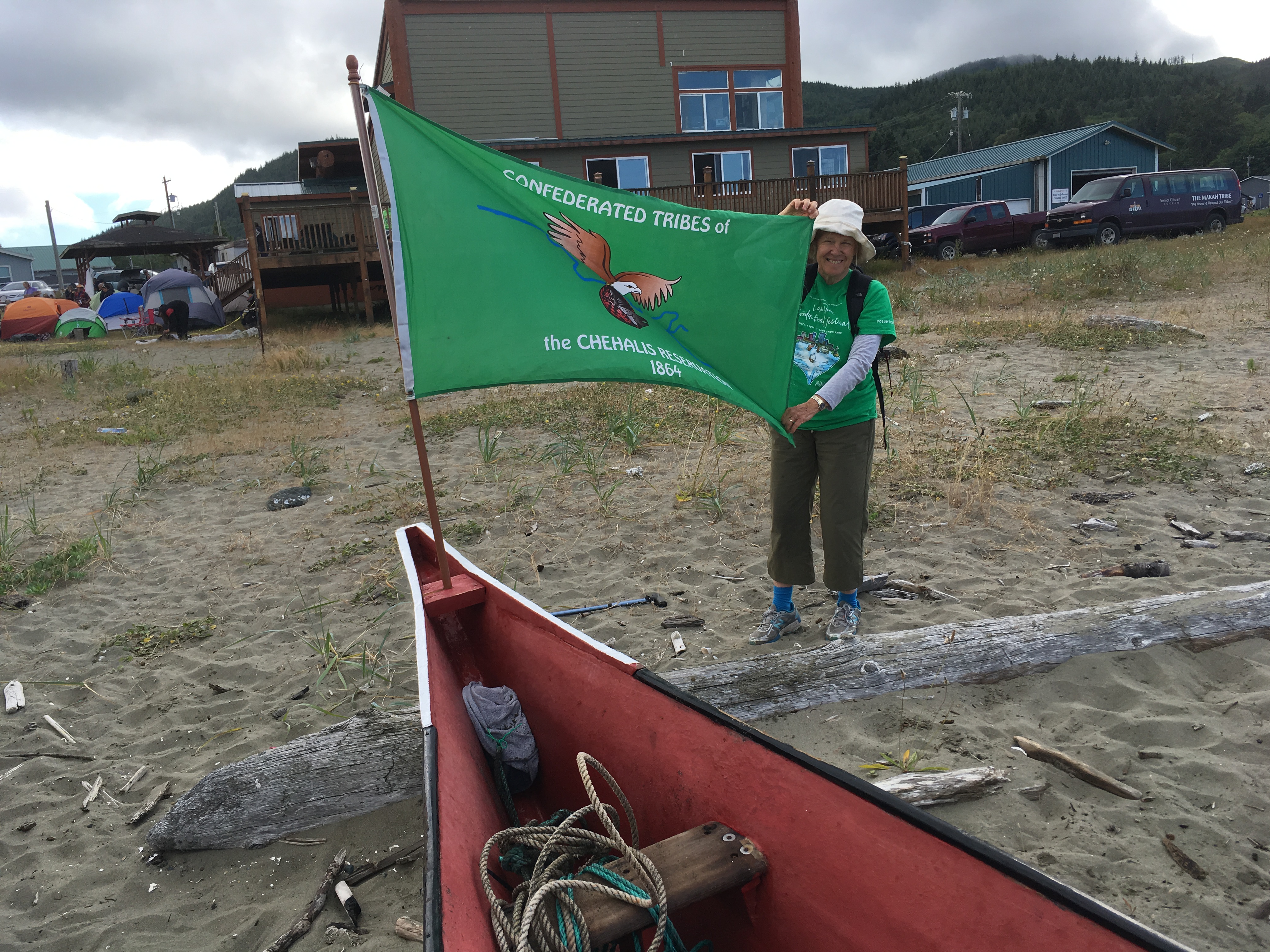
Confederate Tribes of Chehalis
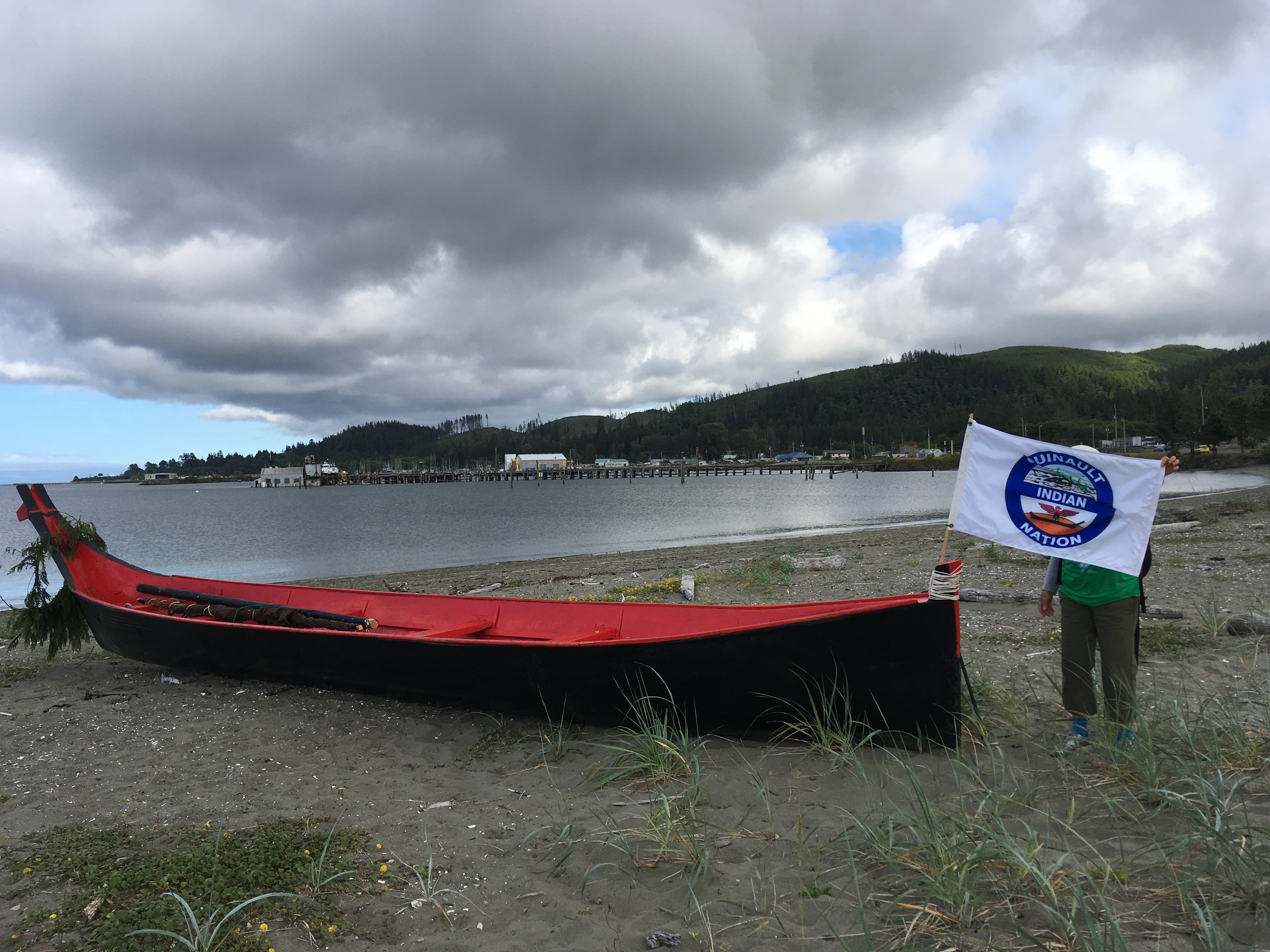
Quinault Indian Nation
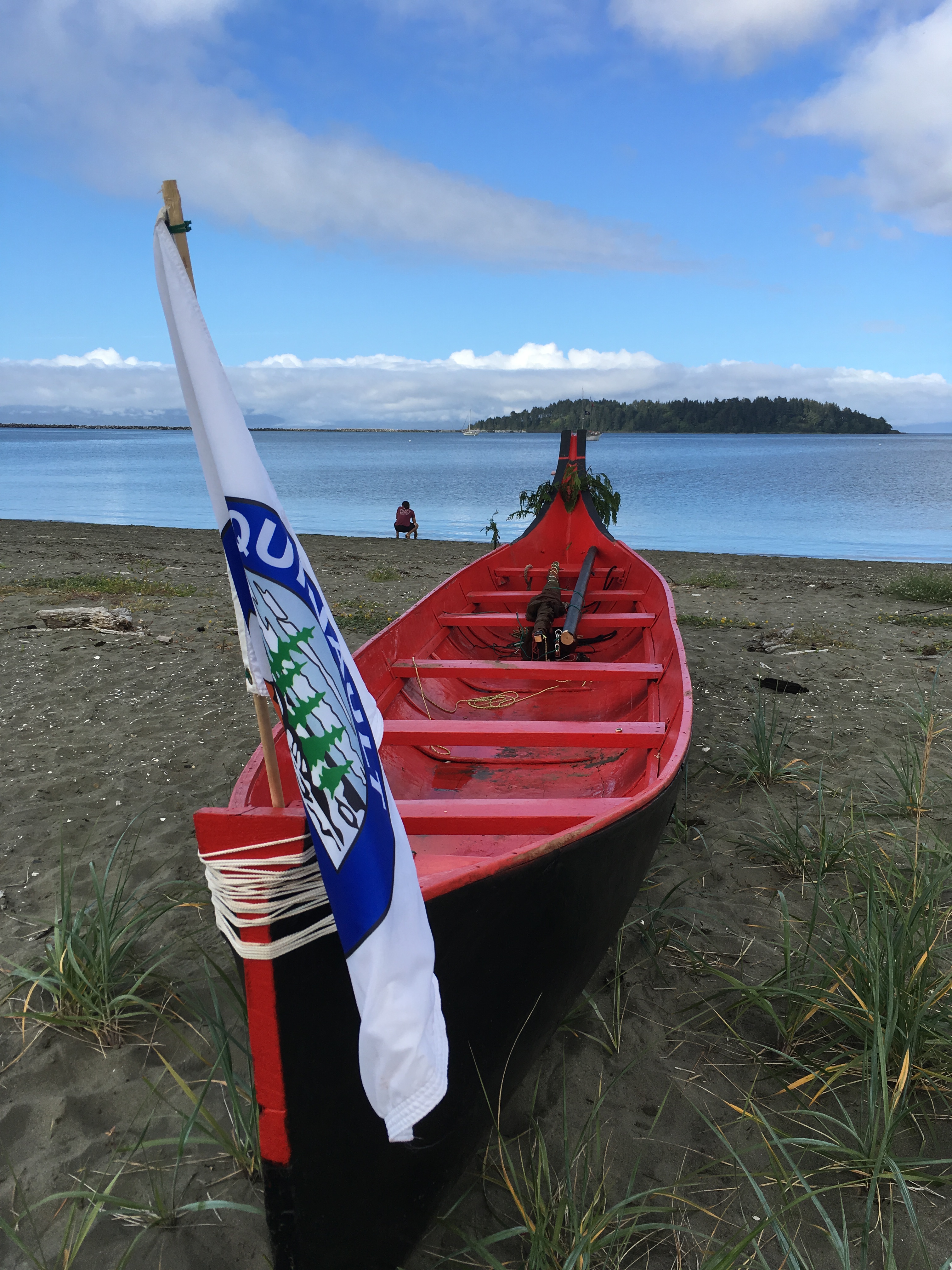

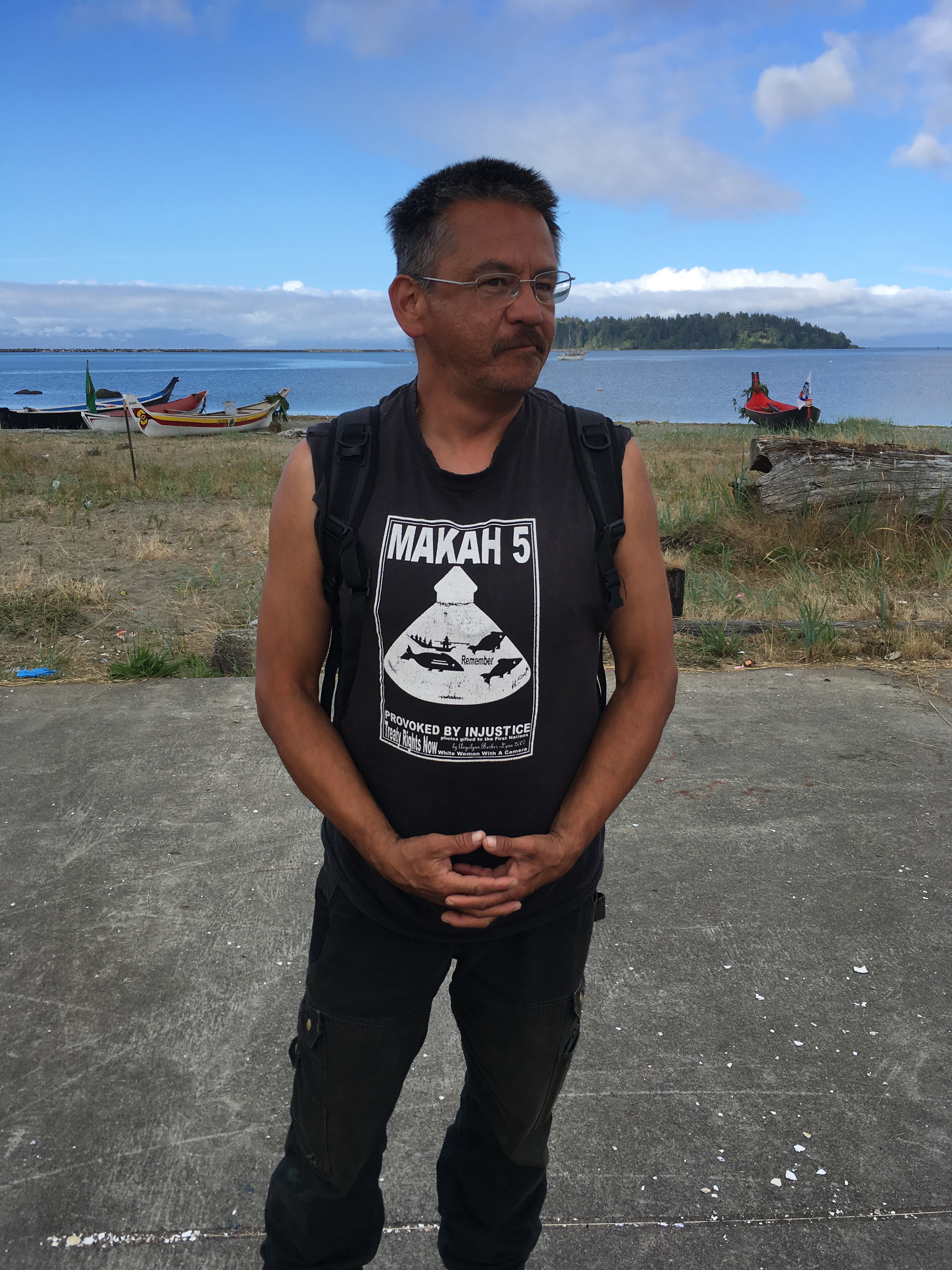

All the canoes will eventually gather in Puyallup in early August. Here is part of the statement from that tribal leader Bill Sterud
“120 canoes and dozens of tribes to our shores as we celebrate
the theme of Honoring our Medicine. Our elders have always taught us that water is a powerful medicine—a life-giving force that sustains, heals, and protects us. And as we see with Canoe Journey,
where more than 15,000 will gather on our shores to greet the canoes, the water also provides connection between Native peoples and the land. ”
“The Puyallup Tribe is one of the most urban reservations in the country. We know intimately the effects of industry and development on our culture. So we must balance city living with the need to protect the way of life our ancestors practiced before freeways and industry transformed our land. Coast Salish
tribes have always moved through the region along the water, and we are dedicated to practicing this
ancient tradition. Reclaiming our traditions is a commitment we practice every day to make sure that
our children, and their children, can enjoy these waters after we are gone.
Today, the tips of our canoes touch the sand of beaches polluted by chemicals from upstream contamination. These same pollutants poison our tide flats and seep into our shellfish beds. Just like
tribes across the nation, we live with the result of declining fish supply as salmon habitat gets degraded and salmon passage is blocked by roads. With every new development, like the Liquid Natural Gas plant, we are faced with a battle to protect our waters, our life force, and our medicine. ”
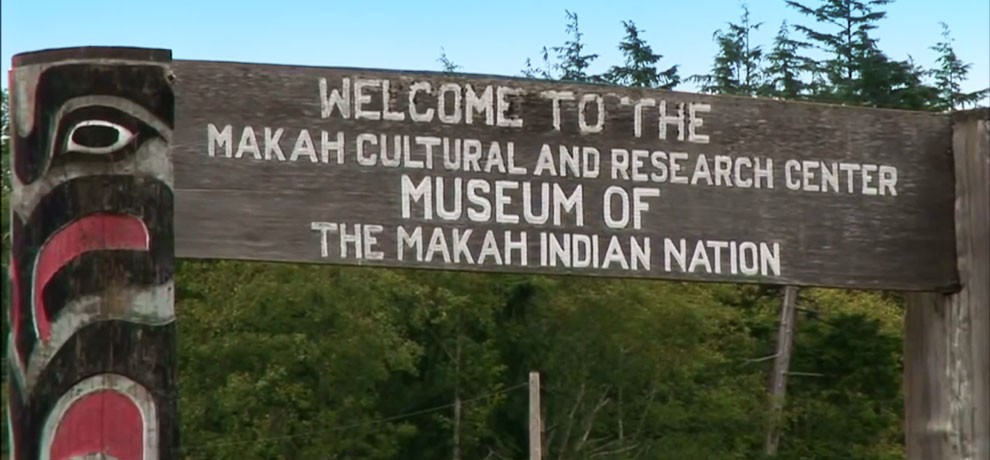
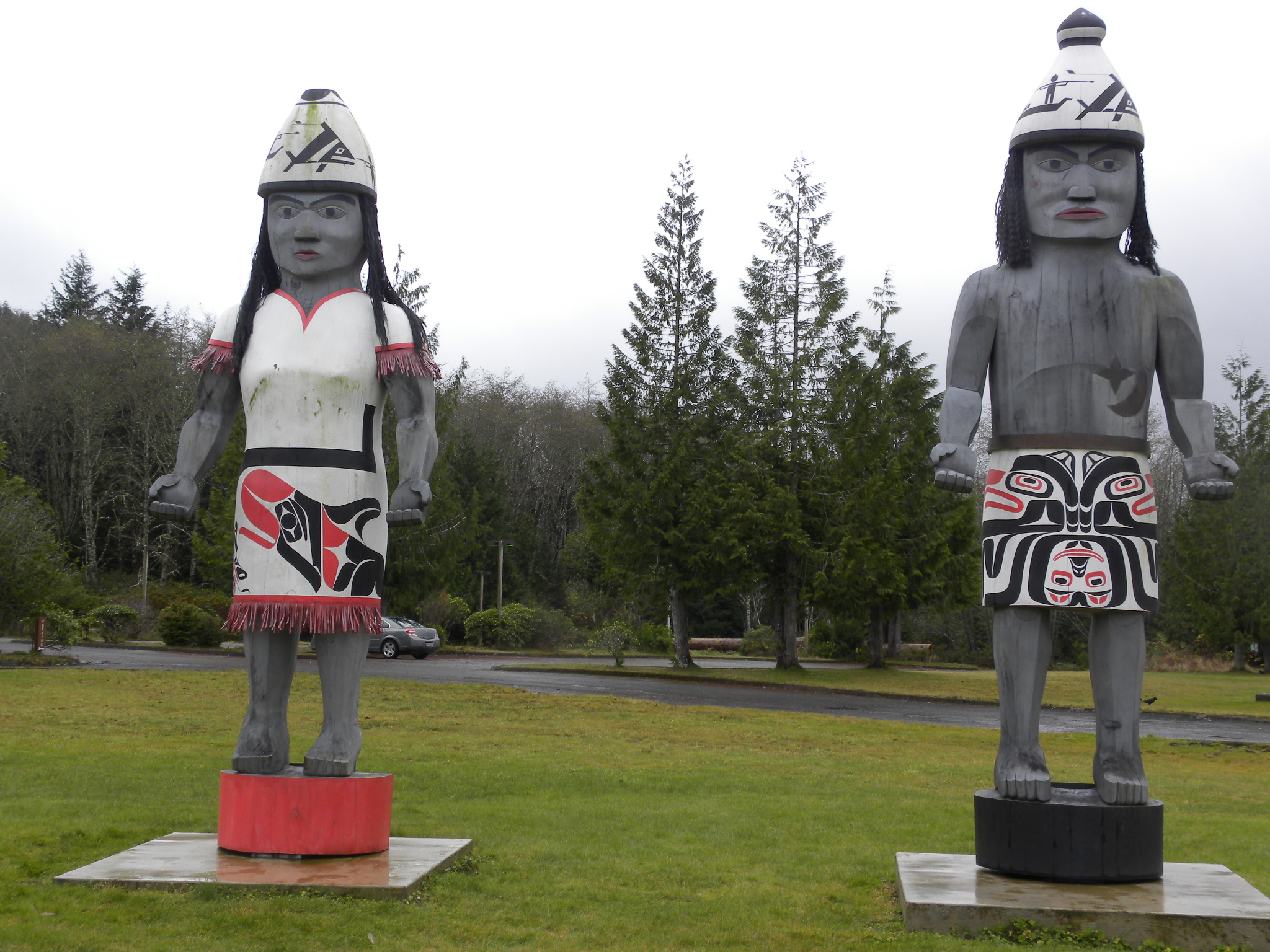

We also visited the amazing Makah museum, with its artifacts from the Ozette Archeological Site. These artifacts, exposed by a storm in 1970 after being buried in a mud flow for hundreds of years, demonstrated that the Makah have been here for more than 4000 years.
The piece of net discovered at Ozette enabled all the Northwest Indian tribes to argue that net fishing is traditional and therefore they can continue to practice it. In addition we saw tools made of many kinds of wood, each suited to its purpose,cedar,alder, hemlock, yew, preserved by the mud, fishhooks (metal from Japanese ships), bear and antler bones, stone technology, shells, cedar plank houses ( a large scale model), whaling spears, They were master whalers and so much more. They had canoes with sails.
We have been to this museum before in November 2011, but it is reinstalled with excellent labels.
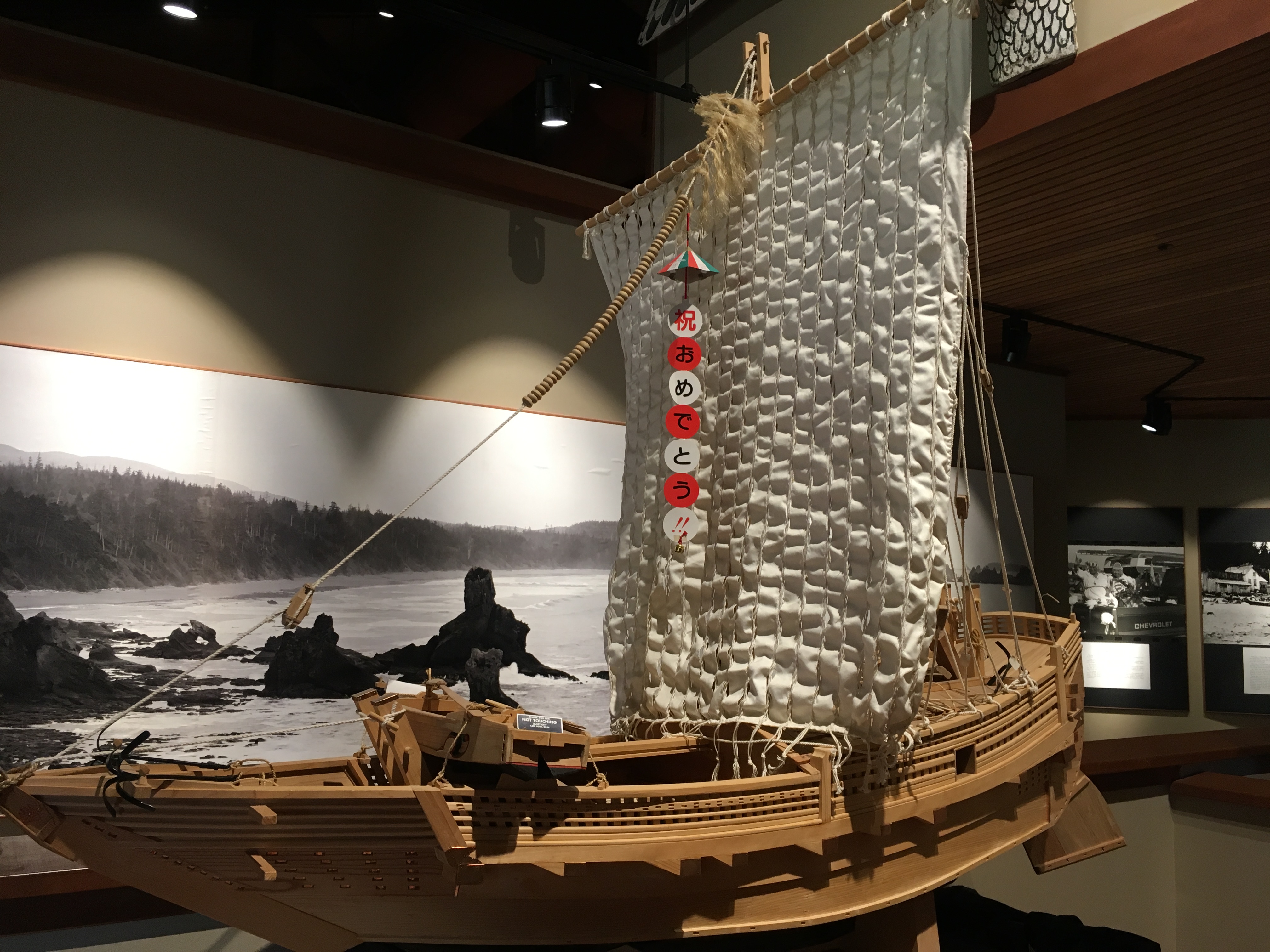
Also, the Japanese sent a model of the boat in 2006 that shipwrecked off the coast in 1832. The boat was a thank you to the Makah who saved the three surviving sailors. The sail was amazing. I have never seen a sail like this before.
Our third native cultural experience was in La Push with the Quilieute. They so happened to be celebrating Quilieult Days, and on the evening we were there after our hike to the beach we discovered they were celebrating Royalty at the high school gym. When we went there we learned that the Royalty were the children, the Queen and Warrior were the oldest: the children included age groups from 11-15, 6-10 and birth to 5. It was fabulous. Several of them gave short speeches about their strong sense of community and family. One performed a dance with a mask.

Dance by Princess age about 12

Princess and Warrior Age 6-10

Tiny Tot Princess and Warrior, Birth – 5


The Warrior and Queen
This entry was posted on July 26, 2018 and is filed under indians, Indigenous activism, Indigenous Art, Uncategorized.


